

PARADISE
Home Sweet Loan

Get our fixed interest rate of 4.99% guaranteed for a year on new and refinanced loans
Reach out to one of our home loan specialists today at: contactus@creditbank.com.pg | creditbank.com.pg PLUS! Approved loans come with a CreditBank PNG Visa Credit Card with a K5,000 limit for use wherever Visa is accepted.
PARADISE
Paradise is the complimentary in-flight magazine of Air Niugini, Papua New Guinea’s international airline. The magazine is published by Business Advantage International.
BUSINESS ADVANTAGE INTERNATIONAL
PUBLISHING DIRECTOR
Andrew Wilkins
COMMERCIAL DIRECTOR
Robert Hamilton-Jones
ADVERTISING WITH US
Paradise is distributed in-seat on all Air Niugini international flights and selected domestic services. Additional circulation includes hotels, cafes and corporate offices in PNG. It is the country’s most-read magazine. To find out how to be seen in the magazine, contact our Advertising Sales Manager Robbie Milne @ rm@businessadvantageinternational.com

Business Advantage International Pty Ltd businessadvantageinternational.com
CORRESPONDENCE TO THE AIRLINE
The Chief Executive Officer
Air Niugini
PO Box 7186, Boroko, NCD, Papua New Guinea Tel +675 327 3498 Fax +675 327 3550
EDITOR
Robert Upe
STAFF WRITERS
Charlotte Armstrong, Nadav Shemer Shlezinger CONTRIBUTORS
Richard Andrews, John Brooksbank, Paul Chai, Stefan Danilchenko, Mike Dilger, Bronwen Gora, Belinda Jackson, Lennox Matainaho, Kirstin McGavin, Rocky Roe, David Soroda, Mary Tao, Paige Turner
AIR NIUGINI EDITORIAL CONSULTANT
Illan Kaprangi
DESIGN
Alicia Freile, Jodie Horne PROOFREADER
Sally Woollett
Editorial inquiries paradise@businessadvantageinternational.com airniuginiparadise.com
Printed in Australia. Both printer and paper manufacturer for this publication are accredited to ISO14001, the internationally recognised standard for environmental management. This publication is printed using vegetable inks and the stock is elemental chlorine free and manufactured using sustainable forestry practices.
Some of the articles in this publication are edited versions of those first published on the online PNG business magazine, businessadvantagepng.com.
Unsolicited manuscripts, artwork, transparencies and photographs are submitted at the sender’s risk. While all care will be taken, neither the publishers nor the airline will accept responsibility for accidental loss or damage. No part of this publication may be reproduced without the written permission of the publisher. Statements, opinions and points of view expressed by the writers are their own and do not necessarily represent those of the publisher, editor, or the airline. Information contained in this publication may be correct only at the time it was originally obtained by the writers and may be subject to change at any time and without notice. © Copyright. 2025. All rights reserved.

TOUGHEST IN PNG
Built to conquer the wild. From muddy mountain climbs to coastal river crossings — the Ford Raptor is made for PNG. Available in both diesel and petrol, with next-gen suspension, twin-turbo power, and unmatched off-road control, this is more than a ute — it’s a weapon.
When the terrain gets tougher, the Raptor gets meaner.
2025 Innovation PNG Award Recipient
2025 Innovation PNG Award
For the use of Arti cial Intelligence (AI) to automate the processing of invoices from suppliers.
For the use of Artificial Intelligence (AI) to automate the processing of invoices from suppliers.


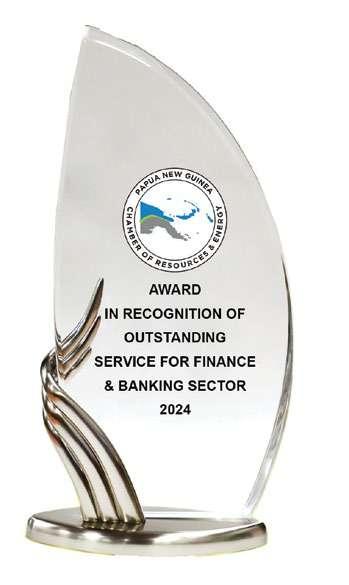

2024 PNG CORE Award Recipient
FOR
& BANKING SECTOR
SECTOR


TRAVELLER
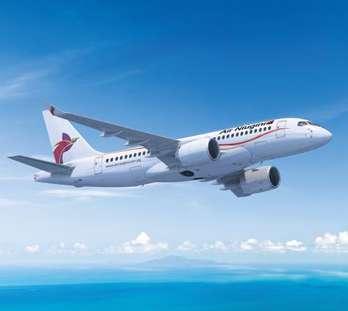

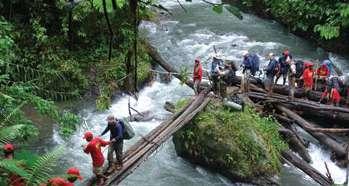
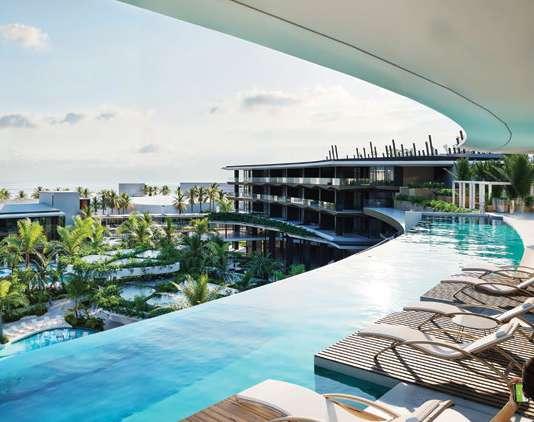
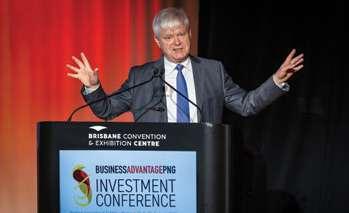


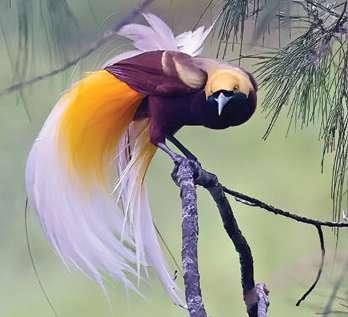


Message from the Chairman

Welcome aboard

Dear valued passengers, on behalf of the Air Niugini Board, management and staff thank you for choosing to travel with us. As Papua New Guinea’s national carrier, it is our privilege to connect you with the people and places most important to you.
As we approach the end of 2025 and look ahead to a new year, I would like to express my heartfelt gratitude to you – our loyal customers, dedicated employees, and trusted partners. Your ongoing support inspires us and underpins Air Niugini’s continued progress.
This year has marked a period of transformation and innovation for Air Niugini. In September, we proudly introduced our first Airbus A220-300 to the fleet, the first of 11 new A220s and two Boeing 787 Dreamliners to come. This represents the largest and most significant investment in our airline’s history, demonstrating the commitment of Air Niugini and the PNG government to delivering a superior, modern travel experience.
Why the Airbus A220? It is simply the right fit for PNG – its advanced technology, fuel efficiency, and performance ensure safe, reliable service across our challenging and diverse domestic network. Passengers can look forward to quieter cabins, wider seats, and modern comforts on every flight.
The Boeing 787 Dreamliners will enable us to grow our international services, opening new routes and connecting PNG to key global destinations. This investment positions Air Niugini as a bridge not only within PNG, but between our nation and the world.
There is no better time to embrace these new beginnings as we celebrate PNG’s 50th independence anniversary. In this edition of Paradise, we honour the unity, resilience, and achievements of our nation since 1975. You will find stories celebrating our vibrant culture – from traditional ceremonies and cultural showcases – to profiles of pioneers and innovators shaping PNG’s future.
We also have stories that celebrate our people and progress –from the grand flag-raising ceremony in Port Moresby, attended by thousands in red, black and gold, to Australia’s pledge to help construct a new ministerial wing of our National Parliament, symbolising our enduring friendship under the banner of yumi stap wantaim – standing side by side.
We journey into PNG’s cultural heart, exploring the ancient art of shark calling in New Ireland, the spectacular Goroka Show, and the living traditions that make PNG one of the world’s richest cultural landscapes. For thrill-seekers, we highlight 10 unforgettable adventures from volcano hikes to the Tufi fjords, the surf breaks of Vanimo and wildlife encounters along the Sepik.
Our feature on eco-tourism invites you into the lush rainforests in search of our national icon – the bird of paradise – with over 30 species found nowhere else on earth. We honour Saint Peter To Rot, PNG’s first saint and a symbol of faith and courage, and celebrate innovation in education, with over 6000 refurbished computers now supporting 350 schools across the country.
We also shine a spotlight on our people: national icons, inspirational women in mining and sports, and the next generation of leaders.
At Air Niugini, safety remains our highest priority. We are committed to delivering the highest standards across every touchpoint – from our enhanced fleet and attentive service to our focus on punctuality and reliability.
Thank you once again for flying with Air Niugini. Whether you are a first-time visitor or a frequent flyer, we are honored to serve you. We look forward to welcoming you onboard many more times as we chart a course toward a brighter, more connected future – together.
Wishing you safe travels, and a joyful 50th independence anniversary.
Warm regards.
Karl Yalo Chairman, Air Niugini Board

WE’RE NOT JUST YOUR BANK. WE’RE YOUR PARTNER FOR LIFE.
In community, in business, and in life, we’re with you, building stronger futures together.
Proud to have walked alongside Papua New Guinea through 50 years of independence, and 115 years of shared progress.
DEPARTURE LOUNGE
NEWS, BRIEFINGS, LOCAL KNOWLEDGE
PARADISE Q&A JULIAN HENAO
Chef Julz, as he is best known, has worked in top restaurants around the world, appears on TV and has even cooked for the Pope. Robert Hamilton-Jones pops into his venue Locker Room at the Santos National Football Stadium for a healthy ‘bowl’ lunch and a chat to the celebrity chef about his latest ventures and the local food scene.
Q: You have championed healthy eating in PNG for several years. Is your message getting through?
A: I think people are starting to realise what amazing fresh ingredients PNG has, especially from the Highlands. I started the Healthy Food Co in 2018 to cater to the growing demand for healthy meals and now work with charities like Buk Bilong Pikinini to promote nutritional education to parents and kids. I also see huge untapped potential in sports nutrition in PNG. Papua New Guineans have quickly realised the importance of eating healthy, resulting in a positive movement that’s picking up momentum.
Q: Do you have any big influences from the wider culinary world?
A: My aim is always to get the best ingredients and then keep things simple. I really admire Tom Kitchen (@tom_kitchen) from Leith in Scotland and JP Anglo (@chefjayps), who has done a great job in promoting Filipino food worldwide and Adam Byatt (@adambyatt) who is a creative and accomplished Michelin star chef championing British food.
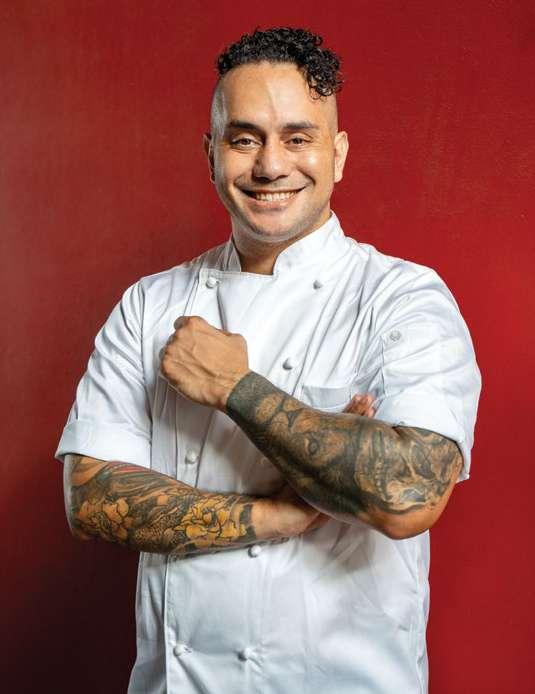
Q: What’s your take on the current dining scene in Port Moresby?
A: The dining scene is becoming competitive. We have a cool cafe scene now with more coffee shops. Furthermore,
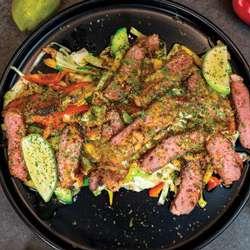
which they impart on our local chefs. POM has some awesome Asian restaurants as well. The increasing influence of social media is adding a positive effect to the evolution of PNG food with young chefs interpreting the classics. Great to see.
Q: Have you got any favourite places around town?
A: Besides the Locker Room, I like the coffee at Duffy, Edge and Bakeology. All three are doing some great things. I went to a great new Thai place recently called Sidaam; the flavours transport you to Thailand.
Q: Given your reputation, our Port Moresby readers will be excited to hear they can now hire you to cater their own event.
hotels are focusing their menus on local produce, which is cool. The influence of expatriate chefs in our restaurant industry is having a positive effect on local chefs too. They bring their own ideas/creativity and training,
A: Yes, the Catering Co was launched about a year ago. We do everything from the French Embassy’s Bastille Day celebrations at the Marriott to boardroom catering and fine dining events at people’s own residence. n
Chef Julz and a plate from his kitchen.
PICTURES: CHEF JULZ
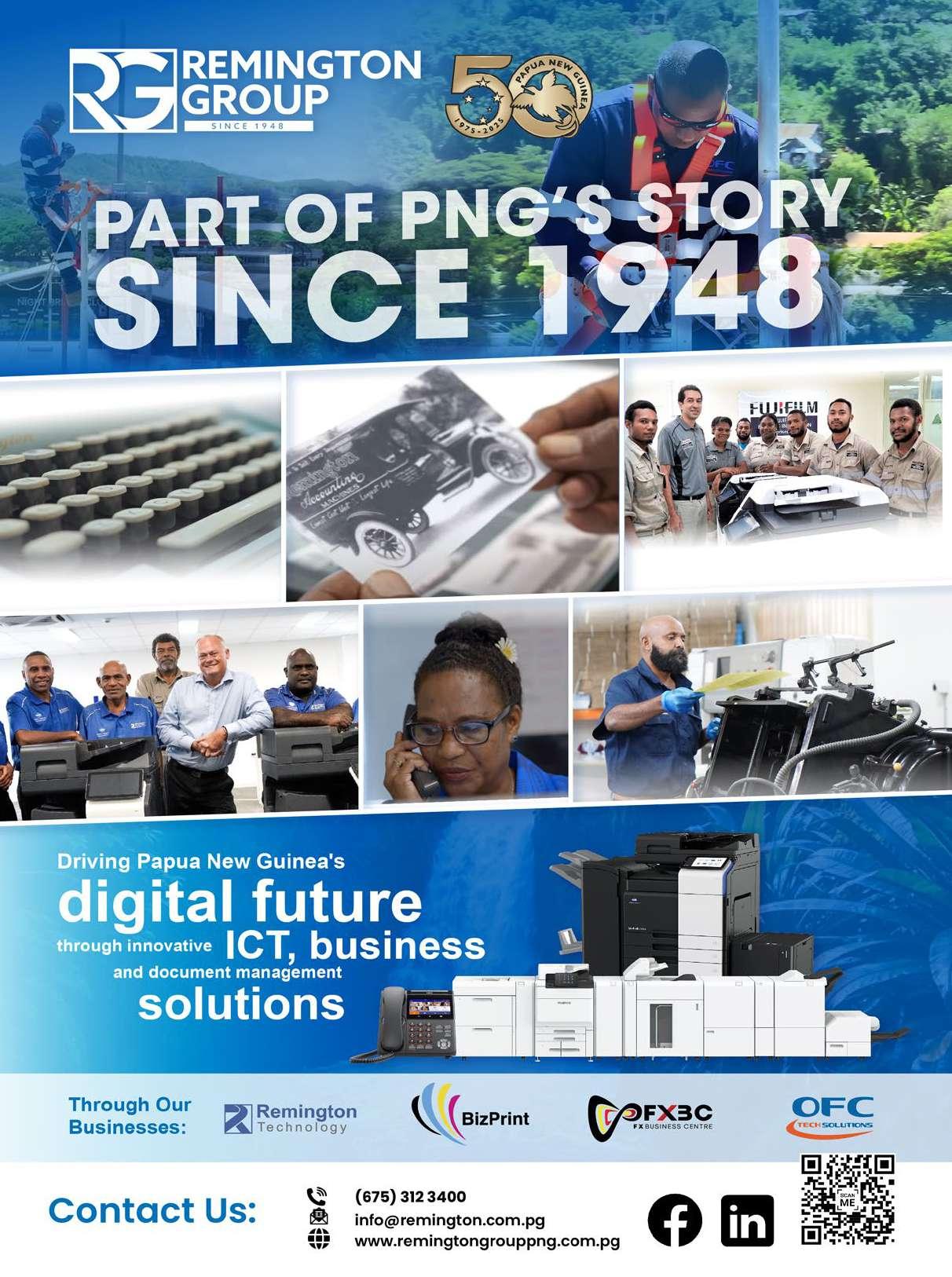
Australia pledges support for new wing of parliament
As part of the celebrations of 50 years of Papua New Guinea’s independence, Australia has pledged support for the construction of a new ministerial wing for PNG’s National Parliament in Port Moresby.
Construction will follow a Papua New Guinea-led design and consultation process and draw on local craftsmanship and expertise.
This pledge recognises the common understanding of the democratic principles that underpin the modern Australia–PNG relationship, and the role of both parliaments in reflecting the voices of the people.
The concept of yumi stap wantaim – sideby-side, step-by-step – will be incorporated into the design of the new wing.
In January 2023, the Australian Prime Minister Anthony Albanese became the first foreign leader to address the PNG National Parliament.
Just over a year later, in February 2024, PNG’s Prime Minister James Marape was the first Pacific leader to address both members and senators in the Australian Parliament.
Prime Minister Albanese said: “Our support for the expansion of Parliament House is an investment in Papua New Guinea’s democracy and sovereignty that will benefit future generations. As close neighbours and warm friends, the future prosperity of our two nations are bound together.” n
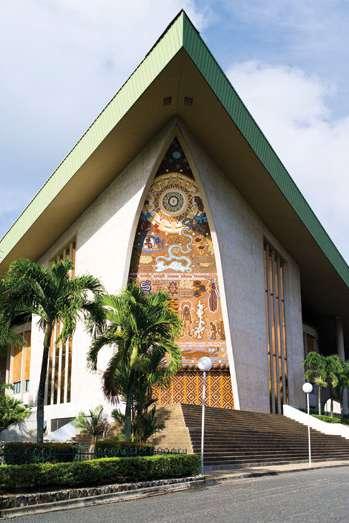

PNG’s National Parliament building in Port Moresby.
PICTURE:
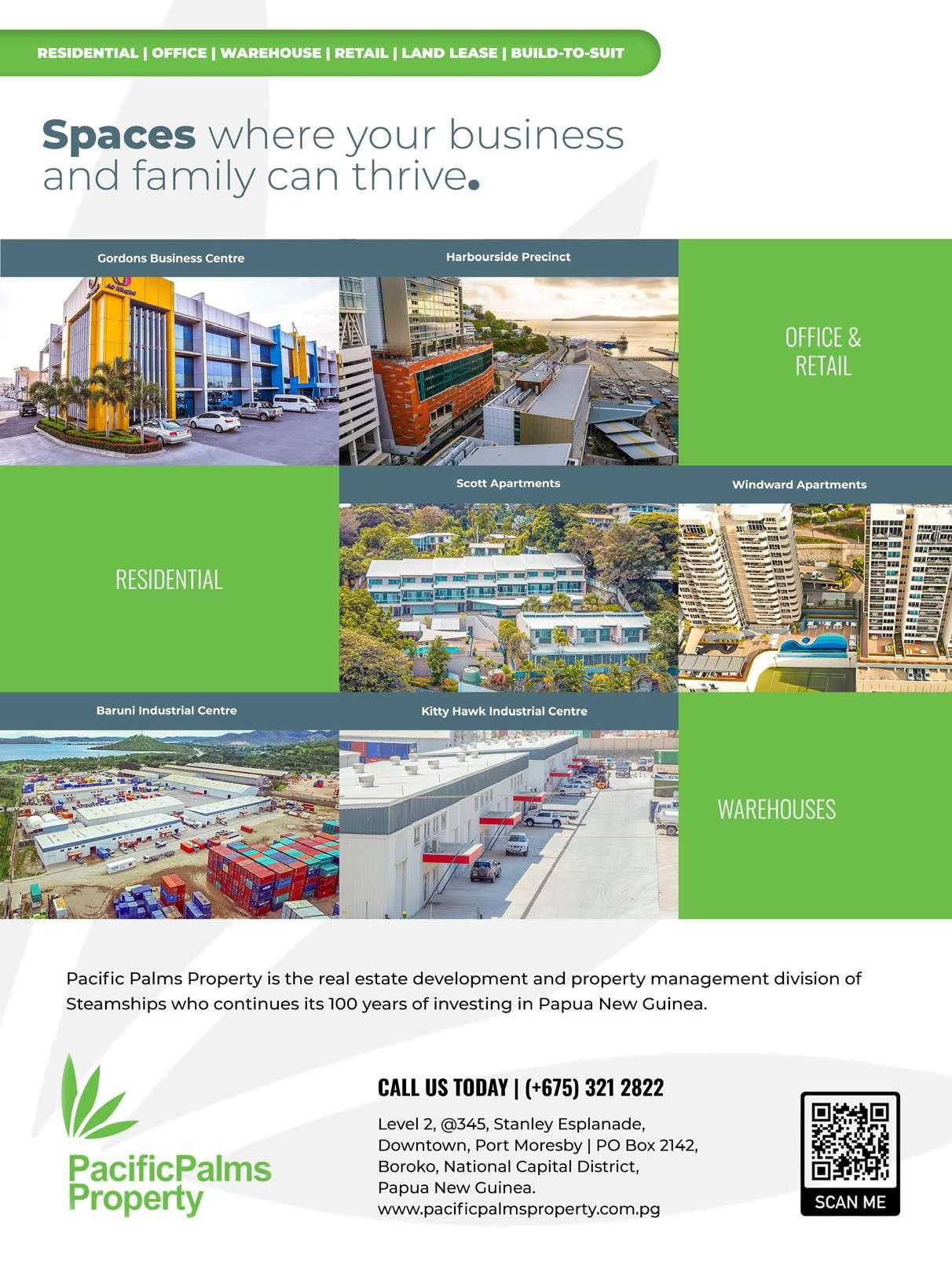
PNG sprinter competes against the world’s best in Tokyo
Sprinter Tovetuna ‘Tim’ Tuna ran in the 200 metres at the recent World Athletics Championships in Tokyo, Japan. He finished ninth in a heat that also included Australian teen star Gout Gout.
It rounds off a breakthrough year for the 22-year-old, who set Papua New Guinean national records for both the 200 metres (20.64 seconds) and 100 metres (10.24 seconds) on the same day in May.
Tuna has been enrolled at college in the US since August last year, where he has been benefiting from access to top-
It rounds off a breakthrough year for the 22-year-old, who set PNG national records for both the 200 metres and 100 metres.
class facilities, coaching and competition.
He only started running competitively in 2022 after playing rugby through his teens, but he certainly has the pedigree. His father, Takale Tuna, broke the same 200-metres record more than 30 years ago and competed in the 1988 Olympics in Seoul.
Tuna hopes to emulate that feat in Los Angeles in 2028, by which time those national records could be considerably lower.
The World Athletics Championships were in Tokyo in September and included about

2000 athletes from 200 countries competing in 49 events. It’s the 20th time the championships have been held. The championships will next be held in Beijing, China, in 2027. n

Tovetuna Tuna at the World Athletics Championships in Tokyo.
Living treasure award for PNG writer
Prolific Papua New Guinean author
Daniel Kumbon has built an invaluable personal library of records chronicling his life from 1958 when he was a child growing up in Kandep, Enga Province.
This has culminated in Kumbon’s 10th book, a memoir titled They Chose Peace.

It is because of his excellent recordkeeping and meaningful storytelling that the judges of the First Nations Writers Festival (FNWF) in Townsville recently awarded him the Living Treasure Award.
The FNWF is an Australianbased platform for indigenous writers in Australia, PNG, Timor Leste, West Papua and the Pacific. Every year, selected book manuscripts and short stories are published, providing an opportunity for authors to have their work in print.
Kumbon, who has previously contributed to Paradise, has used his recollections and articles from his time as a journalist to produce a raw and honest commentary on PNG’s transition from pre-independence to present time.
He highlights the importance of peace, particularly in Enga, where he was personally affected by tribal warfare.
“My life has been about promoting literature, encouraging people to read and write, and promoting peace,” he says.
He says the core message of his latest book is that PNG’s young people must understand their past in order to stand firm and navigate the future. “Fighting is bad, that is not the answer. They must work hard to develop our country,” he says.
They Chose Peace is available at firstnationswritersfestival.org, the University of PNG bookshop, Ribito Grill & Restaurant in Port Moresby, and at Ribito Hotel in Wabag for about PGK130. n
– MARY TAO
For book reviews, go to page 110.

The cover of Daniel Kumbon’s latest book.
MAJOR UPGRADE FOR CAIRNS AIRPORT
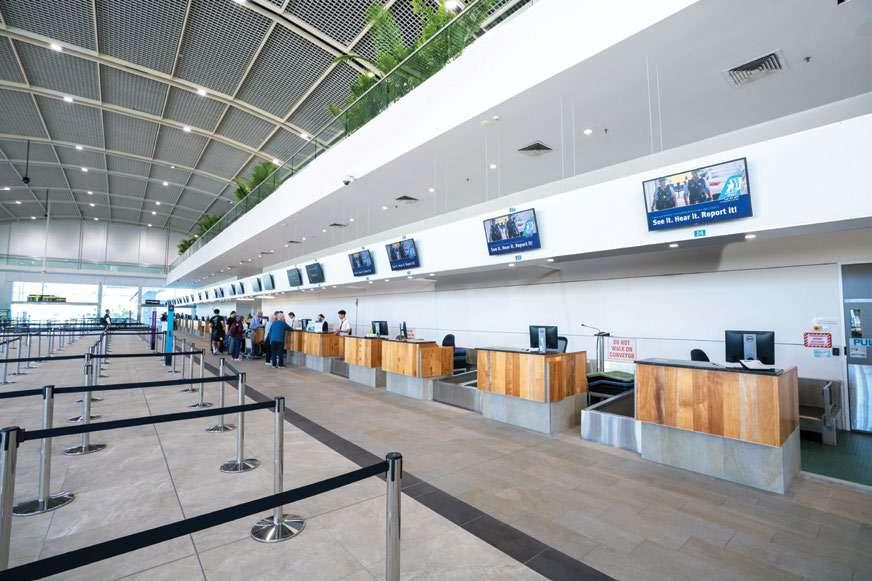
Air Niugini passengers are set to benefit from an A$55 million (PGK148 million) redevelopment of the international terminal at Cairns Airport.
This is the first major upgrade of the building since it opened more than 30 years ago.
The redevelopment includes refurbishment of the check-in area, the departures lounge and arrivals hall, plus remodelled bathrooms, new elevators and escalators, new air-conditioned glass aerobridges, new comfortable and modern furniture and two new baggage reclaim belts.
There are also improvements to the technology used for security screening, and dining and retail offerings have been enhanced. Local plants have been integrated into the redevelopment to boost the terminal’s tropical atmosphere.
The project is due for completion at the end of 2025.
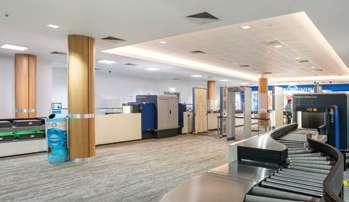
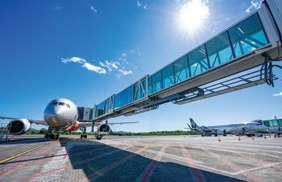

The revamped international terminal at Cairns, including a new air-conditioned glass aerobridge.
The terminal has been transformed into a contemporary space.
Cairns Airport Chief Executive Officer Richard Barker says: “This project has been driven by our commitment to improve the customer journey from the moment they enter Cairns Airport.
“We have combined a major infrastructure program with design-focused interior enhancements. The terminal has been transformed into a contemporary space that reflects the dynamic atmosphere of our region, while also recognising our unique environment and rich culture.
“Each baggage reclaim belt effectively doubles the number of items that can flow out to passengers after they arrive. We know it can be frustrating waiting for luggage after a long flight, and we work closely with airlines and ground handling partners to continually improve this part of the journey.”
Cairns Airport is one of Australia’s leading regional airports, servicing an extensive network of international and domestic routes, including critical links to remote communities.
The airport is Australia’s seventh busiest for passenger movements, welcoming five million passengers per year and handling around 130,000 aircraft.
Air Niugini currently flies from Port Moresby to Cairns nine times a week.
See airniugini.com.pg and cairnsairport.com.au.
ANCHORING PROGRESS ON PAPUA NEW GUINEAN TALENT
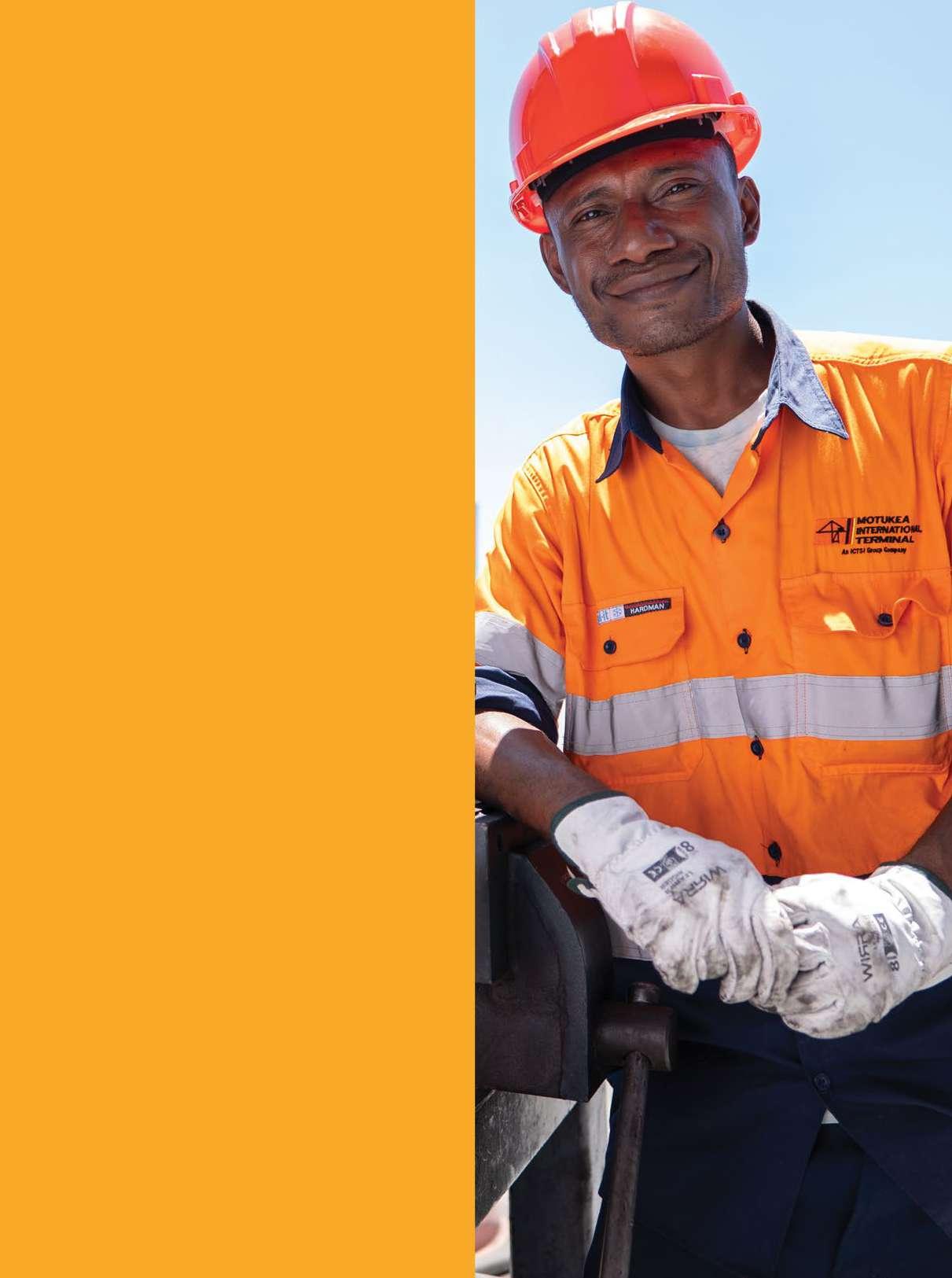
Papua New Guinean port equipment operators and engineers play a vital role at the terminals of Lae and Port Moresby, putting to good use their expertise in ship-to-shore cranes and mobile harbor crane operations and maintenance.
Through ICTSI South Pacific’s Center of Excellence program and guidance from international experts, local talent continues to grow, powering PNG’s trade gateways and contributing to economic development. The collaboration has come full circle, with PNG operators and engineers now training their counterparts overseas—an inspiring example of knowledge-sharing and mutual growth.
ICTSI South Pacific – developing skills, driving progress.


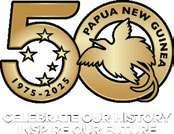
South Pacific International Container Terminal Lae, Morobe Province
Motukea International Terminal Motukea Island, Port Moresby
Fashion designer sets up shop in Lae
Fashion designer Annette
Sete is known for her fresh take on Papua New Guinean motifs and patterns that are made into colourful fabrics under her brand Lavagirl. Her bestselling tabu design, a print of the traditional shell money of the Tolai people of East New Britain, has been used by many tailors across the country to make the national dress, the meri blouse.
“We want to be a storyteller of our cultures in our fabric designs. We want all our customers to be able to retell those stories when they wear our fabrics and when anyone asks them about it,” says Sete.
Sete has made fabrics accessible through her chain of shops called Maku Gifts (facebook.com/ makugifts). Her new shop in Lae is the sixth in PNG. It is in the Central Arcade building, Top Town. Other shops are in Port Moresby, Jacksons Airport, Kokopo, Madang and Mount Hagen.

“Lae had been on our radar for years,” Sete says. “Almost half of our reselling customers are from Lae, and they have been asking
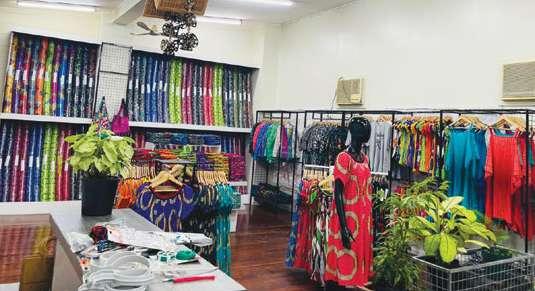
us for years to go there. This year everything fell into place that made it possible for us to finally open in Lae.”
Also available in Sete’s boutiques are resort wear for
both men and women (made from her own fabrics), custom tees and novelty jewellery made from coconut shells and tabu n
– MARY TAO

Annette Sete (inset) and her new shop in Lae (main).

Building Businesses that Build PNG
Located in the heart of Port Moresby’s industrial and investors seamless accessibility through land and sea domestic and global markets.
Measuring 38 hectares of secured prime land that is registered on a clear 99 year state lease, PORTSIDE is envisaged to become a premier economic hub for the
Backed by PNG-based Steamships Limited, an ASX and PNGX listed entity, it will include quality facilities and features designed to cater for the needs of a wide spectrum of organisations.
PORTSIDE Business Park features:
Proximity to Motukea Inter national Wharf
Supporting Retail Spaces
Built-to-Suit Warehouses
Industrial Flex Spaces
Aggregate Storage


BIG PICTURE

This photograph shows a young man from Hela Province, proudly dressed in traditional Huli attire. The Huli are known for their vibrant headdresses, body decorations and unique traditions that are deeply rooted in the highlands of Papua New Guinea. The man was dressed for Highlands Day at Sir Hubert Murray Stadium in Port Moresby in July.
TAKEN BY SHEDRICK KUNJIL
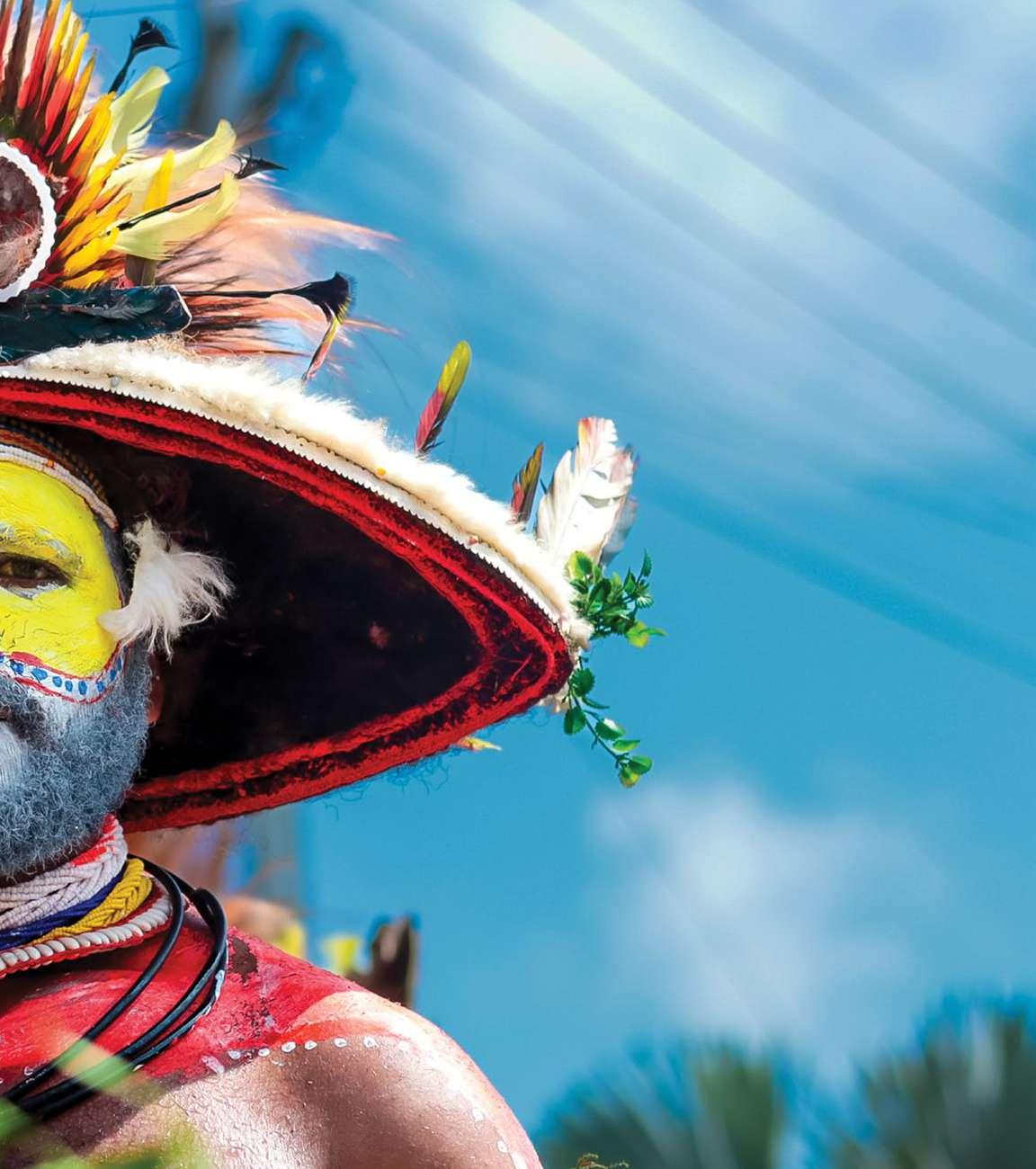
If you have a photo of Papua New Guinea that you’d like published in Paradise , email your submission to paradise@businessadvantageinternational.com. Photos should be at least 1.5mb and 300dpi.
The Kokoda Track - PNG
The Kokoda Track holds a special place in the history of Papua New Guinea as the site of the Kokoda Campaign, a turning point for the Allied forces. The Kokoda Campaign prevented enemy forces from reaching Port Moresby and regaining control of the territory of Papua in 1943.
During this campaign, locals demonstrated immense bravery in guiding the Allied forces to safety, immortalising the ‘fuzzy wuzzy angels,’ and the enduring spirit of mateship and generosity that continues to characterise the relationship between PNG and Australia today.
From connecting communities to Tourism
For the thousands who take up the 96-kilometre challenge, either as a personal pilgrimage, in remembrance of a family member or as a unique travel experience, the Kokoda Track marks a once-in-a-lifetime journey. For the people who live along the Track, the past 50 years have brought many changes.
Seventy-eight-year-old Frank Pupundari from Aurita village in Northern (Oro) Province remembers a simpler time, when there were very few people travelling along what was a bush track.
Born in 1947 on a copra plantation near Oro Bay, Frank was only 15 when he walked for three days to reach Kokoda Station. By the time Independence had
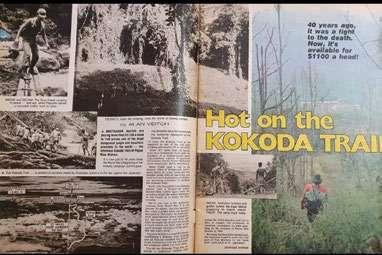
been declared, he was an established ‘Didimen’ (agricultural officer).
“Before the Kokoda track, there were very few people travelling along that road. There was a tractor, a Land Cruiser, and I recall seeing them pave the road by hand. They first cleared the bush using bush knives to create a path and then, using spades, indented a path,” he shares.
“It took us 12 days to walk to Kokoda. There were lots of trees, ridges, mountains and river crossings. There were some good and not-so-good people. We were told they had never encountered a white person before.”
VAGI AMULI
Local European residents such as Soc Kienzle, who grew up at Mamba plantation, just a few minutes’ drive from Kokoda Station, are among the few known to have walked the Track in the 1960s.
Vagi Amuli, who has heritage from both sides of the Track, was born and raised on Mamba plantation and fondly recalls his first trekking experience. “I walked with Mr Soc Kienzle from Port Moresby to Kokoda when I was 13 years old, in 1973,” he says.
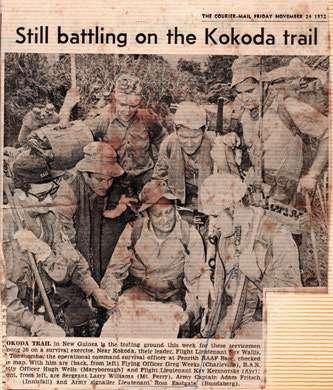
“It took us 12 days to walk to Kokoda. There were lots of trees, ridges, mountains and river crossings. There were some good and not-so-good people. We were told they had never encountered a white person before. That was my first time walking the track, and it was very difficult, but we got to Kokoda station in the end,” he shares.
Now an experienced trekker and tour guide of 25 years, Vagi is amazed at how far the trekking industry has come and credits the Track communities for being so open and welcoming to trekkers every year.
By 1977, a Sydney-based company, Niuginitrek Adventures, was offering a Kokoda trekking package and over 120 Australians had completed their trek by late 1982.
Since then, the industry has seen steady growth, especially after then Australian Prime Minister Paul Keating, kissed the ground at the Kokoda Memorial on Anzac Day in 1992. Annual trekking numbers peaked at around 5,000 in the late 2000s; with recent annual trekking numbers steady at around 3,500 per year.
Preserving the Track
Formed in 2003 to manage the physical Track and regulate the trekking industry, the Kokoda Track Authority (KTA) keeps the Track as safe and accessible for trekkers and the local communities.
KTA rangers stationed along the Track oversee track maintenance, improve operations, liaise with trekking industry agents, and resolve community disputes.
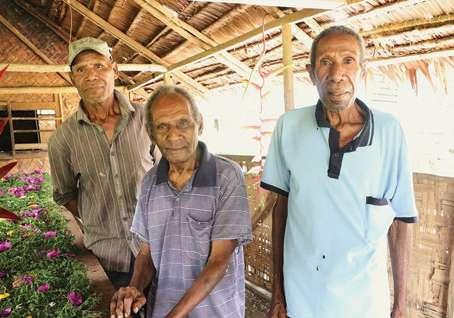
Above: Excerpt from an exclusive feature article inside ‘The Australasian Post’ dated December 16, 1982; entitled “Hot on the Kokoda Trail”
Middle: Excerpt of a story from Australian Newspaper ‘The Courier-Mail’ dated November 24, 1972 and entitled “Still battling on the Kokoda Trail” featuring RAAF training taking place along the Track in the early 1970s
Right: L-R: Vagi Amuli, Frank Pupundari and Apolas Bauba at Iora Creek Village in Oro Province
and Australia, Step by Step
SUBMITTED
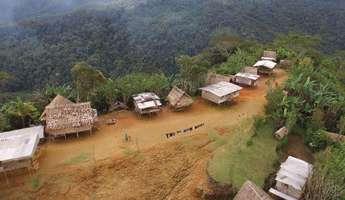
Established in 2008, the Kokoda Initiative (KI) is a partnership between the Papua New Guinean and Australian Governments to sustainably develop the Kokoda Track and protect the surrounding Owen Stanley Ranges.
KTA CEO Julius Wargirai is proud of the role the KTA plays and is thankful for the support of KI partners in advancing a sustainable future for track communities through tourism.
“The region is rich in military and cultural heritage; the environment is pristine. We want to showcase PNG and the Track region to the world, whilst continuing to improve the lives of our local communities,” he said.
Improving service delivery for Track communities
Through the PNG-Australia partnership, KI has partnered with Track communities to improve health, education and livelihood outcomes since 2016.
Annual maternal and child health patrols jointly run with PNG provincial and church partners visit over 90 villages, improving antenatal coverage, childhood

immunisation, family planning access and a decrease in maternal mortality rates in the Track region.
In partnership with provincial education authorities, KI supports more than 200 teachers and 6,000 students across 60 schools. This collaboration has improved learning environments by building 13 double classrooms and 12 teachers’ houses, providing training for all teachers and ensuring schools are stocked with essential learning materials.
The Kokoda Track – a national treasure
The natural beauty and unique military heritage of the Track make it one of PNG’s largest tourism assets.
PNG Tourism Promotion Authority (TPA) Senior Partnership and Industry Liaison Officer, Clare Atava Kolma, maintains TPA’s support to promote tourism along the Kokoda Track
“Future capacity-building initiatives for local tourism operators and associations will strengthen the Kokoda trekking and tourism industry, making it more competitive and sustainable.”
Fifty years on from Independence, the Kokoda Track is a living legacy of the shared history and enduring ties between PNG and Australia.




“The region is rich in military and cultural heritage; the environment is pristine. We want to showcase PNG and the Track region to the world, whilst continuing to improve the lives of our local communities,”
KTA CEO JULIUS WARGIRAI
Left: Allies retake Kokoda, Australian flag raised 3 November 1942 at Kokoda Station. (Picture courtesy of the Australian War Museum)
Above: The Owers’ Corner arches, are a landmark, welcoming trekkers after their long and arduous journey and farewelling them on their way to Kokoda
Top: KTA rangers preparing the interpretative panels at the Isurava War Memoral, Kokoda Track. Middle: MCH Patrol, taking the service to the people Bottom: Teachers at Inclusive Education workshop training
Aerial view, Kagi village, Kokoda Track, Northern Province.
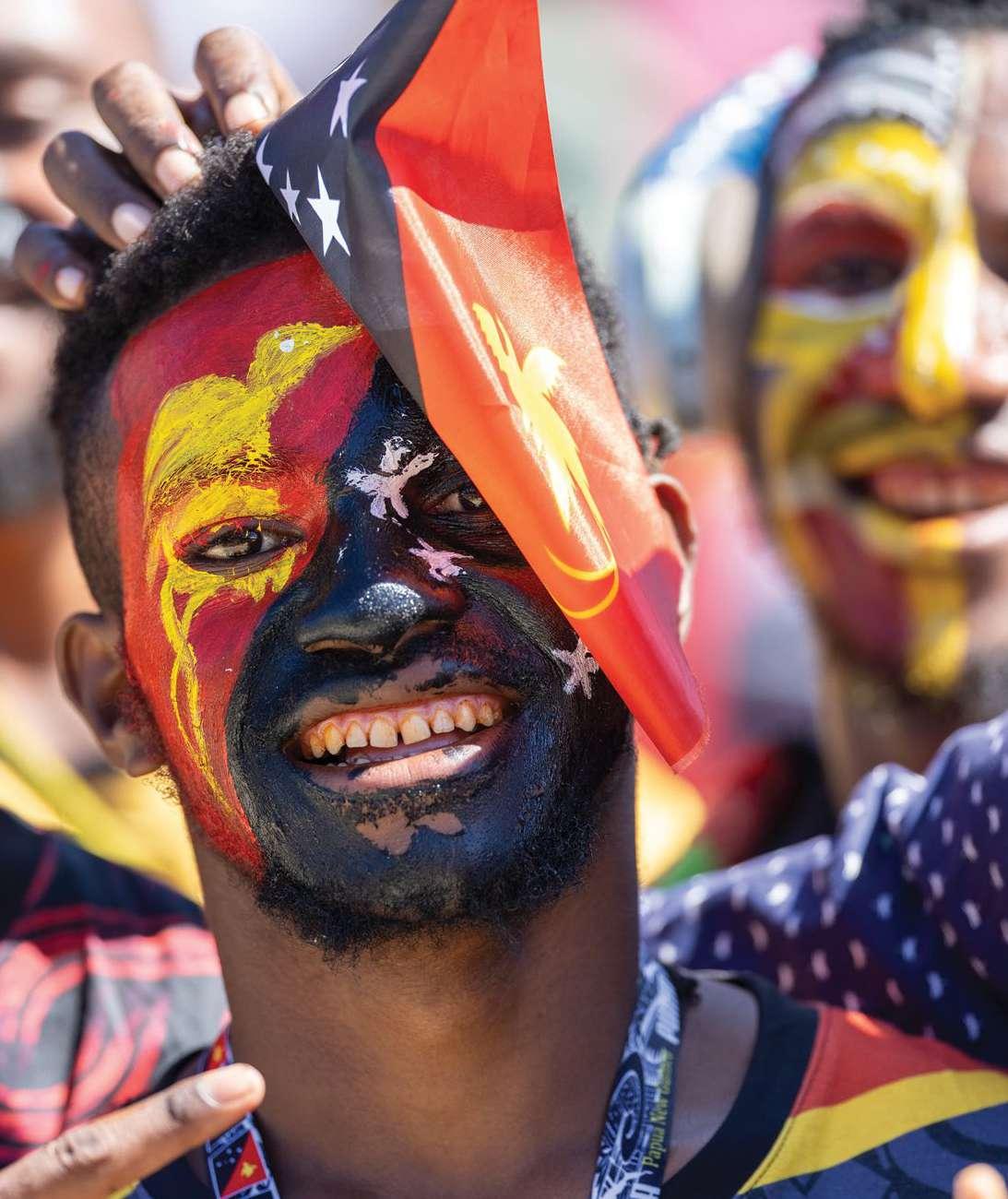
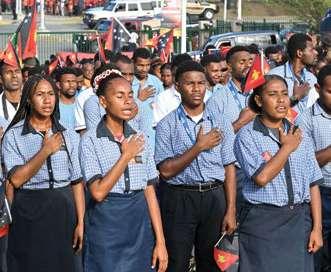

50 YEARS OF INDEPENDENCE
How PNG celebrated
Papua New Guineans celebrated the country’s 50 years of independence with events including concerts, fireworks and parades. For the moving flag-raising ceremony the voices of dignitaries and a big crowd joined to sing the national anthem. Mary Tao reports.
It was a few hours before dawn on September 16 in Port Moresby. Although it was still dark, thousands of proud Papua New Guineans dressed in red, black and yellow had already started to fill up Independence Boulevard.
There was much excitement in the air but also reverence for this momentous occasion: the country’s 50th independence anniversary.
On Independence Hill (within Parliament grounds) dignitaries from all over the world were present to witness the flag-raising ceremony as guests of Prime Minister James Marape and the Governor General, Sir Bob Dadae.
As the Honour Guard raised the flag, a 50-gun salute rang out and everyone joined their voices to sing the national anthem.
Prime Minister Marape then addressed the nation in a special bilum -weaved jacket,
his speech reflecting the festivities’ official theme: ‘Celebrate our history, inspire our future’.
“Today we gather on sacred ground –Independence Hill – where, 50 years ago, our nation, Papua New Guinea, was born. Out of many, we became one, under one flag that was hoisted for the first time on the morning of September 16, 1975.
“That morning the world witnessed the birth of the most diverse nation on earth –with many, many tribes – over 1000 tribes in fact, speaking over 800 languages. From many, we became one.
“Our parents and our grandparents were the children of Papua New Guinea, (they) created history and witnessed history. They were historians, they carved out the country we enjoy today.
”Most notable at the flag-raising ceremony were Prince Edward, The Duke of Edinburgh, who represented King Charles III; and the Australian Prime Minister, Anthony Albanese.
PNG’s connection to Australia has always been a significant one. After World War 2, Australia had assumed control over what was then the Territory of Papua New Guinea. The Territory formed its first government under who would become its first Prime Minister, Michael Somare (later Grand Chief) in 1973. Two years later, the country officially achieved independence.
Fifty years ago, Australian Prime Minister Gough Whitlam was present to witness the lowering of the Australian flag and to end the era of colonisation. A young Prince Charles was also there to welcome the new country to the Commonwealth.
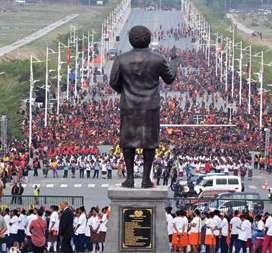
Out of many, we became one, under one flag that was hoisted for the first time on the morning of September 16, 1975. 4
50 YEARS OF INDEPENDENCE
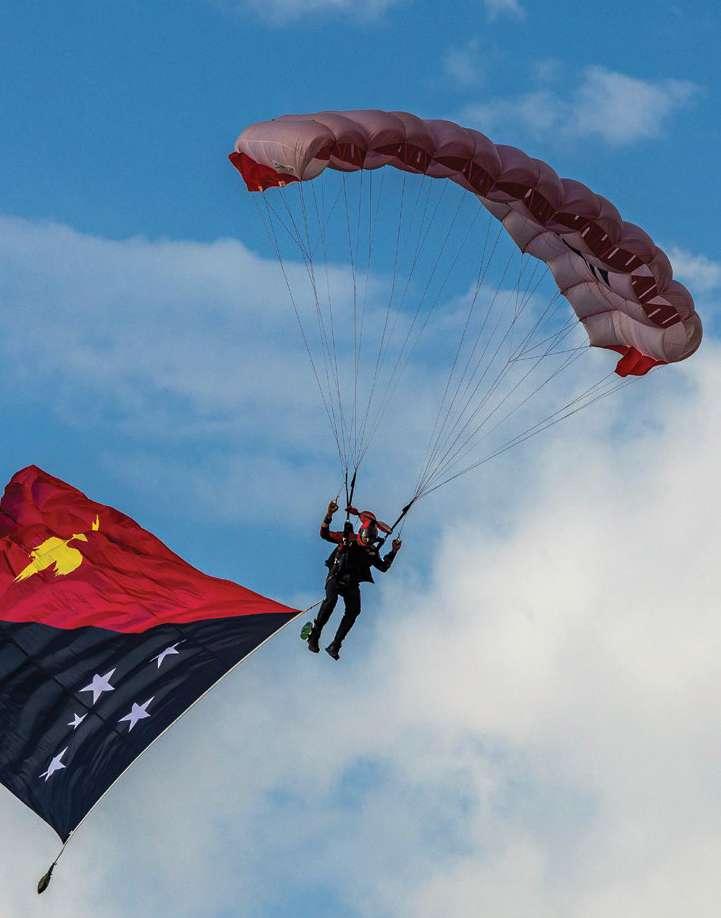
This year, the now King’s message for the 50th anniversary, which he partially delivered in Tok Pisin, was played to the country and the cheering crowd that evening, at Sir John Guise Stadium.
“The story of Papua New Guinea stretches back far further than the past five decades. One need only witness the immense diversity of peoples, languages and cultures, not to mention the abundant flora and fauna, throughout the nation, to appreciate the richness and the complexity of its heritage, which will also shape its future in generations to come,” King Charles said.
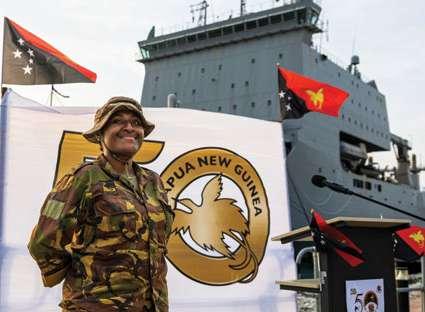
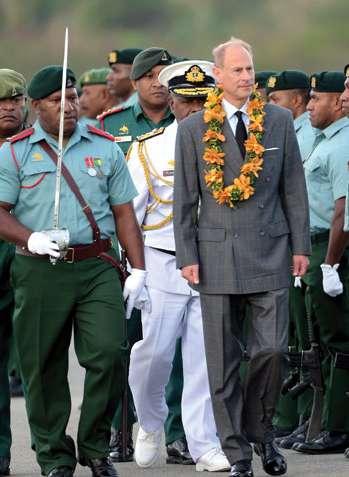
“Though the journey has not always been an easy one, modern Papua New Guinea stands as a proud symbol of its citizens’ perseverance, resilience and tireless commitment to democracy and unity. Together you have made great strides and advances in development, public health, infrastructure and diplomacy.
“As a mature and established voice in the Pacific and on the world stage, I am immensely proud that Papua New Guinea is such a deeply valued and respected member of our Commonwealth family.”
The activities weren’t limited to the nation’s capital, with Papua New Guineans joining in the celebrations across the country. 5 6 7 8
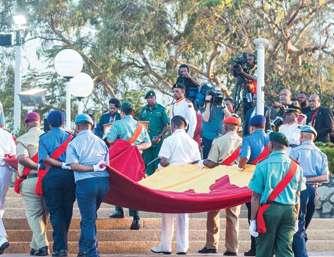
Earlier activities, in the lead-up to September 16, included street parades, a military tattoo, airshows and aircraft displays, visiting naval ships open for public viewing, art exhibitions and the Amazing Port Moresby Festival.
The night ended with a drone show and fireworks that lit up the sky in Port Moresby.
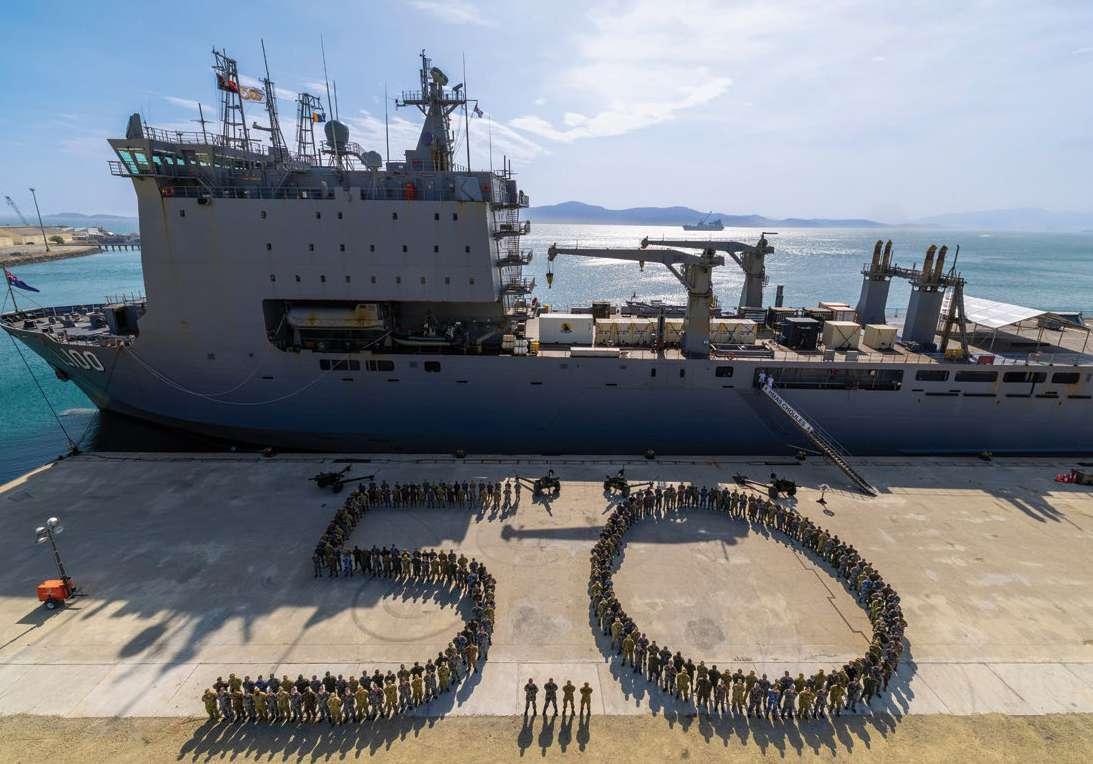




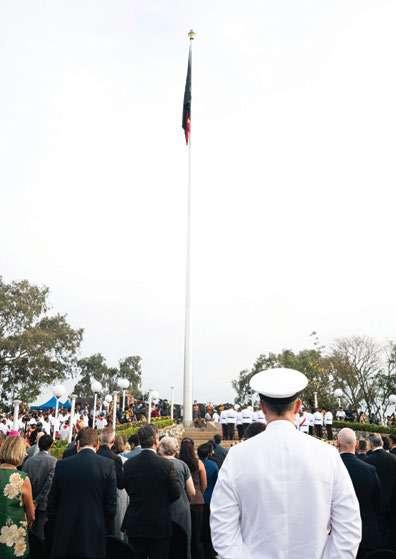




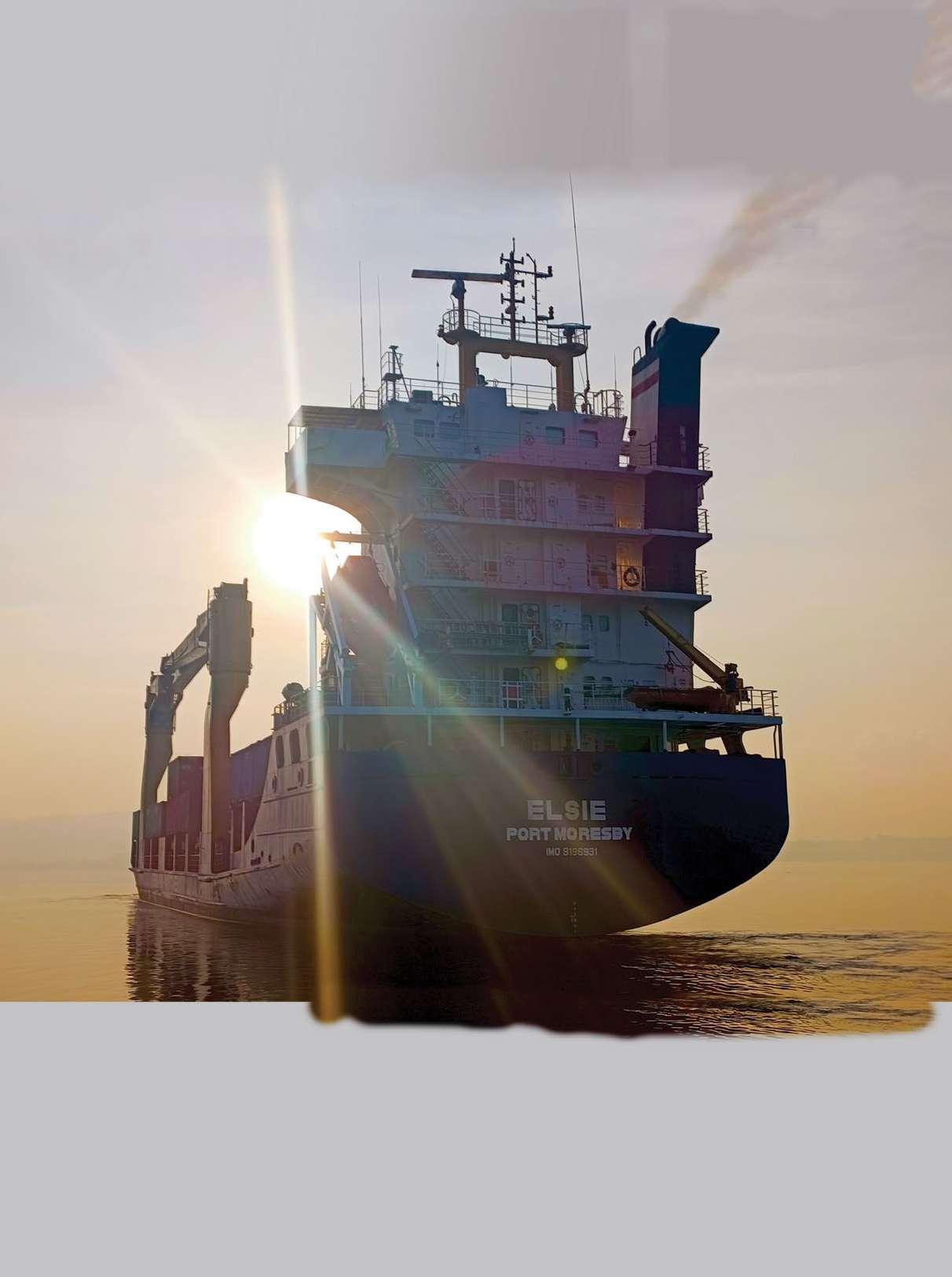




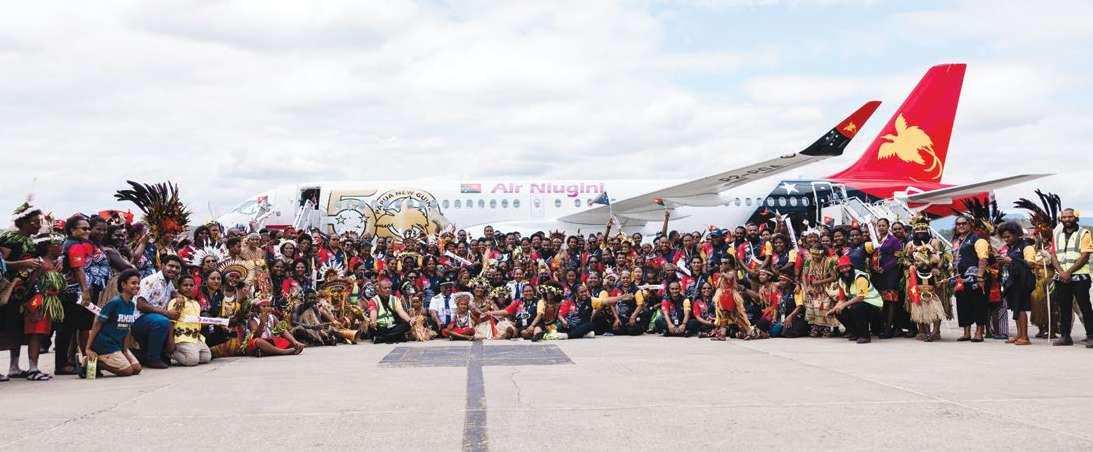

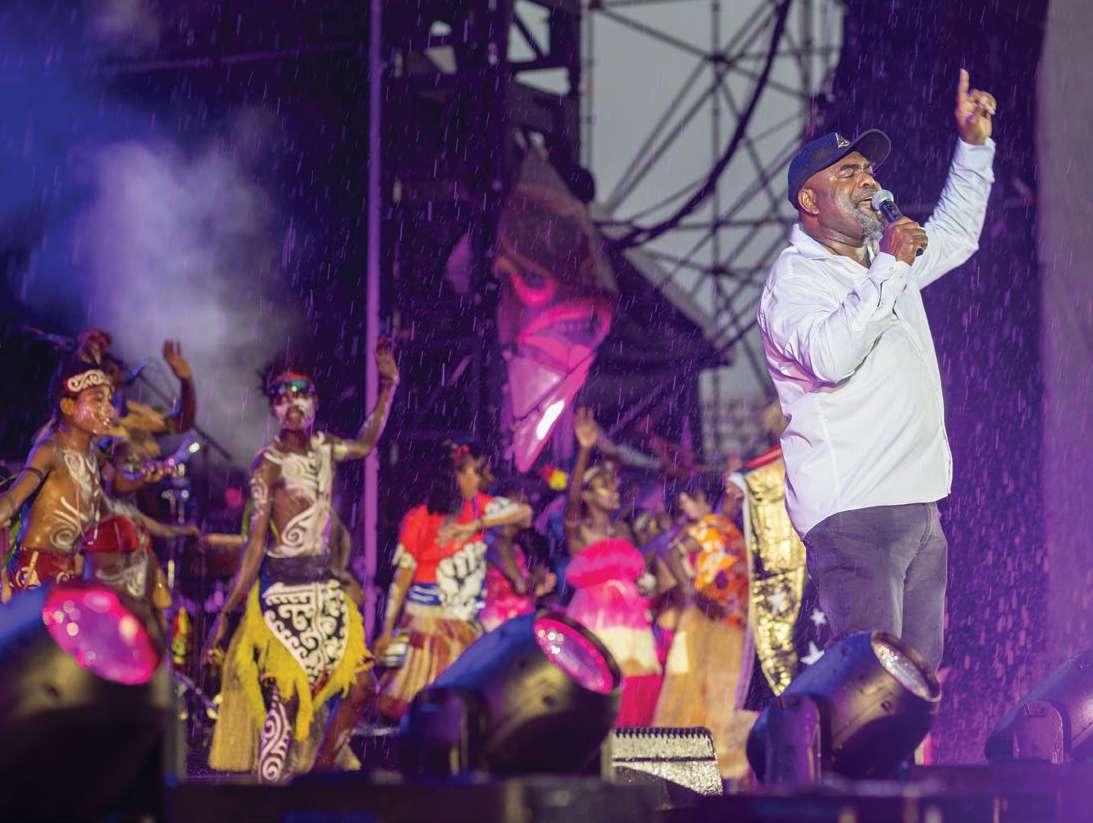
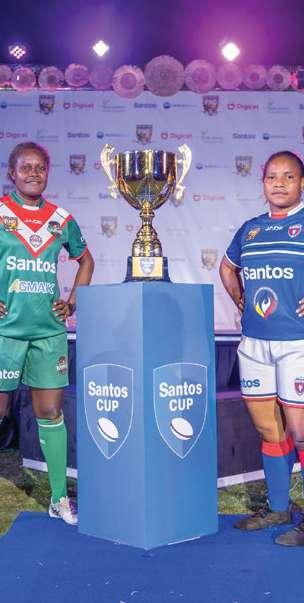
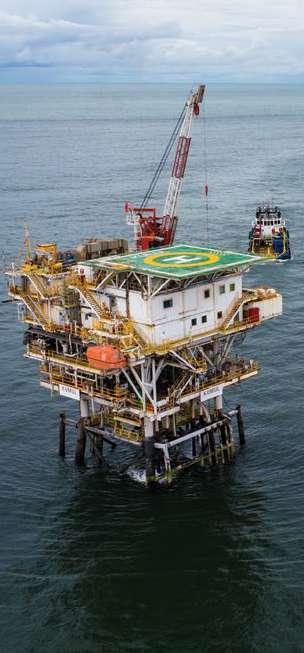

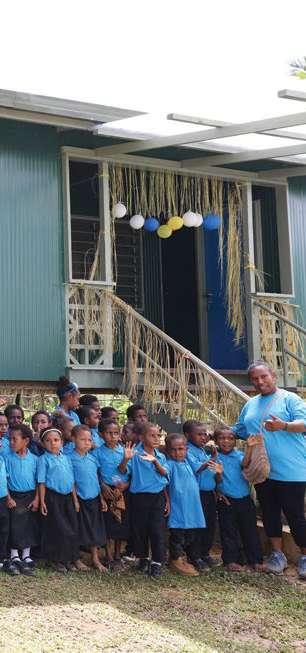









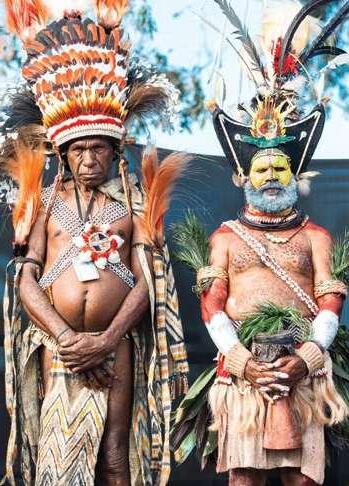
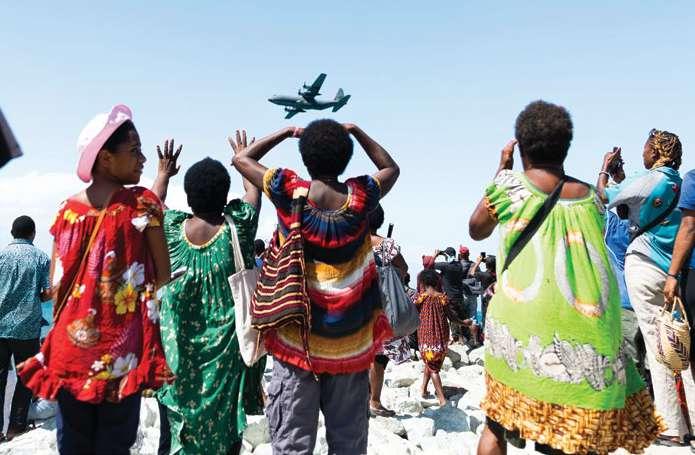
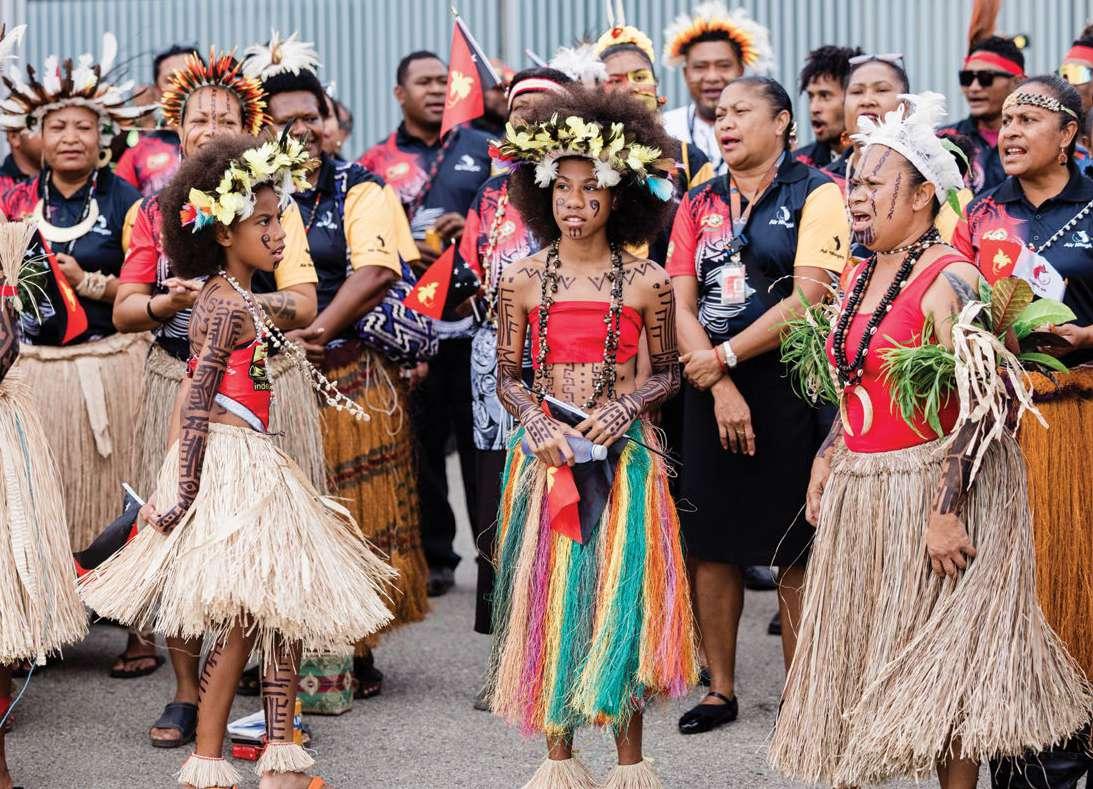

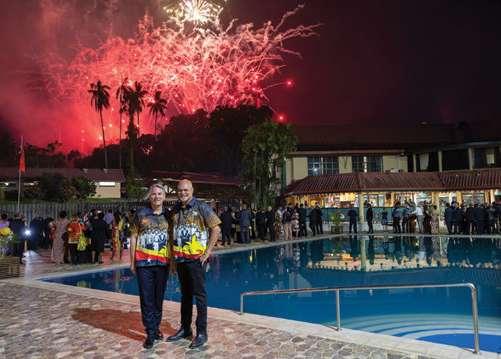
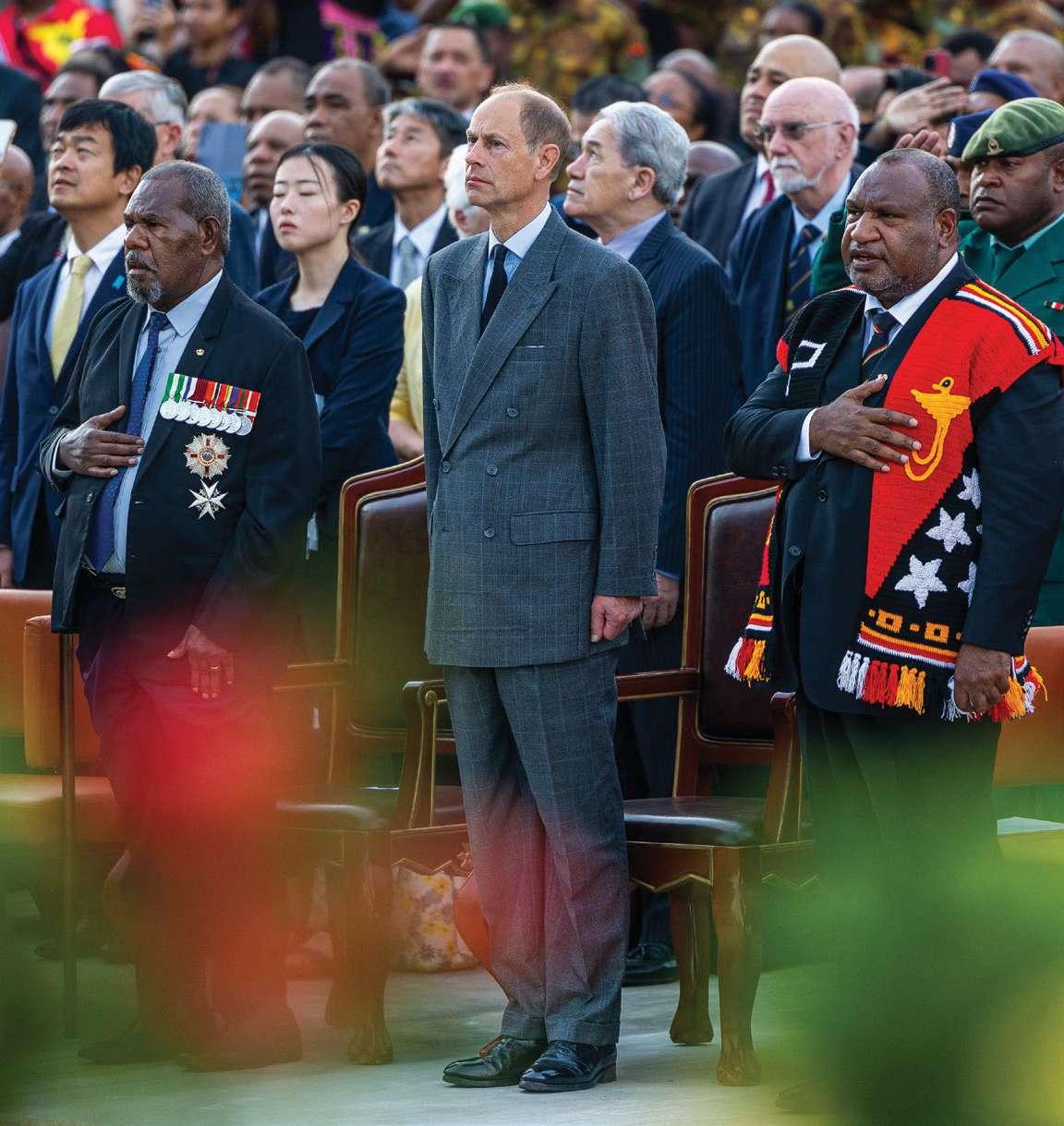
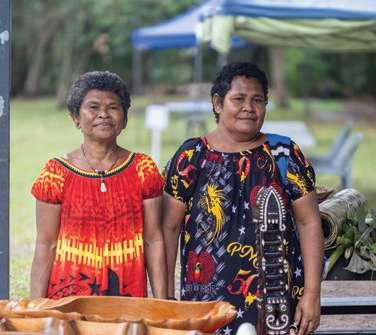


50 YEARS OF INDEPENDENCE
1 A man in the crowd proud in PNG colours. PICTURE: AUSTRALIAN DEFENCE FORCE / RODNEY BRAITHWAITE
2 School students sing the national anthem O Arise, All You Sons on the grounds of parliament on September 16. PICTURE: AAP / MICK TSIKAS
3 Prime Minister James Marape addresses the nation at Independence Hill on September 16, moments after the flag was raised.
PICTURE: LENNOX MATAINAHO
4 Crowds on Independence Boulevard on September 16 in front of a statue of PNG’s first prime minister, Michael Somare (unveiled in August). PICTURE: AAP / MICK TSIKAS
5 An Australian Army parachutist descends into Port Moresby’s Sir Hubert Murray Stadium for the start of a Military Tattoo on September 5.
PICTURE: AUSTRALIAN DEFENCE FORCE / CORPORAL JACK PEARCE
6 Prince Edward, the Duke of Edinburgh, inspects the guard on his arrival in Port Moresby for independence celebrations.
PICTURE: ANDREW KUTAN / AFP VIA GETTY IMAGES
7 Papua New Guinea Defence Force (PNGDF) musician Jamalyn Anena on deck in Port Moresby for a function to welcome visiting military.
PICTURE: AUSTRALIAN DEFENCE FORCE / CORPORAL JACK PEARCE
8 The national flag moments before it was raised on Independence Hill on September 16. PICTURE: LENNOX MATAINAHO
9 The Royal Australian Navy and Pacific forces from New Zealand, Tonga, Fiji and Vanuatu form a ‘50’ in front of the HMAS Choules at the PNGDF naval base in Port Moresby.
PICTURE: AUSTRALIAN DEFENCE FORCE / CORPORAL JACK PEARCE
10 PNGDF sailors lead a naval welcome march in Port Moresby on September 4, followed by more than 200 participants from the Royal Australian Navy and armed forces from Tonga, Fiji, the United Kingdom, India and France. PICTURE: AUSTRALIAN DEFENCE FORCE / CORPORAL JACK PEARCE
11 PNGDF naval ships were open for public tours during independence celebrations. Overseas ships were also open, including HMAS Choules (Australia), INS Kadmatt (India), FNS Auguste Benebig (France) and Voea NgahauKoula (Tonga). PICTURE: LENNOX MATAINAHO
12 Dignitaries and guests pay respect to the PNG flag on Independence Hill. PICTURE: LENNOX MATAINAHO
13 From left, the Duke of Edinburgh, Prince Edward; Royal PNG Constabulary Commissioner of Police, David Manning; and Commander of the PNGDF, Rear Admiral Philip Polewara.
PICTURE: GOVERNMENT OF PNG
14 PNGDF soldiers perform a precision drill during the Military Tattoo at Sir Hubert Murray Stadium.
PICTURE: AUSTRALIAN DEFENCE FORCE / CORPORAL JACK PEARCE
15 The PNGDF band is led by Lieutenant Robert Iamba at the Military Tattoo. PICTURE: GOVERNMENT OF PNG
16 A participant performs in the PNG Songwriting Contest at Vision City Megamall. Entrants performed an original song inspired by the country’s 50th anniversary. PICTURE: LENNOX MATAINAHO
17 Hundreds of Air Niugini staff, many in traditional dress, welcoming the airline’s new A220 aircraft into Port Moresby on September 15. The aircraft’s arrival was timed to coincide with independence celebrations. PICTURE: AIR NIUGINI / DANIEL WALA
18 Performers from Oro Province get ready to take centre stage for celebrations at the Pacific Adventist University.
PICTURE: LENNOX MATAINAHO
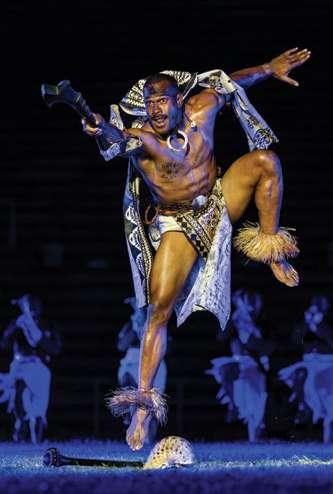
19 One of PNG’s biggest musical artists, Anslom Nakikus, performs at the Meganesia Concert at the Sir John Guise Stadium. A big crowd sang along and waved flags despite a downpour. Behind him are representatives of the cultural groups who also performed. PICTURE: LENNOX MATAINAHO
20 The Aikam Singsing Group from Siassi, Morobe Province, at Meganesia. PICTURE: LENNOX MATAINAHO
21 A cultural group from Bougainville at Meganesia. PICTURE: LENNOX MATAINAHO
22 Men from the Highlands stand proudly in their bilas on Independence Hill on September 16. PICTURE: LENNOX MATAINAHO
23 Crowds at Ela Beach watch a Royal Australian Air Force fly-past. PICTURE: AUSTRALIAN DEFENCE FORCE / LSAI LAUREN PUGSLEY
24 Air Niugini staff and their children welcoming the arrival of the airline’s new A220 aircraft in Port Moresby. PICTURE: AIR NIUGINI / DANIEL WALA
25 PNG Prime Minister James Marape and Australian Prime Minister Anthony Albanese. PICTURE: AUSTRALIAN DEFENCE FORCE / CORPORAL JACK PEARCE
26 Prince Edward, the Duke of Edinburgh (middle), with Prime Minister James Marape (right), Rachal Marape and PNG Governor General Sir Bob Dadae (left) at Independence Hill during the flag-raising ceremony on September 16. PICTURE: AUSTRALIAN DEFENCE FORCE / CORPORAL JACK PEARCE
27 PNG’s Deputy Prime Minister John Rosso with Australia’s Deputy Prime Minister Richard Marles in Lae as fireworks go off for independence celebrations. PICTURE: AUSTRALIAN DEFENCE FORCE / RODNEY BRAITHWAITE
28 Women from the Trobriand Islands at the Tumbuna Festival at Port Moresby Nature Park. The two-day festival had traditional cooking displays as well as carving and craft-making displays.
PICTURE: LENNOX MATAINAHO
29 Traditional attire from across PNG was on show at the September 16 flag-raising ceremony at Independence Hill, including this Mekeo attire from Central Province. PICTURE: LENNOX MATAINAHO
30 Fiji’s Lance Corporal Tevita Bainiloga performs a traditional dance during the Military Tattoo. PICTURE: AUSTRALIAN DEFENCE FORCE / CORPORAL JACK PEARCE

“From Vision to Action –Strenghtening Western Province through ‘Gutpela Communities’ ”
In the far reaches of Papua New Guinea’s Western Province, where the Fly River winds through dense rainforest and scattered villages, a quiet transformation is underway. The PNG Sustainable Development Program (SDP) is helping communities unlock new opportunities, bringing essential
services in education, health, and livelihoods to places once out of reach.
Since re-establishing its programs in 2018, SDP is reaching one community at a time from remote health patrols to building learning facilities and empowering communities through its livelihood program.
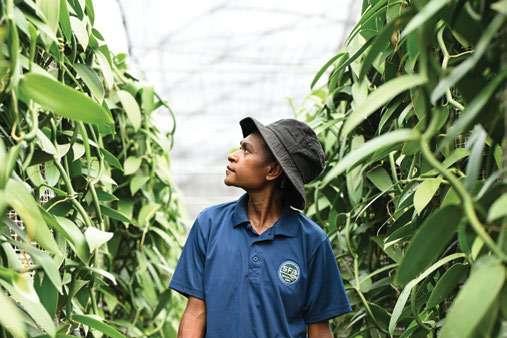
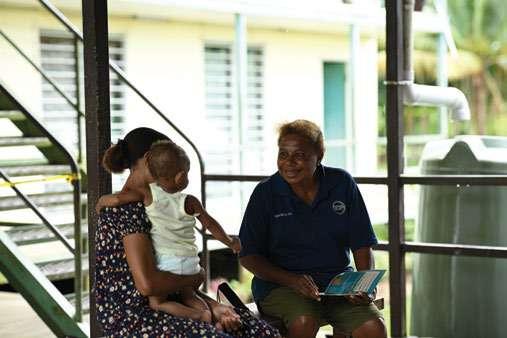
Based on its five-year Gutpela Community Strategy (2025-2030), SDP is committed to delivering fit for purpose, community-led initiatives across remote villages in alignment with the Western Province Integrated Development Plan (2023-2027)


SDP’s livelihood program is empowering communities through income generating opportunities such as vanilla farming.
Students of Balimo College School of Nursing.
SDP’s health patrols and programs are saving lives by making health services accessible to remote communities in Western Province.
SDP Balimo Hub hosts the education program and is the main operational hub ensuring communities are reached.

Peter Graham Board Chairman
Building Health, Education and Livelihoods in Western Province
In 2024 alone, SDP invested over US$55 million into programs across Health, Education, and Livelihoods.
SDP’s mobile health patrols is reaching 91 communities and over 113,000 people, delivering life-saving care to some of PNG’s most remote areas. The newly upgraded K52 million Morehead health facility is now a beacon of hope for families and communities in South Fly.
Education is a cornerstone of SDP’s work in Western Province with its major investment in establishing Balimo College, a DHERST accredited institution that is committed to developing a pipeline of quality teachers and nursing staff to fill the capacity gap in existing schools and health facilities. The Balimo College is the first tertiary institution for the province offering Bachelors in Nursing and Primary Teaching. The K20 million campus funded by SDP is implementing innovative learning approaches and enabling local students to pursue employment pathways whilst contributing to
improved service delivery with the aim of improved health and education outcomes across the province. Additionally, the Roy Biyama Balimo Academy provides early learning through to secondary education. The Balimo FODE Centre provides flexible learning options, and the innovative
We are commited to building a better future for Western Province for current and future generations.
eLearning teacher coaching program is equipping teachers to prepare students for the future.
The livelihood program is supported through the South Fly Agri, our joint venture, situated in Daru and oversees all our agribusiness operations around the province. The aqua farming facility in Daru helps stimulate local economy and create access into international markets

for Western Province farmers. A 100-hectare cocoa farm under trial in Oriomo, South Fly District is showing promising results with grafted seedlings. Other cash crops such as vanilla, cocoa and black pepper are being introduced as formal out grower programs with extension services in the form of training, support and access to market. These initiatives empower local farmers in creating jobs, boosting incomes, and building resilient communities.
Behind every kina is a story of partnership, perseverance, and progress. SDP is working with local leaders and the Western Provincial Government to help the people of Western Province achieve their developmental potential through its “Gutpela Community” strategy. SDP is building trust and committed to doing more.
Read more about what we’re doing in Western Province at www.pngsdp.org
Follow us on Facebook and LinkedIn
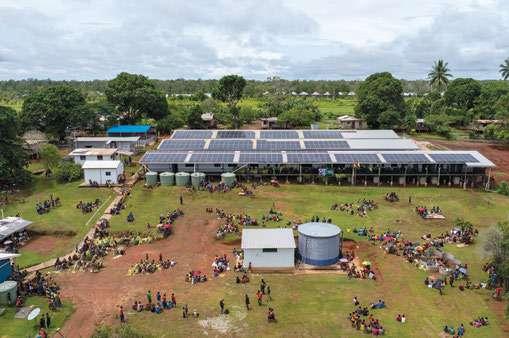
An aerial view of the recently opened Morehead Health Facility in South Fly District. The Morehead health facility was upgraded to a Level 3 facility at a cost of K52 million and was officially opened in March this year.
SDP funded school of excellence in Balimo- The Hon Roy Biyama Academy offers early learning to Grade 12 education.
TRAVELLER
OUR COUNTRY, OUR REGION, OUR WORLD
BIG PNG ADVENTURES 10
1
WALK THE KOKODA TRAIL
Tackle the epic Kokoda Trail –sandwiched between the north and south coasts of the country – over six to 12 days. It is a one-stop-shop for Papua New Guinean geography, with natural landscapes that alternate between mountains, lowlands, jungles and streams. The 96-kilometre trail is physically and mentally demanding, offering the opportunity to walk in the footsteps of World War 2 soldiers from Australia and PNG’s Fuzzy Wuzzy angels who fought one of the defining campaigns of that period. Many who have walked the trail have likened it to a pilgrimage – a chance to deeply understand the endurance and sacrifice of wartime heroes. There are many PNG and Australian-based trekking companies, including pngtrekkingadventures.com and kokodatreks.com.
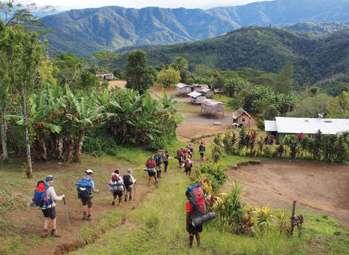
Paige Turner sets out on 10 great PNG adventures, from hiking to the top of a volcano to staying at a remote fishing lodge.

Tackling the Kokoda Trail (above and right).
2
CANOE THE SEPIK RIVER
The Sepik River offers a glimpse into the life of isolated river villages via motorised dugout canoe with local guides. At some village stops, visitors are permitted to enter the haus tambaran (spirit house), a traditional ceremonial place for men, which was the inspiration for the facade of PNG’s National Parliament. There are opportunities for birdwatching as well, particularly near the village of Wagu where you can see the bird of paradise. Also near Wagu is a freshwater creek that can be snorkelled. You can camp overnight at these village stops with your tour guides. See pepetapng.com/tour/9-day-sepik-riveradventure and southseahorizons.com/product/ sepik-river-adventure.
3 GAME FISH IN THE WILD WEST
In the wild west of PNG, close to the Indonesian border, there are lowlands that are Amazonian in nature, with bending rivers, unbroken grassland and sightings of deer, crocodiles, wallabies, goannas and birds. It is also an excellent place for game fishing. During dry season, from June to September,

anglers can book a stay at the comfortable Bensbach Wilderness Lodge, setting out to catch king-sized black bass and barramundi daily in Bensbach River. The remote lodge can house up to 16 guests and includes 24hour solar power. There is also a bar so you can enjoy a beer with your day’s catch. See pngtours.com/bensbach-wildlife-lodge and anglingadventures.com.au/bensbach.
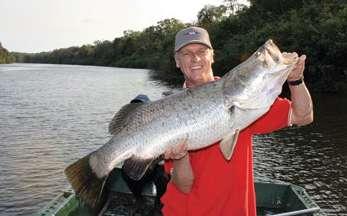

The remote Sepik region.
PICTURE: ISTOCK
Fishing at Bensbach Wilderness Lodge (above and this picture).
4 SEE THE GOROKA SHOW
What better way to see the scope of PNG storytelling and dancing than at one of the premier cultural shows? The Goroka Show takes place annually in September over three days, bringing together different tribes with elaborate bilas (traditional costumes) and tribal groups, including the Asaro Mudmen. The dances of different cultural groups can be chilling, militant, energetic, wistful, comedic, mysterious and proud. Cultural shows also feature art and craft stalls and traditional foodmaking demonstrations. Air Niugini Tours has show packages that include airfares from Port Moresby to Goroka. See airniugini.com.pg.
5
VISIT THE TUFI FJORDS
One of the country’s most breathtaking coastal wonders, the Tufi Fjords have been called a ‘tropical Scandinavia’, comprising deep valleys etched into the lush coastline of Oro Province. Tall cliffs encircle the turquoise inlets. Visitors can snorkel and dive coral reefs teeming with fish, enjoy wreck dives or canoe with local guides. The boutique Tufi Resort, above the fjords, arranges fjord cruises, cultural encounters with local villages and land tours. See tufiresort.com.
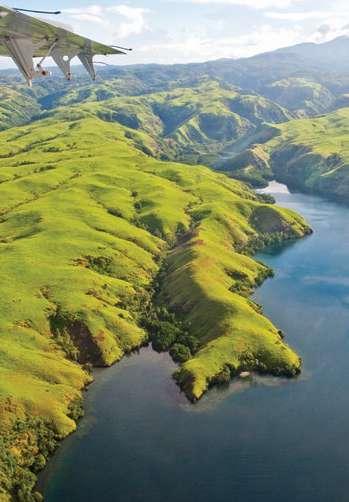
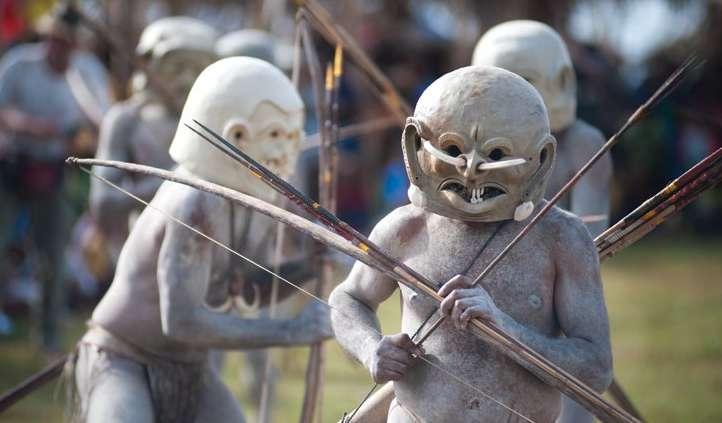

6
DIVE AND SNORKEL AT TAWALI
Take in Milne Bay’s charm with a weekend stay at Tawali Leisure and Dive Resort. As the name suggests, the resort is the envy of divers and snorkellers all over the world with its spectacular house reef, coral gardens and muck dives. Other attractions include the fresh local food, traditional cooking demonstrations, a rainforest hike, birding, visits to nearby islands, a waterfall and the famous skull caves. If you can, carry some local cash, as you’re likely to meet some paddling vendors on the way, selling their shells and wares. The resort is a boat ride and a drive away from Gurney Airport at Alotau. See tawali.com.
7
SCALE A VOLCANO
One of the most active and accessible volcanoes in PNG, Mount Tavurvur is a poignant reminder of the devastating power of nature. Located just outside Rabaul, it buried much of the town in ash during its last significant eruption in 1994. Today, travellers can hike to the edge for unique harbour views of Rabaul, neighbouring islands and the smoking caldera. The steep climb up takes about an hour, with heat rising from vents and the smell of sulphur in the area. At the base, visitors can also see bubbling hot springs and the post-eruption wreckage. PNG’s founding father, Michael Somare, was born in Rabaul, with a memorial erected near the entrance to Mount Tavurvur. Find a private guide at toursbylocals.com or see pngtg.com/rabaulshore-excursions.

Mud men at the Goroka Show (top); Tawali Resort (middle); Mount Tavurvur (above); the Tufi Fjords (left). PICTURES:
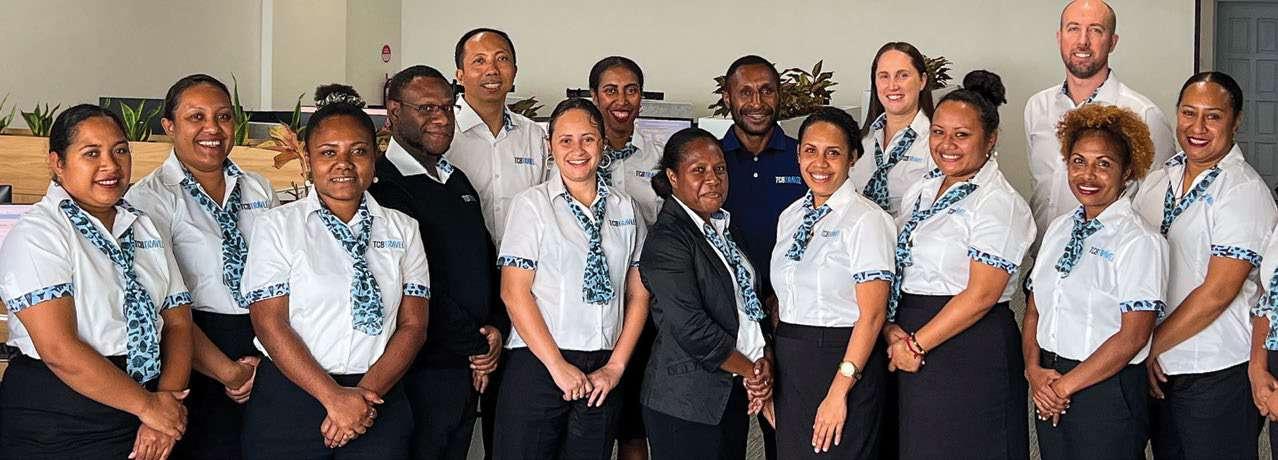
OUR COUNTRY
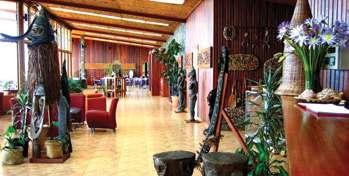
8 STAY AT A MOUNTAIN LODGE
Sitting high above Mount Hagen, at 2100 metres, Rondon Ridge Lodge provides a front-row seat to the region’s enchanting geography and cultures. The lodge overlooks sweeping valleys and jagged mountain ranges, with crisp air and panoramas that shift with the clouds. The lodge offers spacious twostorey apartments and bungalows, a perfect retreat after exploring the flora and fauna, visiting local villages, witnessing sing-sings and birdwatching in forests. See pngtours.com/rondon-ridge.
9 BECOME A ‘VANIBRO’
Become a so-called ‘Vanibro’ by visiting PNG’s northwest coast, near the Indonesian border, where an awesome surf destination awaits at Vanimo. Known for its friendly locals and laid-back surf camps, the area has beach and reef breaks that light up between October and April when monsoon swells arrive. Breaks
like Lido and Yako (a neighboring village) serve up clean rights and lefts, often peeling into rideable barrels. What also sets Vanimo apart are the hearty meals of fresh fish and garden food, the privacy and the opportunity to mingle with locals. There are other activities, too, such as visiting a waterfall – an hour away from Vanimo Surf Lodge – or taking a day trip to Indonesia. See vanimosurflodge.com.

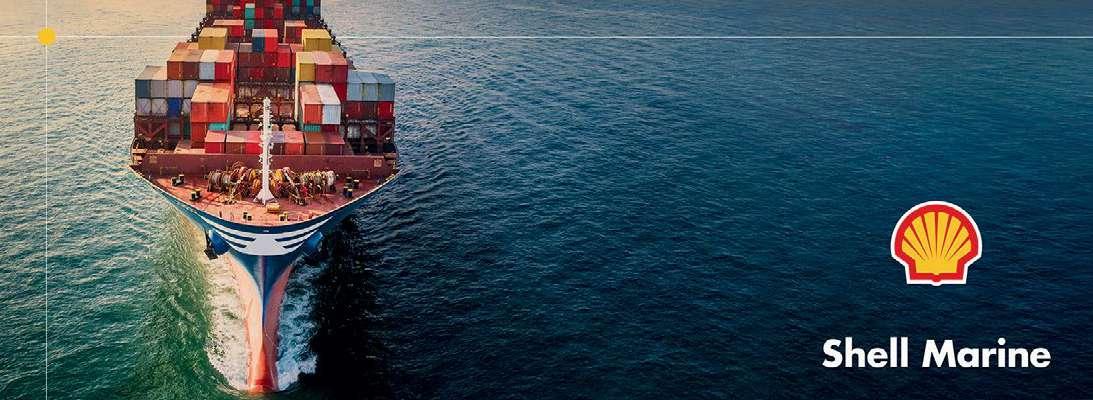

Unlock superior performance and reliability for your marine diesel engines with Shell Gadinia S3 40! This high-quality lubricant is expertly formulated to extend oil life, protect your engine from wear and tear, and maximize system efficiency. By choosing Shell Gadinia S3 40, you're not just buying a lubricant; you're investing in the longevity and smooth operation of your equipment, ultimately reducing operating costs and minimizing downtime. Trust Shell Gadinia S3 40 to keep your marine diesel engines running stronger, for longer.
Rondon Ridge (top left); Vanimo Surf Lodge (above).
ONLY Authorised Shell Lubricants Distributor in PNG

10
ESCAPE THE CITY TO VARIRATA NATIONAL PARK
An hour’s drive from Port Moresby, Varirata provides an easy escape to PNG’s countryside. Trails wind through forest and open clearings, leading to spectacular lookouts over the capital and the coastline. Because hunting is not allowed onsite, the park is a birdwatcher’s dream – featuring owls, kingfishers and the raggiana bird of paradise, PNG’s national emblem, which is often spotted in the early morning performing its vivid mating dance. Varirata has a range of experiences, including five well-marked tracks ranging from easy strolls to more challenging loops, the Koiari treehouse, and picnic grounds. For a day package from Port Moresby see newguineanaturaltours.com.pg or make a group booking at amazingportmoresby.com/ tour/varirata-national-park/.
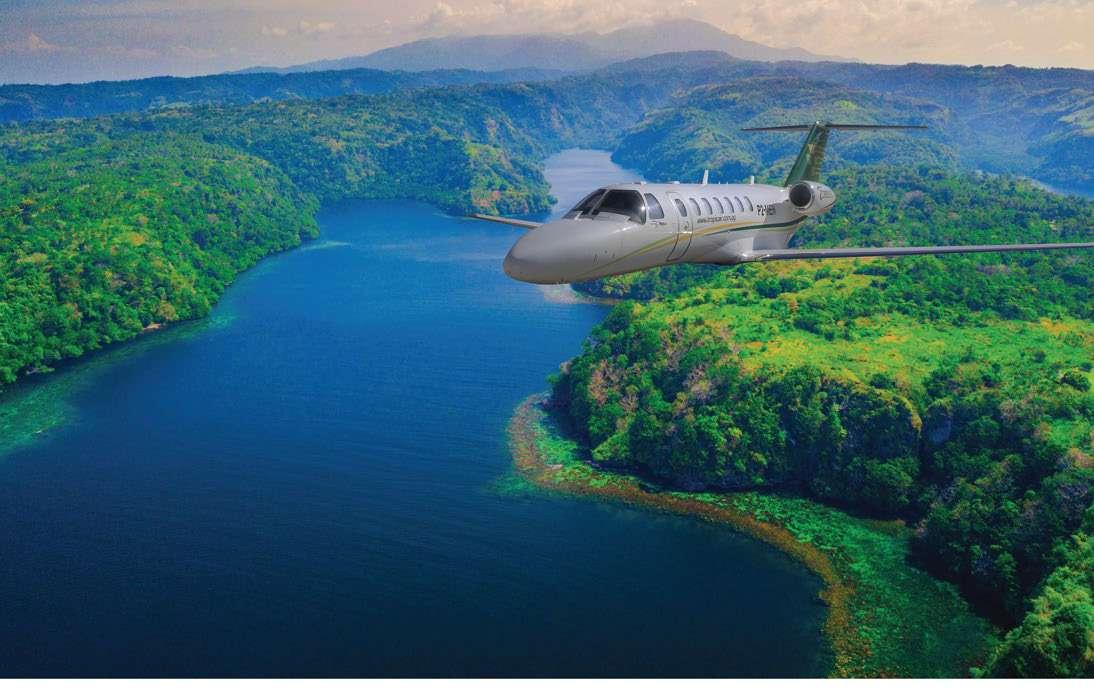


Birdwatching and nature walks are a feature of Varirata National Park near Port Moresby.

TOUCHES DOWN AN AVIATION MILESTONE
A220
Air Niugini has taken delivery of its first A220 aircraft, the first of many that will be added in a major modernisation of the airline’s fleet.

PICTURES:
Air Niugini’s A220 pilots Captain Beverly Pakii and Captain Timothy Narara presenting an A220 aircraft model to Prime Minister James Marape.
The new A220-300 (P2-PGA) in national colours on arrival in Port Moresby.

Papua New Guinea’s most anticipated aviation moment was realised on September 15 when Air Niugini’s first Airbus A220-300 – known as the People’s Balus – touched down at Jackson’s International Airport in Port Moresby.
The historic landing coincided with the country’s 50th independence anniversary celebrations, a fitting milestone for the national flag carrier and the country.
Arriving slightly ahead of schedule at 10am, the aircraft performed a flyover across Port Moresby’s skies, thrilling thousands from coastal villages from Bootless Bay to Pari,

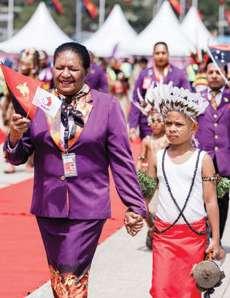
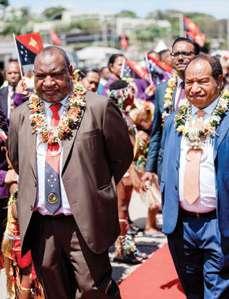
downtown Port Moresby, Hanuabada, Tatana, Porebada and Boera, giving Papua New Guineans a first glimpse of the People’s Balus. Families also stopped at Seven Mile to catch a glimpse, waving flags and cheering as the brand-new jet soared proudly in the nation’s striking colours of red, black and gold.
At the helm of the flight were Captain Beverly Pakii – Air Niugini’s first Airbus A220 captain and a proud trailblazer for PNG women in aviation – together with veteran aviator Captain Timothy Narara. Their leadership in the cockpit symbolised not only technical excellence but also the growing depth of PNG’s aviation expertise.
Prime Minister James Marape, who led the official welcome at the airport alongside Government leaders, members of the diplomatic corps, the Air Niugini board and management, as well as hundreds of staff, described the moment as a reflection of the nation’s resilience and progress.
“On the eve of our 50th independence anniversary, we show the world that Papua New Guinea is capable, confident, and ready to soar higher,” Prime Minister Marape said. “Many doubted whether we could endure, yet here we are – our people, our pilots, our flag flying on the world’s newest aircraft. This is more than a plane; it is a statement of who we are and what we can achieve together.”
The arrival was marked by rich cultural celebrations. Even before the aircraft touched down, staff and cultural groups were singing and dancing in traditional attire. From the vibrant Poreveta dancers of Central Province to the colourful Kwanua group of East New Britain, the popular Manus dancers and the
proud Highlanders in their iconic regalia, the atmosphere was one of unity, pride and jubilation.
Following a ceremonial water salute, the aircraft taxied to its parking bay, where Cardinal Sir John Ribat blessed the aircraft before the Prime Minister cut the ribbon to officially welcome the People’s Balus. The Minister for State-Owned Enterprises, William Duma, highlighted the significance of the government’s support for Air Niugini’s ongoing fleet transformation program.
On the eve of our 50th independence anniversary, we show the world that PNG is capable, confident, and ready to soar higher.
“This aircraft was built specifically for us – for Papua New Guinea, for our flying conditions, for our people, and for our future. By investing in these new aircraft, we are investing in our people’s mobility, in trade and business, in tourism, and in travel for family reunions and education.”
Representatives from Airbus and aircraft lessor Azorra also joined the celebrations and expressed their admiration for the warm and uniquely Papua New Guinean reception.
Cardinal Sir John Ribat (above left); a cabin crew member and child in traditional costume at the aircraft’s welcoming ceremony (above middle); Prime Minister James Marape and Minister for State – Owned Enterprises William Duma (above right).
Anand Stanley, President of Airbus Asia Pacific, said: “Air Niugini has joined an elite group of airlines operating the world’s most modern single-aisle aircraft. The Airbus A220 is perfectly suited for Papua New Guinea’s network, offering outstanding fuel efficiency, passenger comfort, and range. We are honoured to partner with Air Niugini in shaping the future of aviation for this remarkable country.
“We have delivered aircraft across the globe, but the welcome we witnessed in Port Moresby was truly special. The passion, culture, and pride of the Papua New Guinean people are inspiring.”
The Airbus A220, registered P2-PGA, began its delivery flight from Montreal, Canada, on September 10. Its journey included transits through Vancouver, Honolulu and Nadi, before it completed the final leg to Port Moresby.
The A220 brings with it a new era of travel for PNG, offering quieter engines, more spacious cabins and state-of-the-art

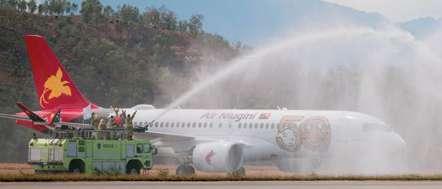
technology. With lower fuel consumption and greater operational efficiency, it will reduce costs while providing passengers with a safer, more comfortable and reliable flying experience. Its range also allows Air Niugini to strengthen domestic connectivity and expand regional links across the Pacific and Asia.
The historic arrival marked more than just the launch of a new aircraft. It reaffirmed Air Niugini’s role as a unifying symbol of the nation, connecting its rugged mountains, remote islands and diverse communities. As
the People’s Balus touched down, it carried not just passengers, but also the hopes and dreams of a proud, resilient, and forwardlooking nation.
Air Niugini is the 25th airline to operate the state-of-the-art A220, with over 900 of the new-generation aircraft having been ordered by 30 other customers around the world, of which over 400 are already in operation.
Air Niugini’s 11 brand-new A220s will come in two variants: three A220-300 planes seating 138 passengers, and eight smaller A220-100 planes seating 114.


A220 captains Beverly Pakii and Timothy Narara (above left); a water salute for the A220 on arrival in Port Moresby (above right).


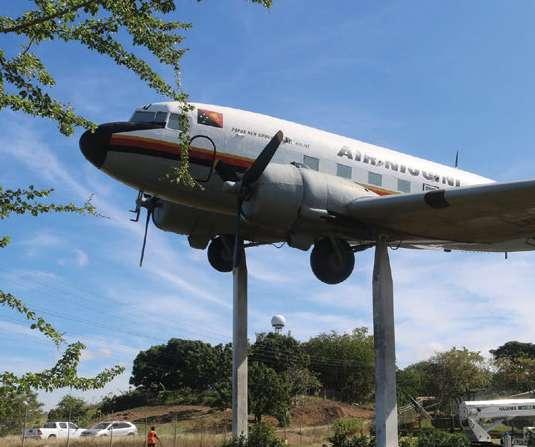
THE A–Z OF AVIATION
Ever wondered what an ‘open jaw ticket’ is, who invented rolling suitcases and how to make yourself more comfortable on a flight? Richard Andrews has all the answers.
AAir Niugini PNG’s flag carrier is a symbol of the country’s astonishing progress. Not only does the airline boost trade and tourism, but it also brings together diverse local communities to create a more unified nation. Founded in 1973, Air Niugini started with a single DC3 and a handful of employees. It’s since grown into a leading regional carrier with about 2200 staff and 24 aircraft serving more than 30 domestic and international destinations.
BBoeing 707 The long-range carrier was leased from Qantas Airlines in 1975 for Air Niugini’s first international flights. The 707 was dubbed locally as Simok Balus (big smoke airplane).
CCodeshare With its airline partners in Asia Pacific, Europe, the Middle East, Africa and the Americas, Air Niugini offers passengers connections to more than 120 destinations worldwide. Codeshare agreements include Qantas, Cathay Pacific and Solomon Airlines.
DDC3 The iconic aircraft, acquired in 1973, is mounted on display outside Air Niugini’s head office in Port Moresby. The propellor-driven DC3 had a cruising speed of 333kmh, a capacity of 21 to 32 passengers and a range of 2400km. Used in Europe during World War 2, the Air Niugini DC3’s previous owners included the US army and a Greek shipping tycoon.
EEating and drinking To enhance your comfort, experts advise passengers to avoid overeating just prior and during a flight. Drink alcohol coffee and tea in moderation, as they act as diuretics, increasing the body’s dehydration.
FFirst female jet captain In January 2018, Beverly Pakii became the first female to command Air Niugini’s Fokker jet aircraft, flying between Lae and Port Moresby. She has recently been certified with distinction to become PNG’s first Airbus A220 captain.
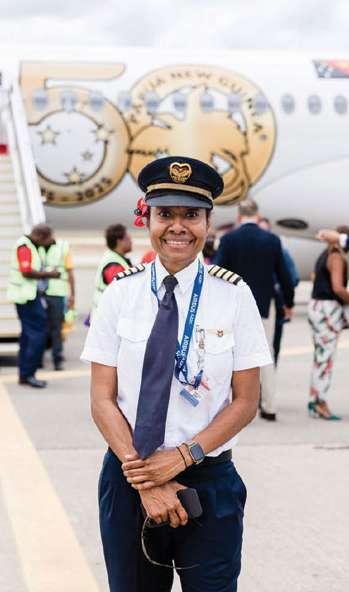
The national flag carrier Air Niugini in the air (above left); the iconic DC3 (above right); Captain Beverly Pakii (below).
JERILAI PUJARI HOLDINGS LIMITED (JPHL)
A Proudly Papua New Guinean Company, Driving Growth

JPHL is the registered business arm of the 11 clans which own the land comprising PRL15 licensing area for the Papua LNG Upstream Project. Its goal is to ensure landowner communities benefit equitably from related commercial opportunities.
Our Mission: To become a leading “Community Representative Company” for citizens within the oil and gas resource project footprint and to expand the company within Papua New Guinea and internationally.
Our Vision: JPHL shall strive to achieve a reputation for excellence as the company owned and representing the PRL15 communities, and as an astute business in protecting and extending the investments of the Community Stakeholders. JPHL aspires to be the role model for representative landowner companies in PNG by working with resource operators to improve the wellbeing and livelihood of landowning communities in PNG.
To achieve this, JPHL has established Joint Ventures with experienced partners who have a strong track record in PRL15. Through these ventures, JPHL aims to maximise landowner participation and create lasting, generational change for the communities it represents.

Jerilai Pujari Field Services Limited
•Camp Management
•Commercial Catering
•Construction Services
•Training Services
•Labour Hire Services
Mr. Graham Leo
General Manager
jv.mgr@jpfsl.com
Mr. Fintan Lalor
General Manager | OMHL (Oilmin) fintan.lalor@oilmin.com
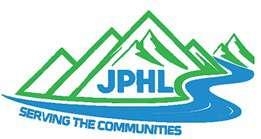

Jerlilai Pujari Security Services
•Static Guarding
•Secure Transport
•Electronic and Technology Solutions
Mr. Neil Petersen Director neil@gdsspng.com
Mr. Wemin Kapia CFO/Director cfo@gdsspng.com

Jerlilai Pujari Transport Limited
•Fleet Management
•Equipment Hire
•Workshop Services
•Land and Marine Operations
Mr. Nathan Herbert Projects Director nathan.herbert@paginigroup.com.pg
Andrew Johnston
Group General Manager andrew.johnston@paginigroup.com.pg


HPNGL/JPHL Limited Aviation Services
•Charter Services
•Specialist Helicopter operations in all industries
Mr. Stephen Fourie General Manager sfourie@heliniugini.com
Ms. Joyce Valakvi
Business Dev. Ma. joyce.valakvi@heliniugini.com

GGetaways Air Niugini offers a variety of tour and holiday packages to domestic resorts as well as overseas destinations including Cairns and Brisbane. Packages include major events such as the Mount Hagen Cultural Show.
HHuli Wigmen Air Niugini flies to Tari, the main town in Hela Province and home to the Huli Wigmen. The airline promotes the Huli culture, among others, as key attractions for travellers interested in PNG’s fascinating heritage.
IIndependence A century of colonialism ended on September 16, 1975, when PNG gained independence from Australia. Coinciding with national independence, Air Niugini took over flight routes operated by Australia’s TAA and Ansett, including Brisbane, Manila and Hong Kong.
JJacksons Airport Port Moresby’s domestic and international airport is named in honour of Squadron Leader John Francis Jackson. The Royal Australian Air Force pilot died in action when his Kittyhawk fighter plane was shot down near Port Moresby during World War 2.
KKavieng Airport An Air Niugini
Boeing 737 landed for the first time at the newly upgraded airport in 2022, opening up New Ireland’s untouched tourist potential. Originally constructed by Australian commandos as a single runway, the airbase was later occupied by the Japanese in 1942, regularly bombed by

the Americans until 1944 and converted to civilian use after the war. Hollywood celebrity Matthew McConaughey helped publicise the island’s attractions when People magazine showed him wearing a Kavieng Surf Club T-shirt.
LLounges Air Niugini lounges offer comfort, relaxation and a variety of pre-flight services at several domestic and international airports. In PNG, these include Port Moresby, Lae, Madang, Kimbe and Mount Hagen. International partner lounges are in Brisbane, Sydney, Manila, Hong Kong and Singapore.
MMedical airlifts Air Niugini’s community programs include medical airlifts. Sixteen children from around the country were recently flown to Port Moresby for lifesaving heart surgery. Lifesaving medical equipment was flown to Lae in January.
NNavigation Papua New Guinea Air Services Limited has launched an advanced satellite-based navigation project to further improve safety and air traffic management in PNG’s rugged terrain. The Global Navigational Satellite System (GNSS) will help domestic and international operators using PNG airspace to reduce aircraft emissions and fuel costs by enabling more efficient flight paths.
OOpen jaw ticket A round-trip ticket where the return flight is from a different city than the arrival city. Open jaw tickets are useful for travellers who want to explore multiple destinations, especially in Europe or other areas with extensive ground transportation. The tickets can often be cheaper than booking two one-way flights, and sometimes even cheaper than a traditional round trip. Air Niugini’s booking platform (airniugini. com.pg) provides a user-friendly way to book flights, manage reservations or check in. BSP Mobile Banking is also offered, enabling users to pay bills, transfer funds and make other financial transactions.
PParadise magazine Launched in 1976, PNG’s most widely read magazine is distributed through airline cabins, diplomatic missions and tourist offices around the world. In 2020, Paradise won the World Travel Award for Best Inflight Magazine – Oceania, for its articles on tourism, lifestyle, culture and corporate engagement.
QQ codes This set of standardised three-letter codes is used in aviation to provide succinct and accurate communication. Q codes date back more than a century to the days of morse code but are still used in radio voice-transmissions. QNH, for example, is the barometric pressure setting used to ensure aircraft altimeters on the ground read elevation above mean sea level correctly.
PNG getaways (above) can be booked through Air Niugini, which has a range of holiday packages for accommodation and events across the country.



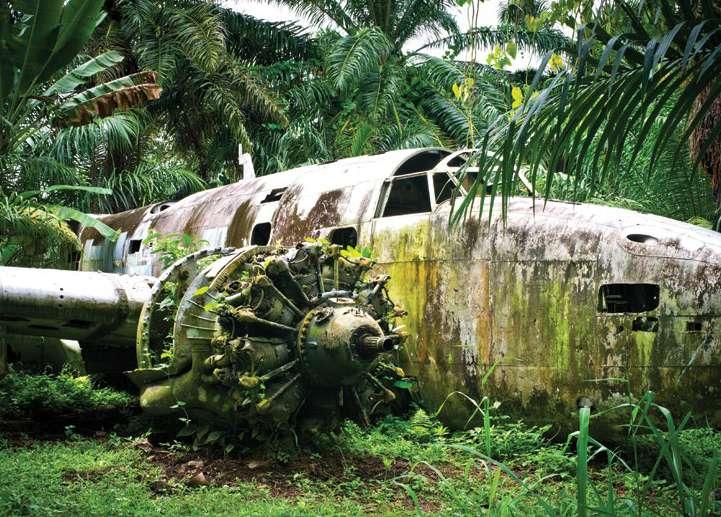

RRolling suitcases The wheel was invented in Mesopotamia around 3500 BCE for transport and moving heavy loads. However, mystery remains why it took more than 5000 years to make the first wheeled suitcase. US luggage executive Bernard Sadow had a eureka moment in 1970 while dragging a heavy suitcase and noticed an airport worker easily rolling a machine on wheels. According to the story, Sadow unscrewed four castors from a wardrobe and fixed them to a suitcase. He put a strap on his contraption, trotted it gleefully around the house and then patented the muchdelayed invention.
SSurfing During the 1980s, bush pilot ‘Crazy’ Tas Lawrie flew over the coastal town of Vanimo in his DeHavilland Twin Otter and saw “endless, perfect, uncrowded waves.” Captain Lawrie returned with his surfboard and hit the reef breaks. Before leaving, he gave away his board, sparking development of the area as an international surfing destination. A resulting feature film called Splinters won an award for best surfing documentary and further enhanced the area’s surfing reputation.
TTakeoff briefing This is a pre-takeoff review of procedures, conditions and safety between flight crew. After takeoff, the term ‘trim’ refers to the adjustment of controls to maintain level flight without continuous pilot input.
UUnited Nations In 1982–83, the UN chose Air Niugini to operate charters to the Middle East for Fijian peacekeepers. The liaison officer would board with a bag of US dollars to pay for fuel, clearances and accommodation in and out of the Beirut war zone. It’s reported that he slept on the sackful of cash to prevent theft.
VVatican For the first papal visit to PNG, in 1984, Air Niugini flew Pope John Paul II from Mount Hagen to Honiara in a Fokker F28 Fellowship aircraft. The interior was modified to cater for the Pope and his entourage.
WWrecks PNG boasts many historic World War 2 aircraft wrecks, on land, underwater and in museums. One significant site, in southern Bougainville, contains the Mitsubishi G4M ‘Betty’ bomber that carried Isoruko Yamamoto – Japan’s top wartime admiral. Yamamoto was enroute to inspect Japanese forces in the Solomon Islands when his plane was shot down by an American Lockheed P-38 Lightning in a specially planned interception.
XX-ray technology Widely used at airports around the world.
The Australian Radiation Protection and Nuclear Safety Agency says body scanners are safe and do not pose a health risk.
ZYYumi go long balus A common travel expression in tok pisin that means ‘let’s go by plane’.
ZZZ A neck pillow, eye mask and noise-cancelling headphones or earplugs can help you sleep on long flights. Choose a window seat for leaning against the window, recline your seat, and consider using a footrest. Create a sleep environment with a blanket and comfortable clothing. Perhaps include bed socks.
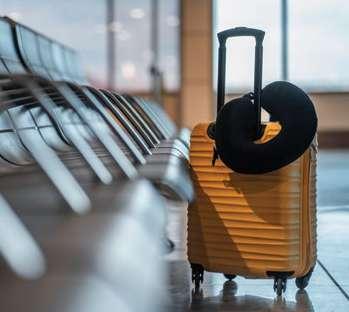
World War 2 plane wrecks in PNG (above and below); the rolling suitcase came about from a eureka moment in 1970 (below right).
SD-WAN Solution
Dedicated Account Manager

Secure and predictable performance Optimal usage of existing infrastructure and networks

Visibility and application repor ting
In today’s rapidly changing world, companies must adapt to digitization to stay competitive. Transforming from traditional WAN to SD-WAN, along with and improved productivity Contact us for more information!









THE BEST NEW THINGS

Air Niugini’s network includes some of the most exciting spots in Australasia and the Pacific, and there are always new bars, seasonal menus and hotel openings.
Australia has new waterside dining in Cairns and Sydney, and fresh-off-plan residences in an exciting new entertainment precinct in Brisbane.

The Solomons has a novel way to explore the incredible underwater world off the coast, and Fiji has a brandnew hotel restaurant serving up island classics.
In our home base of Port Moresby, we have a new boutique hotel and a roadside barbecue stall so popular that it is going to morph into a full-service bar and grill.
So, wherever you are flying we have the latest for you to check out.



by Hemingway’s is a new food option in Cairns (above, right, and next page top left).
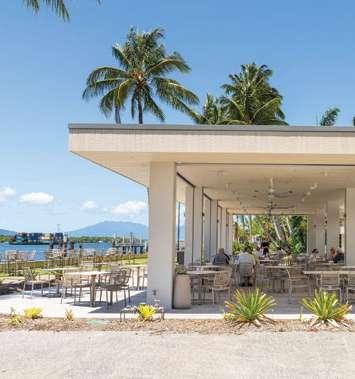
CAIRNS
SAILS BY HEMINGWAY’S This exciting addition to the Cairns waterfront offers a take on Nikkei cuisine – a fusion of Japanese and Peruvian. Opened in early 2025 by the team behind Hemingway’s Brewery, the venue has stunning marina views and a share-style menu that celebrates local produce. Dishes might be a tuna nigiri with aji amarillo or the smoky lomo saltado, a Peruvian beef stir-fry. The venue really celebrates seafood, with oysters, coral trout and nannygai all given the Peruvian-Japanese treatment of bold citrus and umami flavours. Hemingway’s Brewery is a Far North Queensland brewer that likes to do things differently but also celebrate the region, so you can try a tropical sour or a ‘schnappi altbier’, whose logo is a toothy croc. See hemingwaysbrewery.com/ eat-drink/sails-cairns.

SYDNEY
FELONS SEAFOOD Shifting its winning formula from under Brisbane’s Story Bridge to the Sydney’s Manly foreshore, Felons Brewing Co. has launched a waterfront dining room and bar focusing on the best Australian marine produce. Felons Seafood is run by Luke Bourke, who was named The Sydney Morning Herald Good Food Guide 2025 Young Chef of the Year. See felonsbrewingco.com.au.



Felon’s Seafood (above and right) has opened in Sydney.
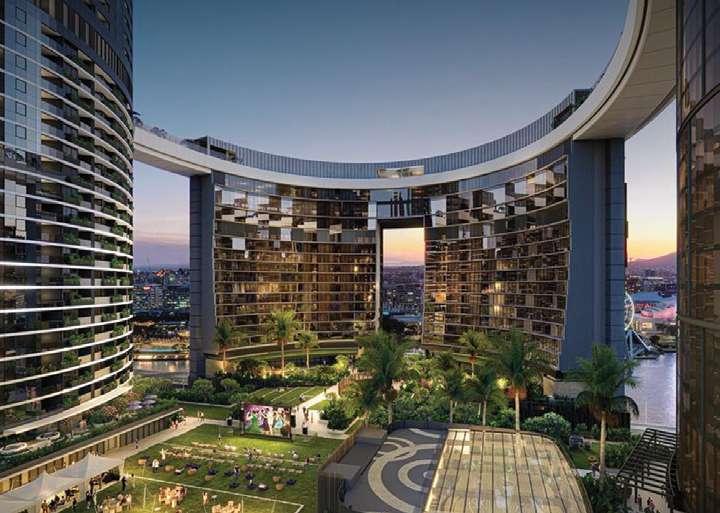
BRISBANE
QUEEN’S WHARF RESIDENCES This is the latest accommodation addition to Brisbane’s newest lifestyle precinct. Perfect for a longer stay, Queen’s Wharf Residences has 170 contemporary apartments managed by Minor Hotels with one-, two- and threebedroom options designed with subtle colours and natural materials. The curvedglass exterior of the new building makes for amazing views and there is a private balcony for each apartment that looks out onto the Brisbane River.
The stays also put you at the centre of the Queen’s Wharf action, the Queensland capital’s newest dining and entertainment hub.
Brisbane has been steadily increasing its food and hotel offerings ahead of the 2023 Olympics and Queen’s Wharf is part of that boom. The precinct includes the Star Grand hotel and casino, as well as numerous restraurants.See oakshotels.com/ en/queens-wharf-residences.

SINGAPORE
FLYING TIGER Danish lifestyle brand Flying Tiger has opened its first store in Singapore at the trendy Bugis+ shopping centre. This is just another part of the brand’s huge journey from a flea market stall in Copenhagen in the 1980s to a cult favourite across the world known for its whimsical and sustainable takes on ordinary household items.
The Bugis+ branch is a colourful place packed with homewares and games – think a Scandinavian take on Miniso – but is also a great bargain for expensive Singapore with most items coming in under S$20. The brand is in the midst of a huge Asian expansion including Indonesia, Philippines and Australia. See capitaland.com/sg/malls/bugisplus.

The Queen’s Wharf Residences in Brisbane.

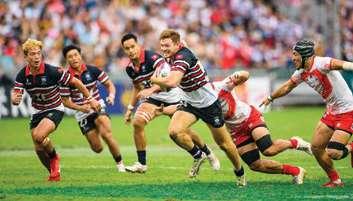
HONG KONG
KAI TAK SPORTS PARK Kai Tak recently became Hong Kong’s home of sport with the arrival of the Kai Tak Sports Park, a multipurpose sports and entertainment complex that has a mix of sporting venues (aimed at attracting international events) as well as public parks, a mall and plenty of places to dine and drink. Dining hotspots include Ming Garden Chinese restaurant, Taro & Tea and The Pantry Club, but you can also do some sports-themed shopping at ASICS, Decathlon and Salomon. Keep an eye on the website for events like dining carnivals or guided tours of the precinct. See kaitaksportspark.com.hk.
MANILA
GOXO An intimate, 12-seater bar with snacks based on Spanish asador (open-fire) cooking, Goxo is one of the hottest openings in Manila this year. The hidden bar in Salcedo Village is from the same team behind Bar Pintxos and Txoko Asador, and offers a playful menu where local talakitok fish masquerades as ‘ jamon’ and chicken wings come stuffed with sweetbreads and veal sausage. Guests sit at the small, broody bar filled with the scent of the ever-present open grill.
Enjoy a special selection of artisanal wines to go with your prixe fixe menu and get transported to Spain in Makati. See instagram.com/goxo mnl.
VANUATU
LALALA RESTAURANT & BAR Set right on Port Vila’s waterfront, Lalala Restaurant & Bar is a laidback French bistro serving up Gallic classics. The white-washed walls and blue accents make you feel like you are on the Mediterranean coast, and the menu celebrates local seafood like fresh crab and plates piled high with oysters. You can also enjoy specials like baby squid or grilled tuna out on the sunny wooden deck overlooking the Coral Sea.
For a quick drink, pull up a stool at the lively Lalala Bar for cocktails and glasses of bubbles and check the Facebook page for special events and live music.
FIJI
KOKO Recently opened on Denarau, the Sofitel’s new restaurant KOKO is focused on serving Fijian classics and celebrating the island’s amazing produce. Located right on the beach, KOKO has a relaxed oceanside charm with palm-frond-woven placemats, rustic ceramics and a mural of the Fijian islands.
Try traditional kokoda (marinated fish), koicalevu vuaka (pork cooked in banana leaf) or an indulgent whole urau (rock lobster). Cocktails are perfect for the beachside setting with the signature Koko a riff on a pina colada, adding in some coconut-infused tequila and a roasted coconut rim.
See sofitel-fiji.com/dining/koko/
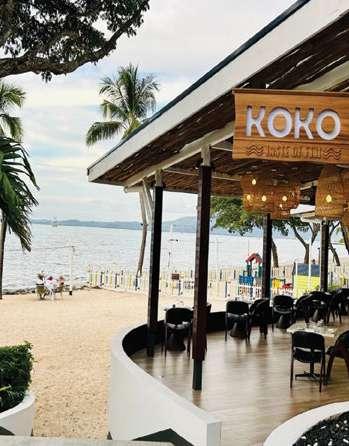




The Kai Tak Sports Park is open for business, and games, in Hong Kong (above).
PICTURES: KAI TAK
KOKO restaurant in Fiji.
PICTURE: SOFITEL

SOLOMONS
FATBOYS The Fatboys Resort, located on idyllic Mbambanga Island just a short boat ride from Gizo airport, recently added a fully certified SSI dive centre to its activities. It’s a great addition for the popular resort, which has easy access to ‘Grand Central Station’ with nearly 300 species of fish, ‘Joe’s Wall’, a gentle drift dive over a deep drop; and shipwrecks like the Toa Maru Japanese freighter. The Fatboys team includes dive professionals and boat captains who know the waters better than some of the local marine life, as well as a great onshore setup with washtubs, drying racks and a fully stocked gear room. Discover some of the newest and best diving on the Solomons. See fatboysresort.com/play/dive.
Marriott Executive Apartments Port Moresby, a waterside property close to the heart of the city, is set within the vibrant mixed-use development of Harbourside South. Boasting 88 luxury apartments with premier hotel services, Marriott Executive Apartments are suitable for both short and long-stay travellers.
Guests will enjoy oceanic views as well as leisure facilities offered within the greater Harbourside Precinct. Various bedrooms and penthouses are available, each promising the space, ambience, and privacy of residential living. Guests also have access to the Executive Boardrooms and the indoor and outdoor venue space on the 11th floor, providing stunning views. Gym membership including lap pool access is now available.
Use your Membership with us
Guests are welcome to use their Bonvoy Membership during their stay. Reserve your room online at marriottexecutiveapartments.com
Marriott Executive Apartments ® Harbourside South | Stanley Esplanade, PO Box 1 | Port Moresby, Papua New Guinea (+675) 7090 8888 | marriottexecutiveapartments.com
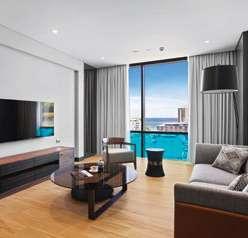
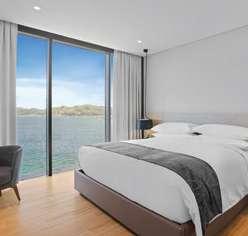
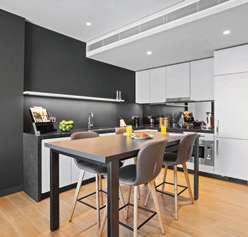

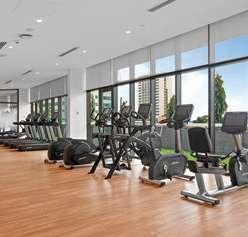
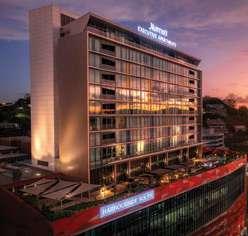
Fatboys Resort in the Solomon Islands.
MAPAI GROUP
YOUR TRANSPORT AND LOGISTICS SOLUTION PROVIDER IN PAPUA NEW GUINEA AND BEYOND
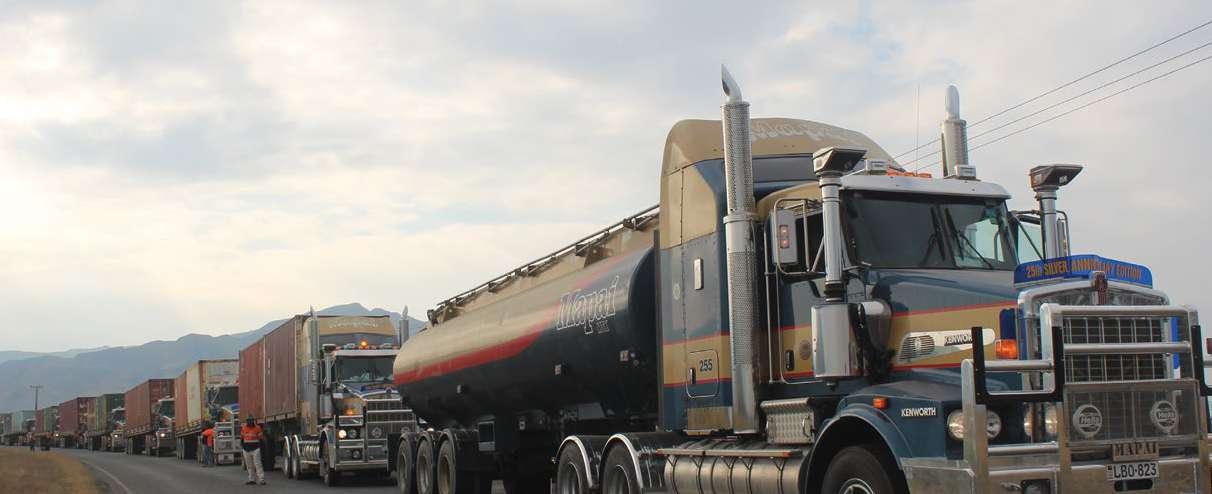
Today the fleet has grown to be one of the most modern fleets of prime movers in PNG, Transporting of FMCG to hazardous materials (for the mining sector), to food commodities delivered to major centers.
The Mapai fleet is made up of an ever reliable modern fleet of prime movers, and is backed up by a solid rescue and recovery team strategically placed in Goroka, Mt Hagen and Lae. These fleets are backed with trailers specifically designed to withstand the rigors of the unique conditions of the Highlands Highway including fuel tankers and widening floats for over dimensional loads. Our internationally recognized systems and processes support our products and service offerings and backed by years of industry experience in our people.
Transport Customs And Freight Forwarding Logistics
No matter whether you need to move hundreds of containers along the Highlands Highway or like to send a single load throughout the Momase Region
Mapai Transport Ltd. provides ad-hoc and contracted solutions that suit your needs. With the latest technology fitted to our trucks and containers you’ll receive value information and insights for your supply chain – 24/7.
FCL, LCL, FTL, LTL, Bulk, Oversize – speak to our Customer Service today to get a quote.

We know that every customer and industry is unique. Our logistics experts have the expertise to tailor solutions matching your needs. Whether it is within Papua New Guinea or beyond.
For over a decade, the most successful companies in Papua New Guinea trust our services in handling their goods.
And we are dedicated to continue developing the best solutions and services for your needs.

Mapai Transport has grown from humble beginnings in 1987 with one truck and Jacob Luke’s desire to be the preferred transport operator on the Highlands Highway.
In an ever-changing world of regulations and policies, intricacies of Import- and Export procedures can be challenging.
Mapai Logistics Ltd has a team of dedicated employees that concentrate on providing seamless, transparent and timely services to facilitate the import and export of goods into and out of Papua New Guinea.
Connected directly to PNG’s electronic Customs System “Asycuda”, we handle your import/export duties in a secure and efficient way.
Contact Details Address : 4th Street JT’S Maman Anda Building Lae Morobe Province 411 Papua New Guinea Phone Number : +675 7092 2000
information@mapaigroup.com https://www.mapaigroup.com/

TRAVELLER
PORT MORESBY
CITI BOUTIQUE HOTEL New to Boroko is the Citi Boutique Hotel, just minutes from Jacksons International Airport and next door to the national football stadium. The 59 rooms include flat-screen TVs, mini fridges, blackout drapes and rainfall showers, and the small number of rooms means that service is intimate and personal. Guests can dine at the on-site Lahara Restaurant with dishes like rack of lamb, while the rooftop bar offers views over Boroko and the stadium. Citi Boutique Hotel is a good option for business travellers who are looking for a stay with a little more charm, or sports fans in town for a big game. See lahara.citigrouppng.com.
ABUS NA KUMU Former rugby star Richard Mark started Abus Na Kumu as a simple roadside barbecue stall selling smoky meat steeped in a secret homemade marinade and kumu (local greens). Rumour is that the barbecue restaurant is morphing into a bricks-and-mortar affair with a move to Waigani.
REVELRY CLUB Ruta’s Place near Boroko has a new nightspot with the opening of Paradise Revelry Club, a late-night bar and live music space that offers a range of entertainment from house DJs to showing rugby league on the big screen. The club also offers a host of live performances from house band The Gentlemen as well as art exhibitions and fashion shows.
New to Boroko is the Citi Boutique Hotel, just minutes from Jacksons International Airport and next door to the national football stadium.
The hotel is a good option for business travellers who are looking for a stay with a little more charm, or sports fans in town for a big game.
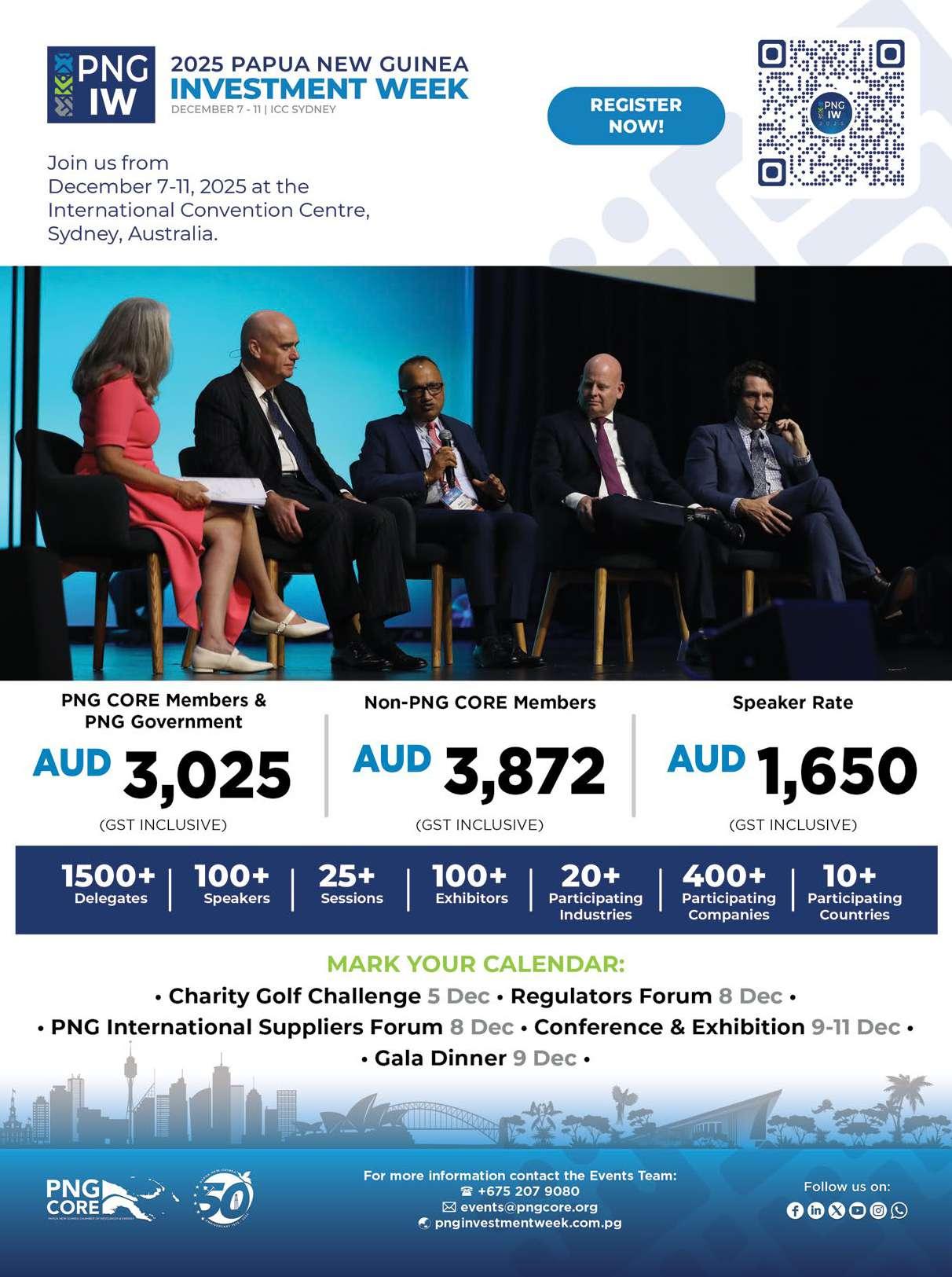
BY
HOTEL REVIEW: PACIFIC GARDENS, GOROKA, PNG
Tel +675 7100 3400, Mokara Street, Komiufa Road, Goroka, see facebook.com/pacifichotel
WHO STAYS? Business travellers, tourists, transit travellers and long-term guests.
HOW BIG? 41 rooms; two apartments
COST PGK350–750 for rooms and PGK850 for apartments.
CHECK IN 2pm
HIGHLIGHTS The natural environment surrounding the hotel and the great food.
NEARBY National Performing Art Troupe (more commonly known as Raun Raun Theatre), The University of Goroka, the JK McCarthy Museum, Mount Gahavisuka Provincial Park and the Mount Kiss Lookout.
Wi-Fi in rooms:
TV:
Air conditioning in room:
Swimming pool:
Room service:
Free airport transfers:
Business centre:
Breakfast included in room charge:
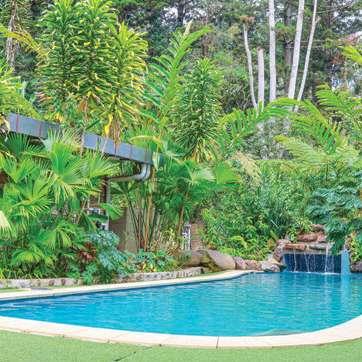
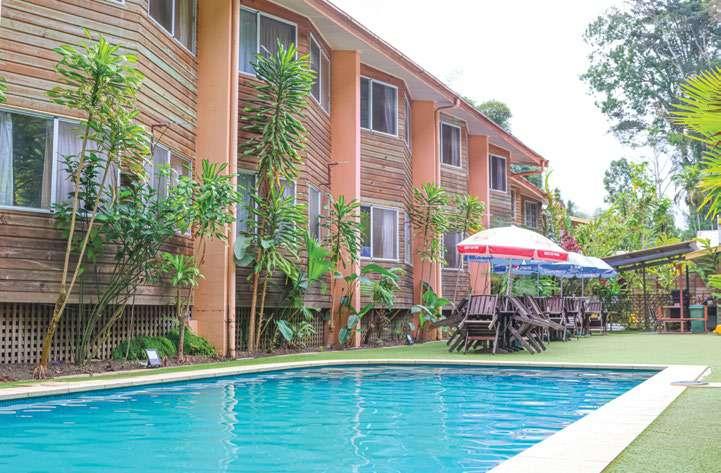
LOCATION
The hotel is a four-minute drive from the airport. In town, check out the main market, which is filled with some of the best fresh produce the country has to offer. Don’t forget to visit the famous bilum market for a souvenir to take home. The town’s annual Bilum Festival usually takes place in September. The Goroka Show is also in September and is about a 10-minute drive from the hotel, but be sure to book early because rooms are in high demand during the show.
the place
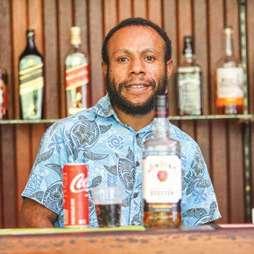
Built in 1986, the hotel celebrates Eastern Highlands culture with paintings and carvings. The hotel is in a serene environment, surrounded by lush gardens and trees set on eight hectares. Guests can enjoy a quiet morning coffee with garden views and the soothing sounds of a nearby mountain stream.
ROOMS
There are six styles of accommodation –including separate bungalows – all with
private bathrooms (with toiletries) and flatscreen TVs. Spacious and comfortable, the rooms are well furnished with some offering a work desk and kitchenette. The threebedroom apartments have kitchens and dishwashers.
FOOD AND DRINK
Guests can dine at both the restaurant and bar. They offer Asian and Western cuisine as well as a pizza menu. There is a set breakfast menu, and lunch and dinner specials change daily.
WHAT GUESTS LIKE
“This is the nicest hotel in Goroka. The ambience is peaceful and very beautiful, with a nice outlook over jungle, a stream and a pool. There’s also a pet cassowary.”
– Tripadvisor
“This was my first visit to Goroka, and I definitely made the right choice when I booked the Pacific Gardens Hotel. The staff were more than accommodating and the restaurant was fantastic.” – Expedia
MARY TAO
PICTURES: DANIEL UNDABA
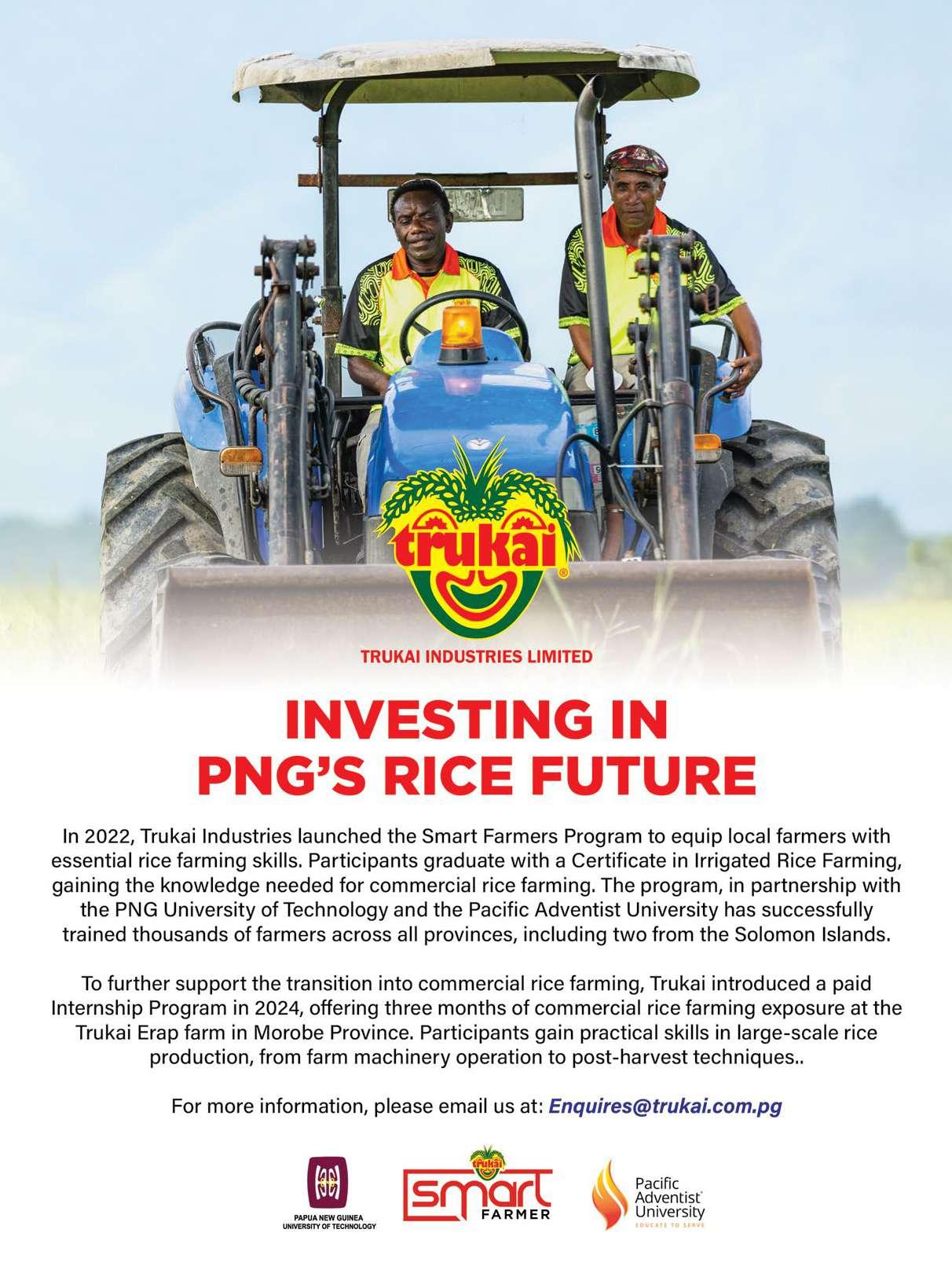
BY JOHN BROOKSBANK
time traveller
Hugo’s Building, 1980s
In the late 1970s and early 1980s, Tabari Place in Boroko was the place to be, and to be seen, especially on a Saturday morning. Nestled next to the Boroko post office was a small shopping mall constructed by Hugo Berghauser. The German-born entrepreneur spent most of his adult life in PNG, from 1960 gradually building up a variety of enterprises including Sapphire Smallgoods, a piggery, and a canning factory that produced favourites such as Ox & Palm corned beef. As a naturalised citizen, he entered politics in 1987 and was knighted in 1989, serving as Minister for Tourism and Minister for Civil Aviation. He developed several properties around Port Moresby, including the Papua Hotel. This was leased to fellow parliamentarian Sir Robert Suckling who ran it as the Pink Pussycat, one of the town’s first nightclubs. Sir Hugo, 91, died in Wewak in August where he had acquired the Windjammer Motel.
If you have a photo that may be suitable for Time Traveller, email paradise@ businessadvantageinternational.com.











FIJI A SPECIAL REPORT
BOOM TIME

Investors in Fiji’s tourism sector are building and upgrading, with more hotel rooms being created than there are currently in all of PNG.
“If you own a hotel in Fiji, you are doing really well,” observes the outgoing Chief Executive Officer of Tourism Fiji, Brent Hill. As such, it is no surprise that many hotel owners are reinvesting, leading to an unprecedented surge in construction activity throughout the country.
One project in particular is aiming to reframe the image of Fiji as a tourist destination.
Vatu Talei (The Jewel) is under construction adjacent to the Sofitel on Denarau Island.
There are also major works going on next door, where the Westin Fiji Golf Resort & Spa is due to open in early 2026.
“The renovated Westin is going to be a game-changer for Fiji, raising the bar in terms of customer experience,” Neeraj Chadha, Vice President Pacific Islands for Marriott International, says.
“It will provide excellent accommodation and outstanding investment in public areas, including a fabulous Japanese-Peruvian beachside restaurant, while still retaining Fiji’s quintessential charm.”
With Denarau Island close to capacity, the Wailoaloa Bay area, close to Fiji’s main international airport at Nadi, is emerging as a new tourism hub.
The Wyndham Garden Resort opened in 2024, while IHG’s sprawling Crowne Plaza Fiji Nadi Bay opened with over 300 rooms in 2024 (on the site of the former and smaller Pullman Nadi Bay).

Finally, one of Fiji’s best-known entrepreneurs, Hari Punja, is behind the Rydges Wailoaloa, a new build beachfront resort that will open in late 2026.
Meanwhile, on nearby Naisoso Island, Radisson Blu Mirage Resort will comprise 144 beachfront apartments and its own marina. Another international operator with a strong presence in Fiji is Hilton Hotels. Besides its signature Hilton Fiji Beach Resort on Denarau (which can accommodate over 1000 guests), it also runs the DoubleTree by Hilton Resort –Sonaisali Island.
Hilton’s long-term commitment to Fiji’s tourism growth is best reflected in the debut of the Hilton Garden Inn brand in the country – a milestone development in the middle of the national capital and business hub, Suva. The brand-new property is scheduled to open next year.
“There is currently a supply issue with hotel rooms in Suva,” notes Carey Osborne, General Manager for Hilton in Fiji. “With 178 rooms, this will be the largest property in town and will cater to the corporate traveller, with super-fast Wi-Fi and other elevated touches in a great location.”
Kamal Chetty, CEO of Investment Fiji, explains that some of this new wave of investment is also reaching some less developed parts of the country:
“In Rakiraki (in the north of Viti Levu), the 100-room Wananavu Resort is being built by Rups, a local investor. And two new hotels
are being planned in Lautoka, which doesn’t usually see a lot of activity.”
This geographical dispersion is likely to increase given the significant upgrades planned for Fiji’s airport infrastructure.
“Realistically, there are probably 1500 (rooms) that are starting soon, or already underway,” sums up ANZ Fiji Country Head, Rabih Yazbek. Even that, he thinks, is unlikely to be sufficient to meet future demand.
It is no surprise, therefore, that the next phase of projects is already on the drawing board.
How
often do you hear of a hotel developer working on four separate projects at once?
“We’re not stopping at The Jewel,” says Vincent Macquet, Area General Manager for Accor Hotels Fiji. “We are planning a four-star, mid-to-long-stay resort in Wailoaloa and a four-star hotel in Denarau. We are also involved in a four-star hotel project on the Coral Coast, bringing our total investment to F$475 million (PGK875 million). How often do you hear of a hotel developer working on four separate projects at once?”
An artist’s rendering of the Vatu Talei Resort (above); Accor’s Vincent Macquet (inset).

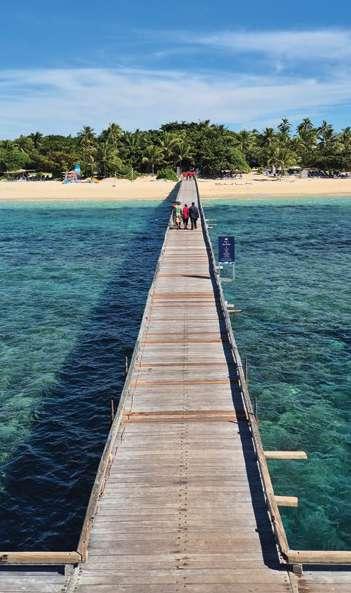
A DAY DREAM
Just 25 minutes from Port Denarau, Malamala Island is billed as the world’s first island beach club, and it lives up to the hype. White sand, turquoise water, private cabanas, cocktails on call … it’s a dreamy paradise for daytrippers, an island with a Robinson Crusoe vibe.
The ferry load of guests on the way over is a friendly mix of families, friendship groups and solo travellers arriving with the same goal: to soak up a perfect day of tropical island bliss.
While the poolside bar quickly finds its groove with a DJ spinning the latest tracks and a fun party atmosphere, I peel off in the opposite direction. My beachside cabana on the quieter side of the island is
shaded by palms and just steps from the lapping, crystal-clear water.
With a good book in one hand and an icy drink in the other, I let the world slow down.
Lunch is a delicious seafood basket brimming with freshness and my personal waiter is warm, attentive, and seems to appear just when you need something, whether it’s a drink, food or snorkelling gear.
Malamala Island isn’t an overnight escape, but it doesn’t need to be. It’s a perfect daytrip destination that leaves you sun-kissed, well-fed, and reset. (Unless, of course, you choose the party side of the island.)
See malamalabeachclub.com.
–
ROBBIE MILNE
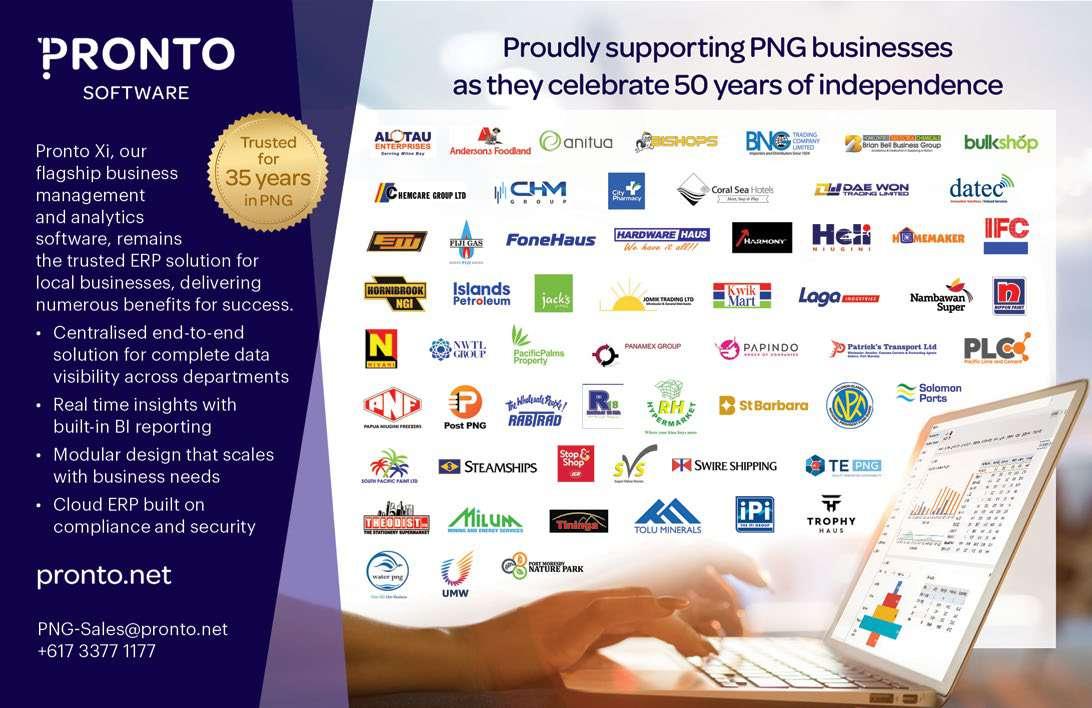



TAKING FIJI TO THE NEXT LEVEL
Fiji’s tourism industry has emerged out of the COVID-19 era stronger than before and is looking at how to future-proof itself in an everchanging market.
It’s a measure of how far Fiji’s tourism industry has come that, when we visited in March 2025, there was some disquiet among business leaders that visitor arrivals were slightly down on the year before. Further inquiry, however, revealed a sector in excellent shape, facing relatively few headwinds and with a compelling growth strategy.
The year 2024 was a record one for the industry as a whole, with over a million visitor arrivals and robust profit margins.
“We are in an enviable position at the moment,” says Brent Hill, outgoing CEO of government agency Tourism Fiji.
“We have really high occupancy rates and really high average daily room rates.”
Much has been made of Fiji’s lightningquick reopening at the end of 2021, after its borders had been closed for 19 months due to COVID-19.
“We expected 30 per cent occupancy initially, but within three months were at 90 per cent,” says Vincent Macquet, Area General Manager of Accor Hotels Fiji.
While this campaign was an outstanding effort, both of marketing and logistics, it does not explain why the sector has remained so buoyant since.
According to Neeraj Chadha, Vice President Pacific Islands for Marriott International, the sector was just ready to go to the next level.
“Upon reopening, Fiji had several strategic advantages that elevated its position in the global tourism landscape. In addition to a well-executed reopening plan, many hotels – whether by design or fortunate timing – had recently completed renovations that significantly enhanced the standard of accommodation.
“Another pivotal factor was the government’s support in rationalising import duties, which had a positive impact on operational costs.
“The result was a markedly improved tourism product and guest experience, offering far greater value for money.”
If nothing else, the sense that the recent boom may have finally plateaued is sharpening the industry’s focus about where the next phase of growth will come from.
The most obvious answer is adding more room inventory to meet current demand. This is not simply more of the same kind of rooms but also alternative configurations that appeal to new market segments – such as luxury (i.e. beyond five star) and self-catering units that are suitable for longer stays.
As the sector evolves, it is also focused on giving visitors more choice.
“(Our message is that) Fiji is not just beaches and resorts, it’s also hinterland experiences, cultural experiences and even whitewater rafting and ziplines through jungle,” enthuses Hill.
“We are targeting what we call ‘contributing tourists’: those who engage with Fiji, take part in the culture, engage in sustainability initiatives, and learn something while they are here.
“The growth in experiential tourism is one of the biggest trends in the global leisure market,” adds Macquet.
“We need to create (even) more reasons to come to Fiji.”
We are in an enviable position at the moment.
Another segment with lots of growth potential is MICE (Meetings, Incentives, Conference and Exhibitions).
“The MICE segment is critical for our seasonality,” says Chadha.
“With its enhanced infrastructure, high quality accommodation, staging technology, improved international air connectivity and customisable daily program, Fiji offers a compelling environment for business events.”
“Destinations like Denarau Island, where we have three of our five properties, and the Coral Coast can cater to larger group sizes.”
The Fiji Marriott Resort Momi is an ideal destination for medium-sized incentive and conference groups (main); Tourism Fiji’s Brent Hill (inset top); Marriott’s Neeraj Chadha (inset above).
LIFESTYLE, CULTURE, SPORT, ENTERTAINMENT


IN SEARCH OF THE
BIRD PARADISE
Birder and author Mike Dilger (right); a bird of paradise (main); birdwatchers at Rondon Ridge (top right).
British naturalist and BBC wildlife expert Mike Dilger realises a boyhood ambition on a birding tour of PNG.

ABe prepared for something special, teased our guide.

s a teenager in Britain flicking through Bruce Beehler’s 1986 book Birds of New Guinea, it was the illustrations of the birds of paradise that flew straight off the pages and into my imagination. Further inspiration was provided by Alfred Russel Wallace’s The Malay Archipelago, which transported me to a land of astonishing birds with unparalleled avian beauty.



Finally, last year, I travelled to Papua New Guinea to see the fabled birds for myself.
PNG is synonymous with birds of paradise, hosting 33 of the world’s 45 species. About 26 also reside in the Indonesian autonomous province of West Papua (or the western half of New Guinea), with a handful either in Northern Queensland or remote islands along the Malay Archipelago.
Birding in PNG has been touted as the ‘toughest birding you’ll ever do’, due to difficulties in reaching remote birding locations and obtaining permission to enter tribal lands.
The terrain, particularly in the Central Highlands, can be steep and rugged, while birdwatching in dense, wet tropical forests is never easy. It doesn’t make matters any easier that the bird of paradise is a shy and retiring type.
Having waited close to 40 years to come face to face with a bird of paradise, it seemed I’d be made to wait a little longer after arriving in Port Moresby.
Barely had our group landed from London before we were whisked off to the island of New Britain in the Bismarck Archipelago, about 90 kilometres to the northeast.
While the island contains around 14 endemic species, it sadly does not host a single bird of paradise.
Close to the coastal capital of Kimbe, our lodgings had been originally constructed for the world-class diving positioned here within the celebrated Coral Triangle. But instead of divers, this time the hotel was hosting birders.
1 A common smoky honeyeater.
2 Mike Dilger.
3 A Pacific baza.
4 Stella’s lorikeet.
5 Brehm’s tiger parrot.
6 A PNG sunrise in birding country.
7 Belford’s melidectes.
With a local bird guide duly procured, we were soon up and running. In our full day’s birding on the island, we managed to log an astonishing six species of kingfisher, together with a couple of owls confined to New Britain, including the highly threatened golden masked owl.
Back on the mainland, I’d been promised the forests in PNG would be different, as two-thirds of the country is still classified as forest – of which a whopping 85 per cent remains untouched. Nowhere is this quality forest better exemplified than in the Central Highlands, close to Mount Hagen. Furthermore, these montane forests are considered one of the island’s biodiversity hotspots for our main quarry: birds of paradise.
On our Air Niugini flight from Port Moresby to Mount Hagen I was able to appreciate what that 85 per cent looks like from the air. Mount Hagen is in the fertile Wahgi Valley, with the city’s floodplains cultivated for a range of fresh produce. But the city is hemmed in by a series of high tree-covered ridges that have barely changed in tens of thousands of years.
Our first birdwatching destination, after a short drive into the hills, is Kumul Lodge. Surrounded by forest, Kumul is located about 3000 metres above sea level and tucked into the dramatic flanks of the extinct Mount Hagen volcano.
The Kumul owners have cottoned on to leave out fruit for the birds, much like we do with peanuts and sunflower hearts in Britain – supposedly making it the birding equivalent of ‘shooting birds of paradise in a barrel’.
Birding in PNG has been touted as the toughest birding you’ll ever do.
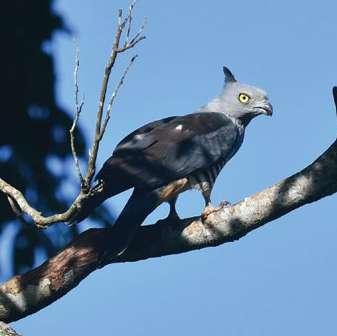
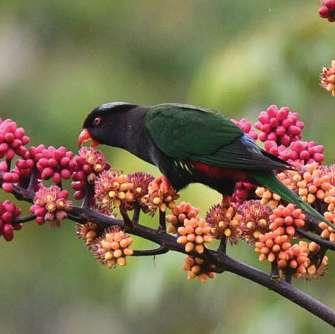


“Be prepared for something special,” teased our guide Max, as we walked through the lodge’s dimly lit corridors into a room doubling as a dining room and a bird hide. Peering through the slats, the view instantly caused hairs to stand up on the back of my neck.
The stage resembled a series of fruit-laden bird tables connected by horizontal wooden perching bridges, and I didn’t need my book to tell me I was looking straight at a male brown sicklebill tucking into a papaya on the right, while a male Stephanie’s astrapia was expertly extracting pineapple pulp to my left.
My first impression was how easy it had been to bag my first birds of paradise, as I’d fully expected to put in blood, sweat and tears for these birds. My second thought was to realise how large both birds were –with an estimation of close to a metre from crown to tail tip. Finally, and with the sun beating down on the birds, I was able to revel in the iridescence of both male birds’ plumages – when caught at the right angle, they were dazzling.
Famed for their unique display, the two closely related black and brown sicklebills are endowed with feathery epaulette-like tufts, which can be raised up, over and behind their heads to transform them into very un-birdlike and scimitar-shaped crescents. But while the astrapia is not quite as capable of the levels of transmogrification the sicklebills can manage, it more than compensates by a scintillating green sheen across its head and chest that would see even South America’s hummingbirds reaching for their sunglasses.




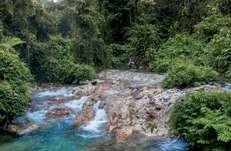
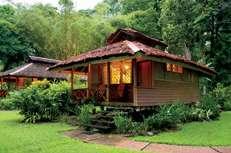
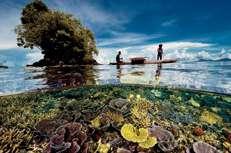
Also hopping around was a female brown sicklebill, and while not unattractive in her own right, was nowhere near as glamorous as her male counterpart. The reason, of course, as to why the males look and act like they do is down to these powerfully fussy females. Over countless generations, the females’ preferences for what they find attractive has seen the males abandoning utility in favour of extravagant beauty. In essence, how you look and display appears to trump other important behavioural facets, such as a mastery of flight or an ability to hide from predators.
Added to that, New Guinea has a complex geological history, which has forced birds of paradise to endure successive periods of isolation over the last 20 million years. And when this physical isolation, even over relatively small areas across the island, is combined with the intense sexual selection driven by the females, this directly leads to the stunning levels of diversity present today.

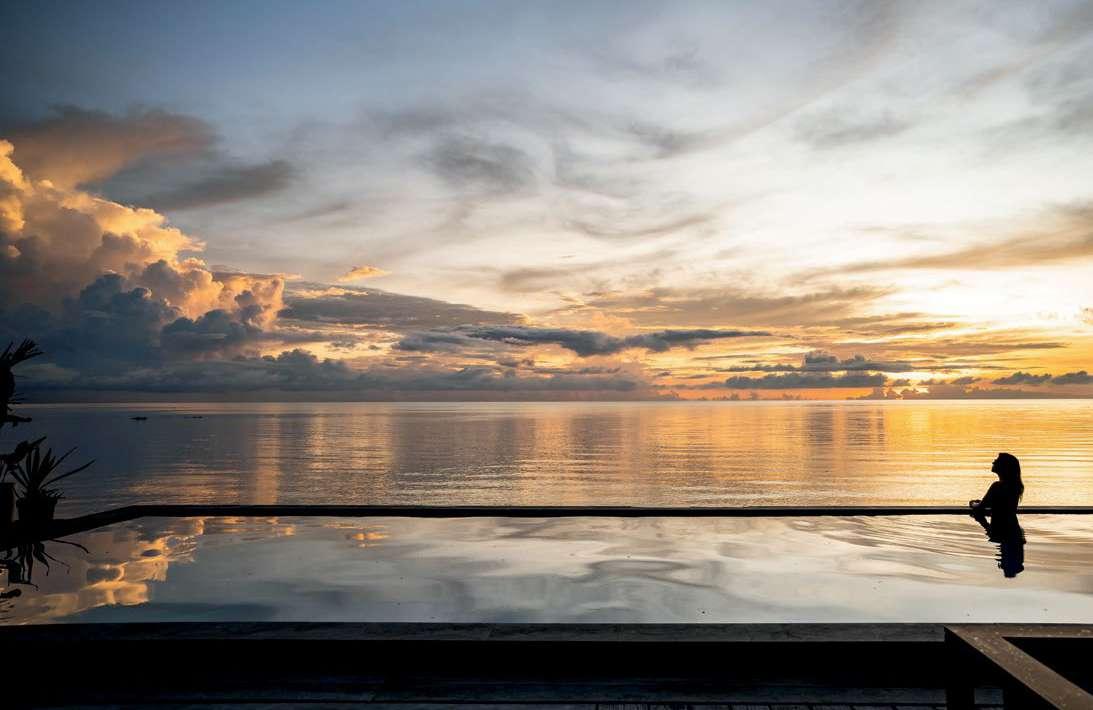




8 Looking towards the Wahgi Valley.
9 A brown sicklebill. 10 A red-collared myzomela.
This first taste of the island’s birds of paradise had given me an instant craving for more, which I was able to indulge the following day at another lodge close by. Magic Mountain Nature Lodge is at slightly lower elevation, which provides the visiting birder with a subtly different suite of birds to enjoy.
Here, a similar feeding station instantly delivered the spectacular ribbon-tailed astrapia, with a subtly different iridescence to the closely related Stephanie’s astrapia. But the ribbon-tailed astrapia could be considered no more than a warm-up act to surely one of the island’s most desired species – the King of Saxony.
My next discovery was that one of the best ways to find a number of the trickier birds of paradise, such as the celebrated King of Saxony for example, is not to head off randomly into the nearest patch of forest, with more hope than expectation, but to be targeted in your approach. Employing
an experienced local guide who knows the location of the bird’s display perches is crucial. With this in mind, our new guide Peter led us away to a prominent line of trees at the forest edge.
Double-lotioned up – to keep the sun and the mosquitoes at bay – we constantly and desperately scanned for any movement in the canopy, but it was the male’s unique utterances we heard first.
Sounding like a cross between a hyperactive cicada and bad radio static, the call quickly helped us pinpoint the male’s precise location in the canopy. No larger than a European starling, the male has a black back, head and bib, which contrasts with a yellow belly and an orange wing bar. But the body plumage is the last thing anyone tends to notice, as our eyes were immediately drawn to the pair of outlandishly long and remarkable head plumes protruding from either side of the male’s head. Resembling the antennae of a long-horned beetle, these
remarkable feathers appear to extend for over double the bird’s body length and are wafted around in extravagant fashion to impress any watching females.
It’s quite a surreal moment coming face to feathers with a bird you’ve waited to see all your adult life, and I have to say the King of Saxony did not disappoint, flapping straight into my top five of the 3000 odd species of birds I’ve already seen.
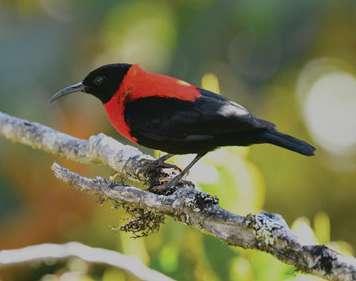


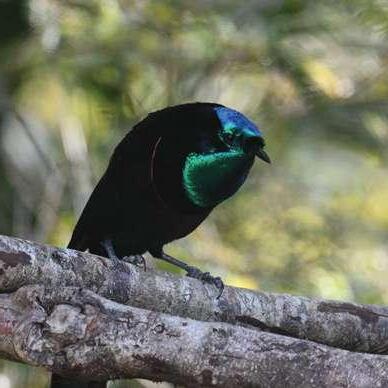
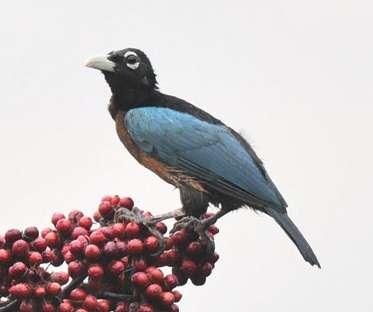
of Saxony had to be kept short as we headed back across the valley to our next destination. Rondon Ridge has long been celebrated as one of the best locations for birds of paradise in PNG. And even though the lodge is no further than 50 kilometres from the forests we’d previously visited across the Wahgi Valley earlier, the physical separation of
the two ridges once again results in a very different assemblage of bird species. Upon meeting our new guide, Joseph, at dawn, he explained that another tip for finding a selection of the trickier birds of paradise is to understand their dietary requirements. As many are dedicated frugivores, this means the smart move is to “follow the fruit”. Prior to our arrival, Joseph had already pinpointed some fruiting


trees that looked ripe for exploitation and suggested that instead of chasing avian ghosts in the dense and uncompromising forests, we should let the ghosts come to us. When it comes to searching for birds in tropical forest, patience is essential. After an hour spent quietly watching and waiting, our vigil had managed to produce a grand total of two birds: the impressive yellow-browed melidectes and the slightly less impressive endemic Papuan white-eye. Despite both species being ‘lifers’ to virtually everyone in the group, they were not, however, the reason we’d travelled halfway around the world.
With Rondon Ridge over 2000 metres in altitude, the cold morning air had also caught us by surprise, and I berated myself for not having opted to wear my fleece. So, with shivering added to our fidgeting, our impatience led to us openly debating whether it might be best to stick (stay) or twist (return to the warmth of the lodge). But Joseph implored us to persevere, and we





were grateful he had when a vision in blue suddenly flashed past, before landing in a fruiting tree for a spot of breakfast.
The male blue bird of paradise is not only one of the world’s most beautiful birds, but also one of the easiest to identify, due to a combination of electric blue wings and tail, amber flank plumes and long black tail-streamers, all set against glossy black upperparts.
It is however the bird’s incredibly distinctive broken white eye-ring and ivory white bill that initially draws your attention. Renowned for an astonishing display that entails hanging upside down, the male will then proceed to spread out and shimmer his flank plumes, before tossing his head from side to side –like a manic metronome.
While our luck didn’t extend to the display, we were nevertheless thrilled with our frontrow seat as this bird quickly gulped down a few berries before melting back into the forest. And to our utter joy, birds of paradise
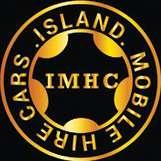

ISLAND MOBILE



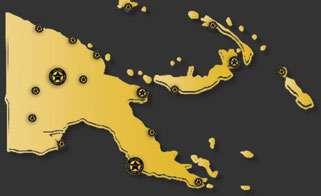
11 Stephanie’s astrapia.
A blue bird of paradise.
A brown sicklebill feeding on papaya.
suddenly began appearing like buses, as the same tree then played host to a male greater lophorina. Perhaps best known either by its old name of ‘superb bird of paradise’, or it’s nickname of ‘smiley face bird of paradise’, this bird’s scarcely believable display was first filmed for BBC’s Planet Earth I series in 2006.
Now split into three closely related species, the male lophorinas all display in a similar manner, and possess the ability to not only raise an iridescent blue breast shield, but also hoist an array of jet-black nape plumes to form an erect black cape. This striking costume is topped off with two small patches of iridescent blue feathers positioned above each eye, giving the impression of a slightly demonic but mesmeric grinning face.
The males then usually select a horizontal log as their dance floor of choice but witnessing this rarely observed display usually requires weeks spent in a tiny, cramped forest hide. Nonetheless, we were treated to the first act upon the arrival of one of the brown and streaky females, which instantly prompted the male to raise his brilliant-blue breast-shield feathers, to form what superficially looked like a huge iridescent moustache.
As our trip neared its end, we’d scored far more hits than misses – and let’s skate over our biggest miss, which entailed spending over two hours unsuccessfully waiting for a noisy king bird of paradise to make an appearance at the lowland site of Lake Murray.
Back once again in Port Moresby, we still had one remaining mega on our hit list. Universally known as PNG’s national bird, the raggiana bird of paradise was named after an obscure 19th-century Italian marquis called Francesco Raggi, by the naturalist and explorer Luigi D’Albertis. Every inch the quintessential bird of paradise, the males have outrageous orange-red candy floss flank plumes, yellow heads and iridescent green throats – in essence this is a bird that’s dressed to impress.
The raggiana is known as a lekking species, which sees a number of males turning up at dawn and dusk, to display at a traditional and long-established arena in the forest canopy. This twice-daily ritual has been fine-tuned

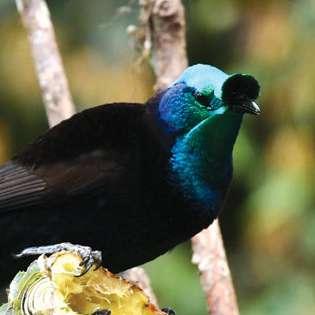
We were thrilled with our front-row seat as this bird quickly gulped down some berries before melting back into the forest.
over millennia with the sole purpose of enabling the fabulously handsome males to compete for the attentions of any fastidious females that turn up looking for love.
Just a short drive from Port Moresby, and along the appropriately named Bird’s Tail Peninsula, lies the National Park of Varirata. It’s by far the most visited nature reserve in the country, and here was the first time I’d felt ‘on’ the beaten path since our arrival. Pausing at the main carpark, and with dawn breaking, a brief and impromptu spot of birdwatching revealed six species of fruit doves, alongside four different kingfishers and kookaburras. But with little time to waste, we headed straight to the raggiana lek (an assembly area where birds display courtship behaviour).
Visiting bird leks can frequently involve a long and arduous walk in the pre-dawn darkness, but on this occasion access was straightforward and all we had to do was step off the access road and into the forest, before letting the sound direct our gaze towards the noisiest section of canopy. Timing-wise, it looked like we’d nailed it with the lek appearing to be in full swing, and as our group watched on in awe, we were able to witness two males competing to reassert their respective positions in the pecking order. Their ostentatious display was sensational and entailed both birds fluffing out their candy-floss flank plumes while lowering their iridescent heads and frantically flapping their wings, all while uttering otherworldly calls.
The raggiana marked our 10th and final bird of paradise in just a week. Standing among the trees I was that teenage birdwatcher again, but this time witnessing these wondrous birds for real.
Mike Dilger is leading a 19-day birding trip to PNG in September 2026 with British-based Wildlife Worldwide. The trip will run in conjunction with PNG-based Trans Niugini Tours. See wildlifeworldwide.com.
Rondon Ridge.
Stephanie’s astrapia.


NAVIGATING 50 YEARS OF SUCCESS.

Since our incorporation in 1975, Consort Express Lines has consistently delivered goods that drive Papua New Guinea’s economy, connect our communities, and sustain our people. We celebrate five decades of dedication to our nation.

Our Journey
1975
Incorporated as a business with IPA, backed by a strong commitment to local ownership through a PNG-based Board of Directors.

1980s
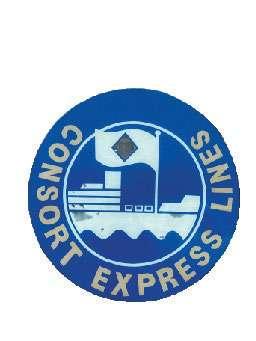
The company dedicates the decade to establishing reliable service. Early strategic investment from key regional partners solidifies Consort’s position as a trusted name in coastal logistics.

1990s
Consort achieves positive financial performance, enabling a strategic shift to vessel ownership. In 1999, the company purchased its first vessel, Gazelle Coast, a 5,400 DWT container ship.




Under the command of Captain Sod Baim, MV Madang Coast pulls away from Nodup village after taking on board residents stranded by the volcanic explosion with the smoking cone of Tavurvur in the background. - Rabaul, 1994
Weekly & fortnightly sailings throughout Papua New Guinea
Kiwai Cheif.
KIETA





2000s

Steamships Trading Company increases its shareholding, creating a strong, unified ownership structure that powers Consort's continued growth across all routes.
2010s
The decade marks route expansion, including liner trade between Lae and Manus. The fleet expands, culminating in Steamships acquiring a 100% stake in 2019, cementing Consort as a core national asset.




14 Ports of call
500+ Employees





18x PNG flagged vessels
242 PNG seafarers
7 Female seafarers


2020s
Focusing on expanding the fleet, Consort undertook a PGK130 million investment program to renew its fleet, enhance its liner service offering and improve reliability.
2025
Consort celebrates 50 years! consort.com.pg
5,400x Dry containers
400x Refrigerated containers
Over K7 million invested in crew training since 2019
Gazelle Coast
Papuan Coast
Nakanai Coast
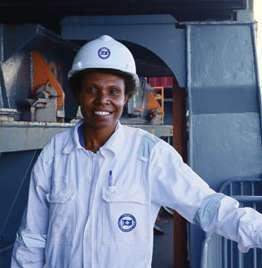
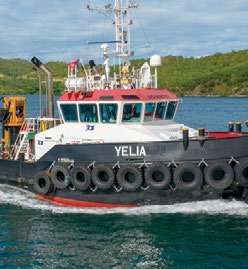

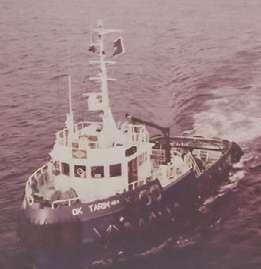
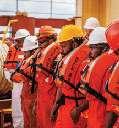
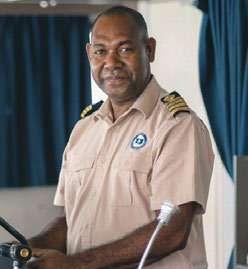

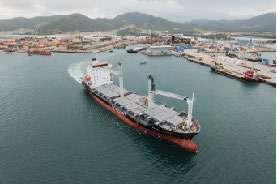
NAVIGATING INTO THE FUTURE.
Consort Express Lines remains committed to setting international standards for safety, reliability, and service innovation in Papua New Guinea. We thank our customers, partners, and community for trusting us to deliver yesterday, today, and tomorrow.
The celebration of our five-decade legacy is really about establishing a robust platform for the future.
Our path ahead is clear: we are committed to building upon our foundation as PNG’s most reliable, safest, and dedicated shipping partner, ensuring the next 50 years uphold the same level of service to our customers and country.
Alistair Skingley General Manager, Consort Express Lines
consort.com.pg


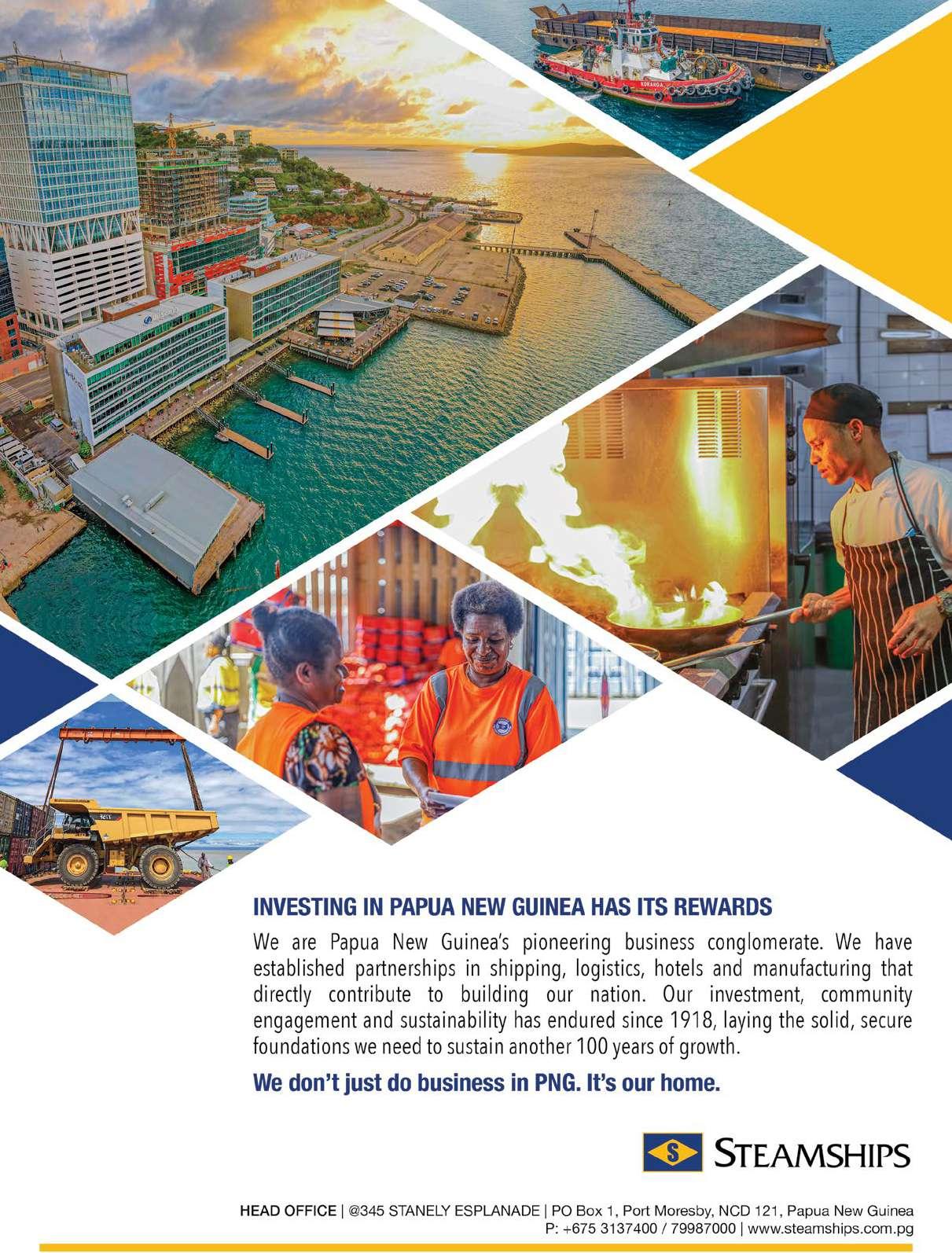
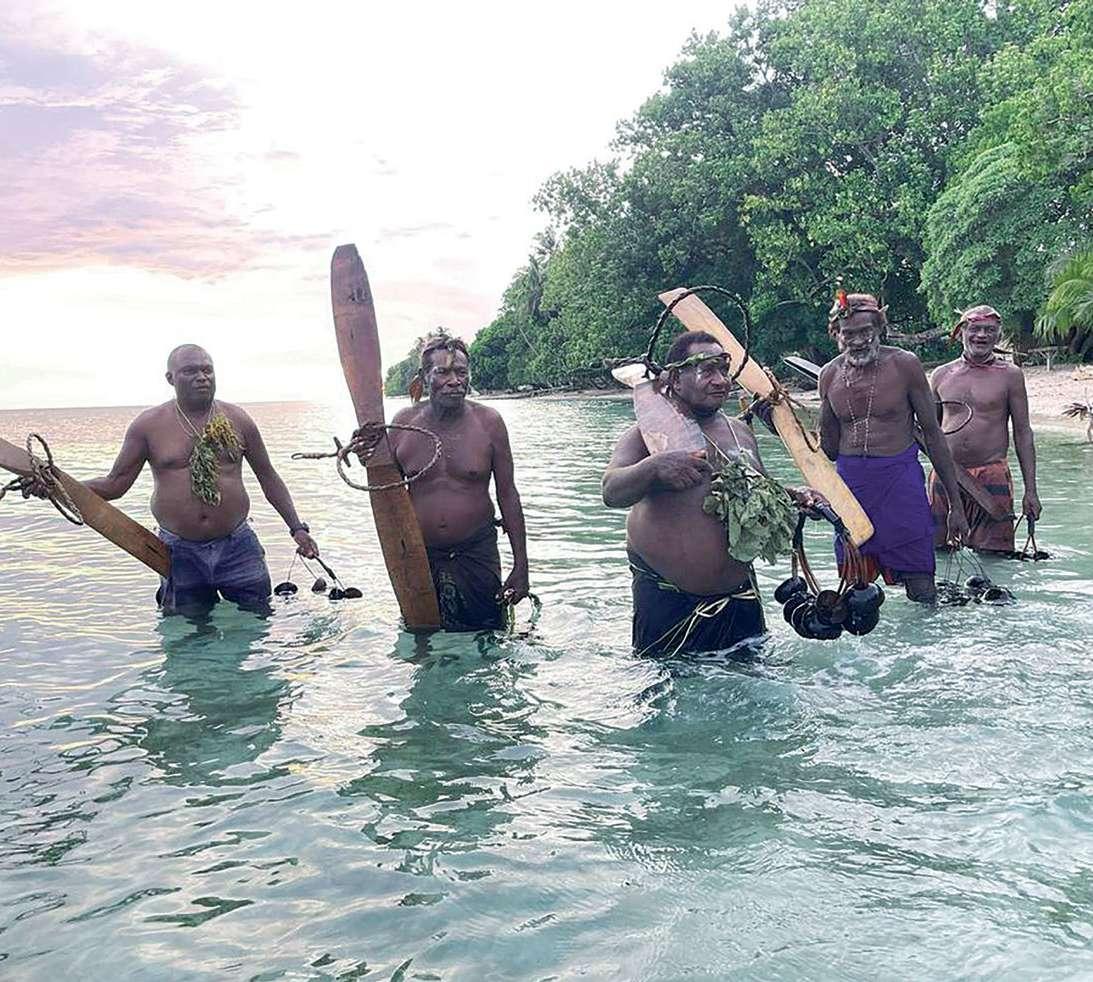
CALL OF THE WILD
Shark hunters at the Wokisok Festival of the Sea, at Kono village, New Ireland.
The ancient tradition of shark calling survives in New Ireland, and now a festival has been revived to honour the practice. Belinda Jackson reports.
It’s early morning when a small flotilla leaves the shores of Kono village in western New Ireland, one man in each outrigger canoe. Clad in a black lap lap, each is prepared to lure and kill a shark with nothing but a rope, dried coconut shells, a wooden hammer and his voice.
It’s a ritual as well as a hunt for food, and after days and even weeks of preparation, the men know their shark is waiting for them.
The villages of Kono, Messi, Tembin and Kontu are some of the last practising the ancient tradition of shark calling, a spiritual connection that links sharks with the people of New Ireland.
“With an oral culture, it’s difficult to date how long shark calling has been practiced here,” says Godfrey Abage, organiser of a new shark-calling festival in Kono village. “It goes back to when our ancestors were hunters and gatherers, moving from place to place, and it’s still practiced today for feasts or community gatherings.”
This year (2025), for the first time, Kono’s shark-calling event in New Ireland is officially on Papua New Guinea’s busy festival calendar. Before then, it was held if there were funds available.


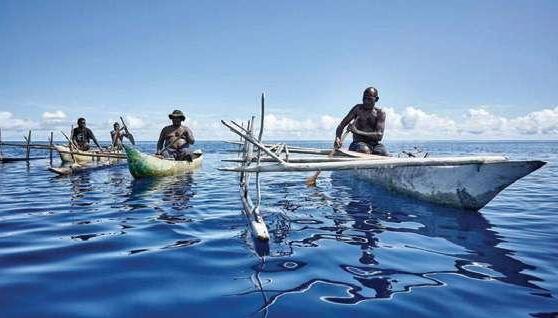
Following a successful trial festival in 2024, this is the first official shark-calling festival to be registered with the National Cultural Commission.
Once widespread across New Ireland, shark calling is now practised only on the west coast of New Ireland, after reports it has died out in Lakeba Island in Fiji’s Southern Lau archipelago.
“The shark callers have to comply with certain laws and rules – they fast and they pray, following rituals to cleanse themselves,” Abage explains.
It’s important to comply with the laws of shark calling. If you don’t, it’s going to be dangerous out in the sea, you can easily get attacked by the shark.
Last August, hundreds of people gathered in Kono for the three-day celebrations, dancing and watching as the decorated shark callers set out in their canoes into the clear, blue Bismarck Sea. Of the 33 shark callers who prepared and sailed out to the hunt, three Kono villagers, Philip Tamon, Francis Boski and Boxas Parill, brought back sharks, to be sacrificed for a feast.
It’s not just a hunt for a protein source, says Abage, there’s a spiritual element, too. When they are calling the sharks, the hunters call the names of their ancestors, whose spirits they believe are connected to the sharks.
The question on everyone’s lips is, of course, “is shark calling dangerous?”
They also avoid certain foods and any interaction with women in the days leading up to the shark calling. In that time, they’ll also carve a floater and a gigi, a rattle of dried coconut shells whose sound piques the shark’s interest, and weave the lasso that will ensnare their prey.
“It’s important to comply with the laws of shark calling,” he stresses. “If you don’t, it’s going to be dangerous out in the sea, you can easily get attacked by the shark.”
Paddling silently, the men rattle the gigi, calling the sharks to them. If they’ve prepared properly, the sharks will approach, to be snared in the caller’s noose, killed and dragged onto the canoe. With the call of a conch shell, they let the waiting villagers on shore know of their success. Singing as they paddle, the men bring the sacrificed shark back to feed the village at a communal meal.
Shark callers head out to sea at the Wokisok Festival of the Sea (far left); celebrating an ancient tradition at Kono village (left).
PICTURE: KRISTINA STEINER

Shark calling also gives an opportunity to share a key environmental message, to protect New Ireland’s nature, both on land and in the sea.
“We want tourists to come and see this culture, learn about it and appreciate it, and find the connection to nature. We want to lead them into connecting with nature,” says Abage.
The 2025 festival dates were changed to accommodate elections, but in 2026, the festival will revert to its set place on the calendar in July, creating a natural festival




trail from New Ireland on to the spectacular National Mask & Warwagira Festival, held annually in Kokopo, East New Britian.
You’re not just here to see people doing shark calling, Abage adds, but to appreciate the stories and New Ireland’s environment, which is critically important to the caller’s success. “If they are not connected to nature, they will not catch a shark.”
The festival also aims to revive the culture in villages that somehow have lost the practice. “A couple of other villages have confirmed they’ve had shark calling in the
past,” says Abage. “And now, a lot of our young people are learning these skills, and with it an appreciation of caring for the environment. There are a lot of good things about shark calling.
“As shark calling shows us, if you look after your environment, it will look after you.”
The 2026 Shark Calling Festival of New Ireland will take place in Kono Village on July 16–18, see newirelandtourism.org.

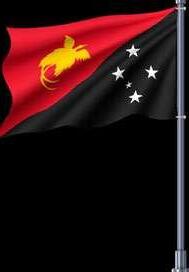
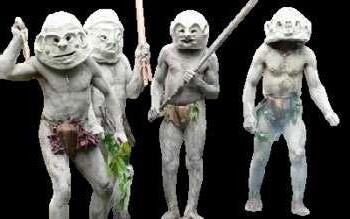
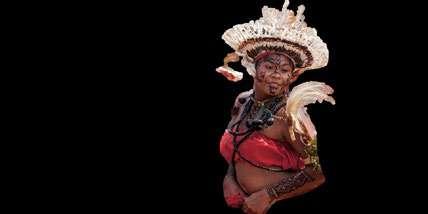



Shark callers head out to sea (far left); shark callers celebrate at Kono village (left).

HOW A WARTIME MARTYR BECAME PNG’S FIRST SAINT SAINTS & SINNERS
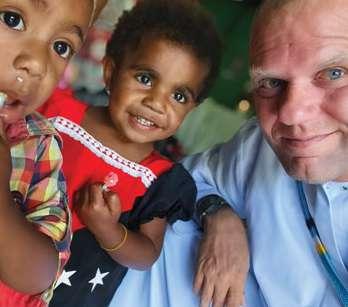
Richard Andrews looks into the remarkable story of Peter To Rot, a Papua New Guinean recently canonised by Pope Leo XIV.
Peter To Rot has been canonised* by Pope Leo XIV as Papua New Guinea’s first saint – the final chapter in a story of lust, betrayal, murder, courage and devotion, which could have come from the pages of the Bible itself.
The World War 2 martyr from the village of Rakunai in East New Britain Province faced persecution for his beliefs during the Japanese occupation, and ultimately his death in 1945 at the age of 33.
Accounts describe how from 1942 to 1945, the Japanese occupiers interned all expatriate missionaries on his island, destroyed churches, restricted religious services and even forced a return to polygamy “in an attempt to suppress Christian beliefs and practices in the region”.
The son of a Tolai village chief, To Rot received a religious education as a devoted Roman Catholic and worked in Rakunai as a catechist, or lay teacher. He was married with three children.
To Rot was asked to take over the religious duties of the local priest, when he was imprisoned. At great risk, the young man built a hidden bush church, after the Japanese destroyed the village church. To Rot worked “secretly and with extreme caution so as not to endanger the lives of the faithful, knowing full well that this decision could cost him his life,” says a Vatican report.
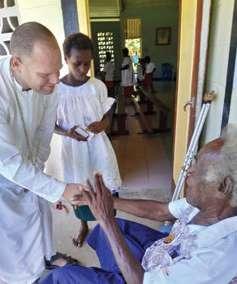
During the occupation, To Rot opposed the reintroduction of polygamy and stopped his brother from forcefully taking a woman as his second wife. Denounced by the angry brother, To Rot was sentenced to prison, where he was reportedly poisoned.
Pope John Paul II was made aware of the story and in 1993 confirmed that To Rot had been killed in odium fidei (in hatred of the faith). The Devil’s Advocate examination process was then completed in Rome. The path to sainthood was established in 1995 when To Rot was beatified during a papal visit to PNG.
Last March, 30 years later, Pope Francis formally decreed the canonisation of St Peter To Rot. The promulgation followed campaigning by Father Tomas Ravaioli, an Argentinian priest based in Goroka.
Appointed Vice Postulator for the cause in 2020, Ravaioli spent five years “collecting information, preparing documents and gathering testimonies from people across the country to be sent to Rome” in support of To Rot’s canonisation. The “arduous work” paid off, says Ravaioli.
“Pope Francis’ personal connection to PNG played a significant role. He was already familiar with the story of Peter To Rot, as we had sent him a book and a relic of the blessed a few years prior.
I heard many stories from people who’d been healed when Peter To Rot visited them in their dreams.
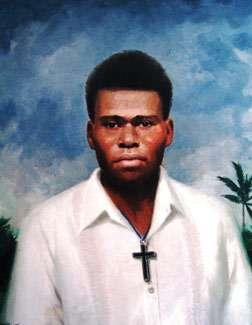

One of them was To Rot’s older brother, Metepa, a married Christian attracted to a woman in the village. He assaulted her husband and kidnapped her. To Rot and her father found the woman and returned her to her husband. To Rot was reported to the Japanese and imprisoned.
“You could say Metepa was worse than Judas in some ways, as he turned in his own brother,” says Ravaioli.
“He replied: ‘I cannot do it, because it is God’s work, not mine,’” says Ravaioli. “He was visited that evening by a Japanese doctor and injected with a deadly poison.”
“Pope Francis told me: ‘I want to canonise Peter To Rot myself, but you must do your homework well’,” says Ravaioli. “Regrettably he could not carry out the canonisation in person, as he passed away in April.”
Ravaioli is often asked why the Japanese wanted to reintroduce polygamy on the island.
“Near the end of the war, Japan had lost many planes and ships,” he says. “The occupiers feared they’d be left behind and were afraid of the people they’d treated cruelly for years. ‘How can we gain their friendship?’ they asked.
“Let us give them women, was the answer,” says Ravaioli grimly. “‘Forget about the missionaries and the Gospel. You are free to take as many wives as you want.’ This was aimed at the chiefs who still favoured polygamy, and at other men, of course.”
To Rot was locked in a “small and windowless” cell. His wife Paula visited him just before his death and said the Japanese would release him if he abandoned his work as a catechist.
To Rot was given a silent funeral in the Rakanai Catholic cemetery, but his story spread widely. The government issued a series of postage stamps in 2012 to honour the centennial of his birth. The same year, the Japanese Church apologised to the PNG nation, saying “Peter To Rot’s death is our fault”.
“We have no excuses; he was and is a model for all,” wrote the President of the Episcopal Conference Nippon.
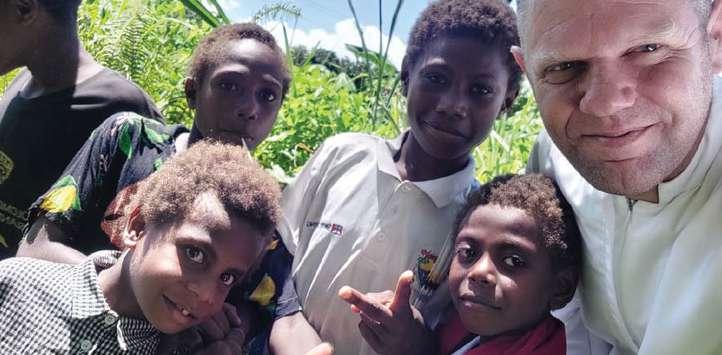
Peter To Rot (above); relatives at the grave site of Peter To Rot at Rakunai village (above right); Father Tomas Ravaioli with parishioners and children where he lives in Goroka (all other photos).

In 2024, the bishops of PNG and the Solomon Islands requested that the requirement for a documented “miracle” be waived, on the path to To Rot’s canonisation. They noted there were few hospitals capable of providing the scientific documentation necessary to prove a supposed miraculous healing. They also argued that the local culture is largely based
on oral communication, making it difficult to document any miracles in writing.
“Pope Francis said he understood the situation and granted the waiver,” says Ravaioli. “But travelling around PNG, I heard many stories of healings attributed to Peter to Rot.
“I met a local priest in Rabaul who’d been diagnosed with advanced cancer and sent to
a hospital in Australia. His doctors predicted he would die the next day. However, a friend slipped a Peter To Rot prayer card under the mattress and the priest woke up in the morning completely healed.
“I also heard many stories from people who’d been healed when Peter To Rot visited them in their dreams.”
PNG has an estimated 2.5 million Roman Catholics and St Peter To Rot joins a pantheon of more than 10,000 saints recognised around the world by the Church. From July 7 2026, the date of his death, will be a Feast Day celebrated in his name.
“After so many years of Christianity we finally have our own saint, who speaks our own language,” says Ravaioli.
“That for us is priceless.”
*The canonisation was scheduled for October 19, after Paradise went to press.

Pope Francis with Argentinian missionaries (including Father Tomas Ravaioli second from right) during a visit to Vanimo.

“You r part n er in de li ver in g So c i a l , E n v i r on me n ta l a n d Co rp o rate G o ver n a n ce in t h e Minin g I n d us try ”

The M ine r al Res ou r c es A u th or it y ( M R A ) is a g o v e r n m ent instit u ti o n
esta b lished t o r e gu late , g r ow and s u staina b l y m ana g e the m inin g
( m ine r als) ind u st r y t o m axi m i z e m ine r al ex po r t r ev en u e for P a pu a
Ne w Gu inea . It is the cu s t o dian of o v e r 1 5,000 v o l um es of ex p l o r ati o n
r e po r ts and o v e r 900,0 0 0 data po ints of m ine r al data . It is the fi r s t po int of co nta c t for an y bu sinesses in the m inin g se c t o r
Call U s (675) 207 2250
S end U s M ai l info@mra.gov.pg O ur Loc ati o n Mining Haus, Poreporena Freeway PO Box 1906 Port Moresby 121 NCD Papua New Guinea

THE KEYBOARD
HELPING PNG SCHOOL CHILDREN WARRIOR
Leonie Jarrett reports on a program started by an Australian university student that is delivering free computers to schools across the country.
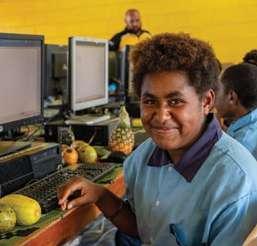
Each school day in Papua New Guinea, over two million students walk to school across the valleys, along the rivers and through the towns.
When the students arrive, only eight per cent have access to school computers. For most of this eight per cent, the opportunity of digital access is the realisation of a dream. A dream that began in 2017 when Jack Growden, then a 20-year-old Australian university student, visited the Kuta Primary School in Western Highlands Province.
Growden noticed that the school was lacking the tools to deliver a quality education that prepares students for the digital world.
Determined to address this issue, he donated his laptop to the school. He also promised to return with 12 more computers to build a computer lab. To fulfil this pledge, he founded LiteHaus International.
Fast forward to today and 350 schools across 18 provinces in PNG now have access to digital learning tools and opportunities because of Growden’s efforts.
Refurbishing and repurposing more than 6000 computers from businesses and schools
A computer lab at St Anslem Primary School, which has received donated computers from LiteHaus International (top); a student at the school (above).
Having these computers has changed everything for our school, inspiring students and teachers to strive for greatness.

across Australia, LiteHaus International has made more than 1.4 million hours of digital usage possible for 235,000 students in PNG.
Crucially, LiteHaus International’s programs are PNG-led and supported. The group’s Country Director, Peter Raim, was there on day one, standing beside Growden when he made his promise. Raim has led the efforts ever since with his local team of IT technicians.
LiteHaus partners with local firms Niunet and the Sir Brian Bell Foundation. Niunet offers an offline e-library with over 6.2 million educational articles at the fingertips of students in need. The Sir Brian Bell Foundation has backed the installation of computer labs since 2020, enabling the program to scale to every corner of PNG. Libraries across many Highlands schools once held less than 100 books, many outdated, on their shelves. Growden recalls visiting schools in Jiwaka Province where, “the latest encyclopaedias available to the students cited Jimmy Carter as the US President and still featured the USSR on their maps.” As he says: “Expecting students


to learn effectively in this environment is like asking a marathon runner to train in a telephone box.”
For schools across PNG, the computer labs have lifted the standard of learning offered to their tenacious students.
Aviamp Primary School in Jiwaka Province has proven what is possible when given the opportunity to deliver digital learning. IT teacher Sly Vii Yoan has delivered IT classes to students and teachers multiple times a day ever since her school received a computer lab in 2022 from LiteHaus International. She says: “Having these computers has changed everything for our school, inspiring students and teachers to strive for greatness.”
Growden realised that many teachers had never used a computer themselves. In 2023, LiteHaus launched a digital skills training program. This is a hands-on, five-day course that builds teachers’ confidence and competence in using technology in the classroom. A teacher in Chimbu Province says of her experience: “Before, I knew little about Microsoft Excel but now I’m mastering it. These skills have changed the way I teach.”
Teacher training now runs regularly alongside the installation of labs, ensuring that technology becomes an integral, rather than an intimidating, part of education.
As PNG celebrates its 50th anniversary of independence, questions about its future are inevitably raised. Growden says: “In a world where much of the human experience is taking place over digital dimensions, digital inequality not only denies the future leaders of PNG access to opportunities, but rather citizenship in the digital world. Students making that long walk to school today will still be walking and talking in the 2070s and 2080s. They must gain the skills to lead in the world that awaits them and that begins in a digital classroom.”
LiteHaus is constantly looking for donations of decommissioned second-hand computers from companies, schools and families. For information on how to donate see litehausinternational.org.
Jack Growden in Gulf Province (far left); first moments in the digital world for some Gulf Province students (above); LiteHaus Country Director Peter Raim (left).
RIDING HIGH
A surfer with Papua New Guinean heritage is making waves on the longboard competition circuit. Kirsten McGavin reports.

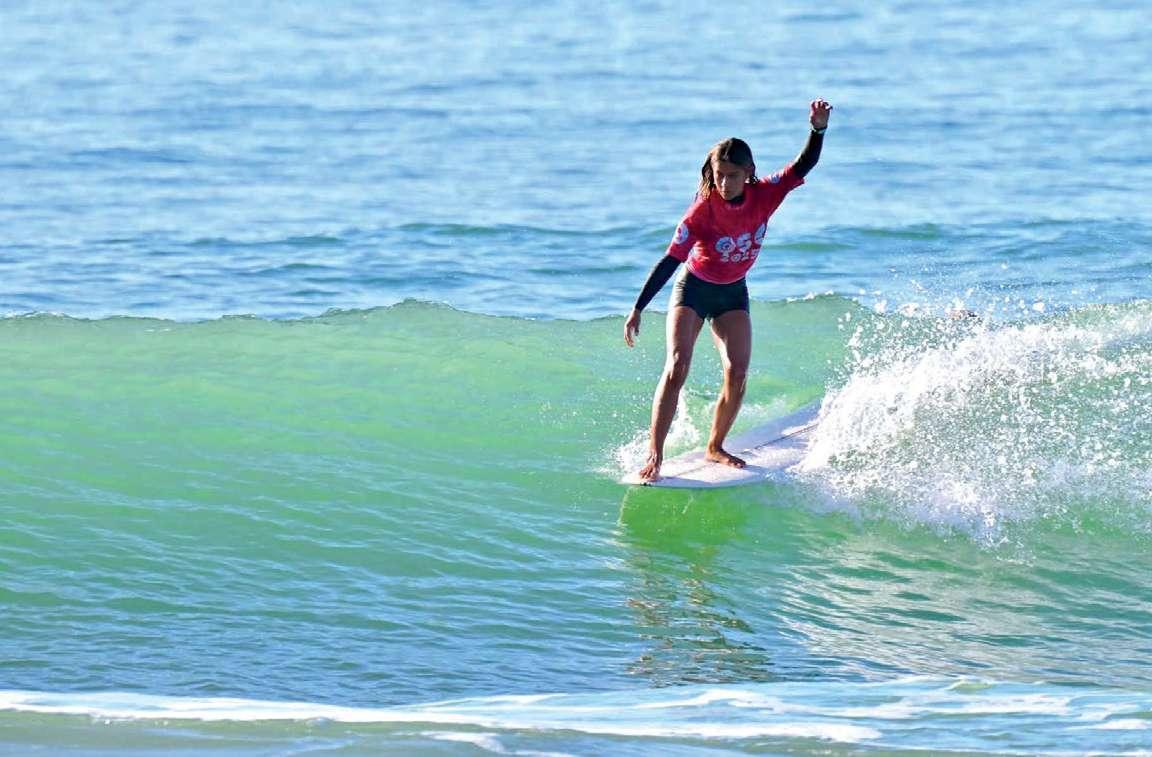
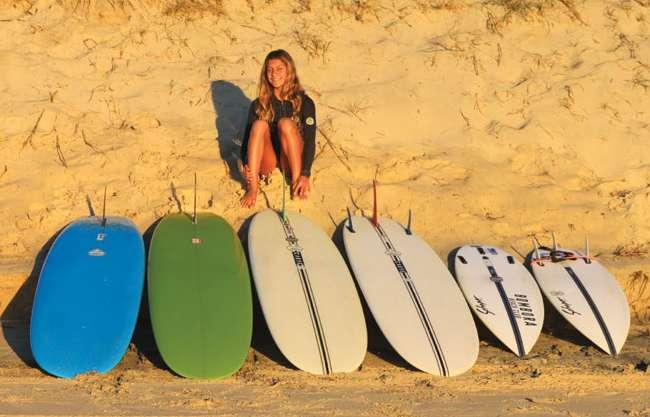

Luana Matthies noseriding at the Queensland State Titles at Coolum Beach.
PICTURE: SIMON GREEN
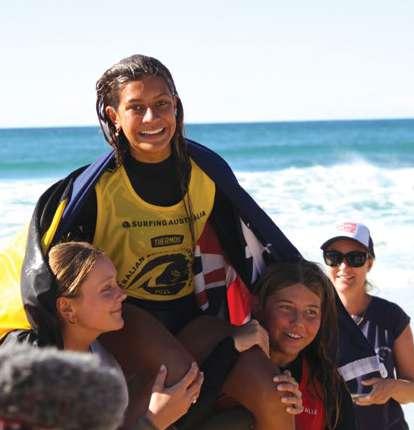
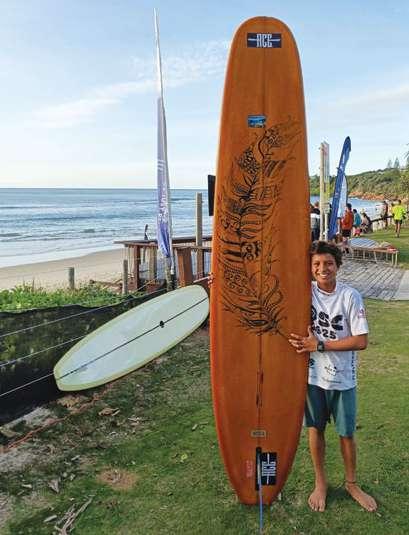
There’s a magical moment in longboarding when the surfer walks to the tip of their board, balancing there as their toes grip its front edge. Waves curl along the rear of the board in a futile attempt to catch the rider, who seems to levitate. It’s as though the surfer is a benevolent masalai or nature spirit, rising out of the water, simultaneously commanding the waves while being propelled forward by them. Noseriding, it’s called. It may not be a pretty name but there is something mesmerising and almost mythical about the act of it – the surfer at one with the ocean.
For Luana Matthies, her first taste of this magic came when she was just three years old. Back then, her father, Eddie – who’s originally from Konos, in New Ireland Province, and Tuvalu – would guide the toddler’s surfboard over small, gentle waves in Currumbin Alley, on Queensland’s Gold Coast. But the adorable image of a surfing waterbaby seems a far cry from the accolades Luana has since won – titles that solidify her place as a serious up-and-coming surfer, despite still being only a teenager.
In the last year alone, she has been ranked first in the junior girls and open women’s Queensland State Titles; first in the under 18 girls’ category of the Australian Longboard Titles; fifth in the open division of the Australian Longboard Titles; and equal seventh (a semi-final finish) at the open women’s World Surf League Longboard Qualifying Series (LQS). She also had wins at the Kirra Longboard Classic and the Noosa Festival of Surfing.
At the LQS, she says: “Everyone was so nice and amazing surfers. There were so many girls who had travelled there from across the world to compete, and that made me realise that it was possible (to travel internationally with my surfing). Now, my dream is to travel around the world, competing in different comps both on and off the world tour.
Why the previous doubt? Firstly it takes a lot of dedication to cultivate such skill. Most mornings, Luana – and her family – head to the beach, pre-dawn, to catch some waves. This, along with travelling to compete at surf meets, means a tighter schedule to fit in all
the other important things, like sleep and schoolwork. And the costs of competing add up, especially as younger brother, Hosea, is also a champion surfer. “Travelling a lot and entering comps for the both of us, especially bringing the whole family, definitely costs our family a lot,” Luana says. “We’re currently working with sponsors to figure out ways to make it work.”
Still, having a surfer sibling adds to the fun. “I’m so proud watching Hosea achieve big results, too, and he’s definitely one of the main people who have helped me get to where I am. We’re constantly pushing each other to get better.” Family in PNG have also been very encouraging. “Everyone we know in PNG is super supportive and always wanting to know how we went in comps. I would love to travel around (PNG) and surf there with family,” Luana says. “It would be so amazing.”
I get a rush of adrenaline when I’m on a good wave but surfing also calms me.
And, with renowned surf spots everywhere from Vanimo to Milne Bay, Kavieng and Bougainville, she’ll have a lot of places to choose from, whether it be for longboarding or shortboarding.
Despite her rapid success in longboarding, Luana says she doesn’t really have a preference. “I surf different boards depending on the conditions.” She goes on to explain that the fast pace of shortboarding makes that style of surfing more exciting and adrenaline-filled, while longboarding is calming and allows you to paddle on to waves early and ride them for longer.
It seems like the real magic here is the act of surfing itself. “Paddling out to watch the sunrise is so different from anything else,” Luana says. And with dolphins, turtles, stingrays and whales sometimes coming along for the ride, each wave is different.
Luana Matthies being chaired off after winning the under 18 Australian Longboard Title at Cabarita Beach in NSW (top); Hosea Matthies (above); Luana Matthies being interviewed after a victory at Coolum Beach (left); with her quiver of surfboards (far left).
FAYA HAUS, PORT MORESBY REVIEW
When I visited Faya Haus almost a year ago to write a story for Paradise, they were just fresh off the celebration of their rebranding (the restaurant was previously called Kopi Haus) and I made a note to return to try their menu. I’ve since been back a few times, mainly for their great coffee, but this time I’m back to have some lunch.
It’s midday on a Saturday and both the inside of the restaurant and deck steadily fill up with the lunch crowd. I note that most of my neighbours opt for the buffet (themed buffets are available at lunch and dinner daily) but I’m eager to try the a la carte menu. I’m seated at a table outside, which gives me a view of the gardens and pool area.
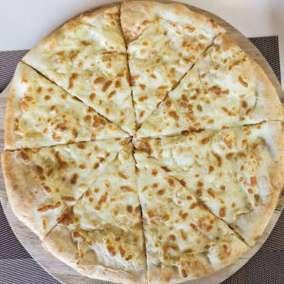
I choose the burrito bowl, which is big enough to share for two. There’s a lot of colour in the bowl. It’s filled to the brim with tomatoes, sweet corn, slices of avocado, quinoa and capsicum –all topped with lightly grilled chicken breast slices. All this goodness sits on a bed of crisp lettuce. There is minimal dressing, which allows the fresh ingredients to shine. As good as it is, I save space for the highly recommended garlic pizza. It may sound simple, but this pizza is genuinely the best I’ve had in a long time, and I daresay it will be difficult to share. The topping has just the right amount of garlic (no chunks are detected) mixed in with thickly melted mozzarella. The crust is thin with slight char from the woodfire oven.

WHERE:
Holiday Inn & Suites, Wards Road, Waigani
PHONE: +675 303 2000
ONLINE: fayahaus.com
OPEN:
6am to 10pm daily
STYLE:
All-day dining and buffet
PRICES:
Starters PGK18–47; salads and burgers PGK48–55; woodfired pizzas PGK46–60; charcoal grilled dishes PGK98–450; classic dishes (like fish and chips and spaghetti bolognaise) PGK52–75, desserts PGK27–58.
OUR FAVOURITE DISH: Garlic pizza IN A PHRASE: Something for everyone

Faya Haus is suitable for everyone – from solo diners to couples on a lunch date and groups on long tables. It’s always abuzz with friendly chatter and great music, and the prices are reasonable.
The simple but brilliant garlic pizza (top); a generously proportioned burrito bowl (far left); the interior of the rebranded Faya Haus at the Holiday Inn and Suites in Waigani (left).

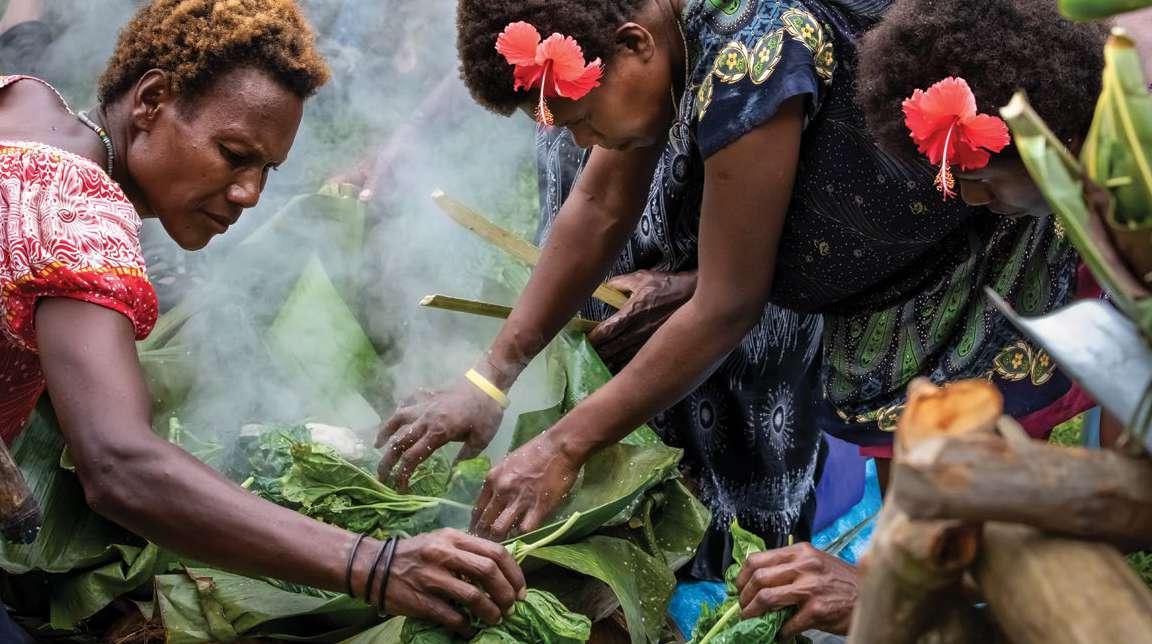
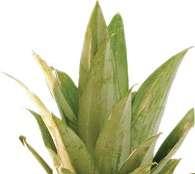
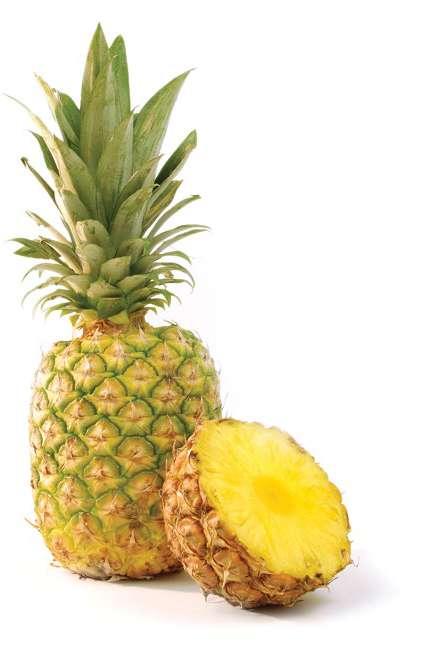
OF THE NATION TASTE
David Soroda reflects on PNG’s rich food heritage, from smoky and tender meat and root vegetables prepared in a mumu in the Highlands to fresh fish in coconut cream on the coast.
As Papua New Guinea marked its 50th year of independence in September, the nation not only reflected on its political journey but also celebrated the vibrant tapestry of its cultural identity, none more deliciously than through its food. From the misty Highlands to the sun-drenched coastlines, PNG’s culinary landscape is a living archive of its people, traditions and the land itself.
This golden jubilee has been more than a milestone; it has been a feast. And for travellers flying into the heart of the Pacific,
PICTURES: ISTOCK

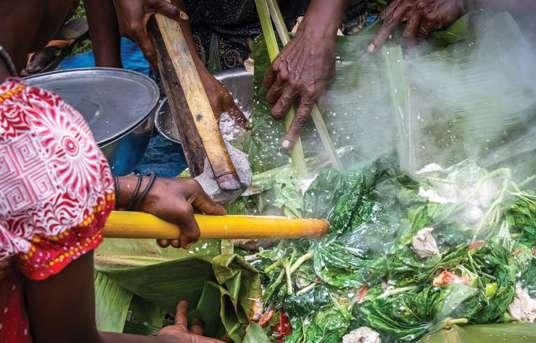
Women of East New Britain preparing a traditional dish cooked with hot stones and wrapped in leaves (far left); a coastal wet mumu of aibika, chicken and coconut cream wrapped in banana leaves, ready to steam over hot stones (left); pineapple is popular in coastal dishes (below left); a PNG flag board adorned with fruit, vegetables, coconut and spices typically used in the country’s cuisine (below).
While tradition is the foundation, PNG’s culinary scene is also evolving. A new generation of chefs is reimagining local ingredients with global techniques.
there’s no better time to explore the rich, diverse and deeply rooted food culture that defines the nation.
PNG is home to over 800 languages and just as many unique culinary traditions. Each region, tribe and village has its own way of preparing food, often using ingredients sourced directly from the surrounding environment. This diversity is what makes PNG’s cuisine so compelling: it’s not just food; it’s storytelling on a plate.
In the Highlands, where the air is cool and the soil fertile, root vegetables like kaukau (sweet potato), taro, and yam are staples. These are often cooked in a traditional earth oven known as a mumu – a communal cooking method that involves hot stones, banana leaves and hours of slow steaming. The result is a smoky, tender and deeply flavourful meal that brings families and communities together.
On the coast and islands, seafood reigns supreme. Freshly caught fish, coconut cream, and tropical fruits like pawpaw, banana and pineapple are transformed into dishes that are both refreshing and hearty. Coconut milk-
based stews, grilled fish wrapped in banana leaves and tangy lime-marinated cevichestyle dishes showcase the coastal flair.
During the jubilee celebrations, communities across the country hosted large-scale mumu feasts, inviting locals and visitors to share in the experience.

In Port Moresby, there was a mumu festival in May, where chefs and elders from all 22 provinces prepared regional variations of the dish. They prepared everything from pork belly slow cooked with wild greens to chicken infused with ginger and lemongrass, all wrapped in the earthy aroma of banana leaves.
While tradition is the foundation, PNG’s culinary scene is also evolving. A new generation of chefs is reimagining local
ingredients with global techniques, creating a fusion that’s both respectful and innovative.
At Tura Restaurant in Port Moresby, executive chef Lohia Vagi is leading the charge. His signature dish, smoked barramundi with taro gnocchi and coconut foam, is a tribute to his Motuan heritage and his training in European kitchens. “We’re not just preserving our food culture,” he says. “We’re elevating it.”
Other hotspots like Ela Beach Hotel’s Brasserie, The Stanley Hotel’s Silver Leaf, The Hilton’s Mumu and Rapala at the Crown Hotel are also showcasing PNG’s bounty with flair. Expect menus that feature wild river prawns, sago-crusted tuna, and desserts made with local cacao and vanilla.
To truly understand PNG’s culinary heartbeat, one must visit its markets. The Gordons Market in Port Moresby, recently revitalised, is a sensory overload of colour, aroma and chatter. Here, women from the Highlands sell bundles of kaukau and pipit (a native sugarcane), while coastal vendors offer smoked fish and bundles of betel nut.
In Lae, the Main Market is famous for its fresh pineapples and the fiery local chilli known as daka. In Rabaul, you’ll find seafood so fresh it’s still wriggling, alongside exotic fruits like rambutan and mangosteen. These markets are more than shopping destinations, they’re cultural crossroads where food, language and tradition intersect.
One ingredient that unites many of PNG’s diverse regions is sago, a starch extracted from the sago palm. In the Sepik region, sago is life. It’s pounded, washed and cooked into pancakes or dumplings, often served with smoked fish or wild greens.
During the 50th anniversary year, the Sepik Sago Festival will return to Yanget village in the East Sepik on December 15 and 16 with even more fanfare.
Visitors can watch traditional sago processing demonstrations, taste dozens of sago-based dishes and witness the crocodile dances that honour the region’s

spiritual connection to the river and its creatures.
No celebration is complete without a drink, and PNG has its own unique offerings. Locally brewed beers like South Pacific Lager and Niugini Ice are popular, but the real stars are the traditional beverages.
Kava, though more common in neighbouring Pacific nations, is enjoyed in some PNG communities. More widely consumed is kulau, young coconut water, often served straight from the shell. For something
stronger, try PNG coffee, grown in the Highlands and considered among the best in the world. The Goroka Coffee Festival, held in September, offers tastings, barista competitions and cultural performances.
The PNG Tourism Promotion Authority, meanwhile, has launched a year-long campaign titled ‘Taste PNG: A Culinary Journey Through Time’. This initiative includes food trails, cooking classes and village homestays where travellers can learn to prepare traditional dishes.
Air Niugini has also joined the celebration by introducing a special in-flight menu featuring regional delicacies.
As PNG looks ahead, its culinary future is bright. Sustainability, food security and cultural preservation are at the forefront of national conversations. Young chefs are returning from overseas with new skills, farmers are embracing organic practices, and communities are finding pride in their food heritage.

A Madang feast: local greens, roots, and fruit on woven mat with clay pots.
PICTURE: DAVID SORODA
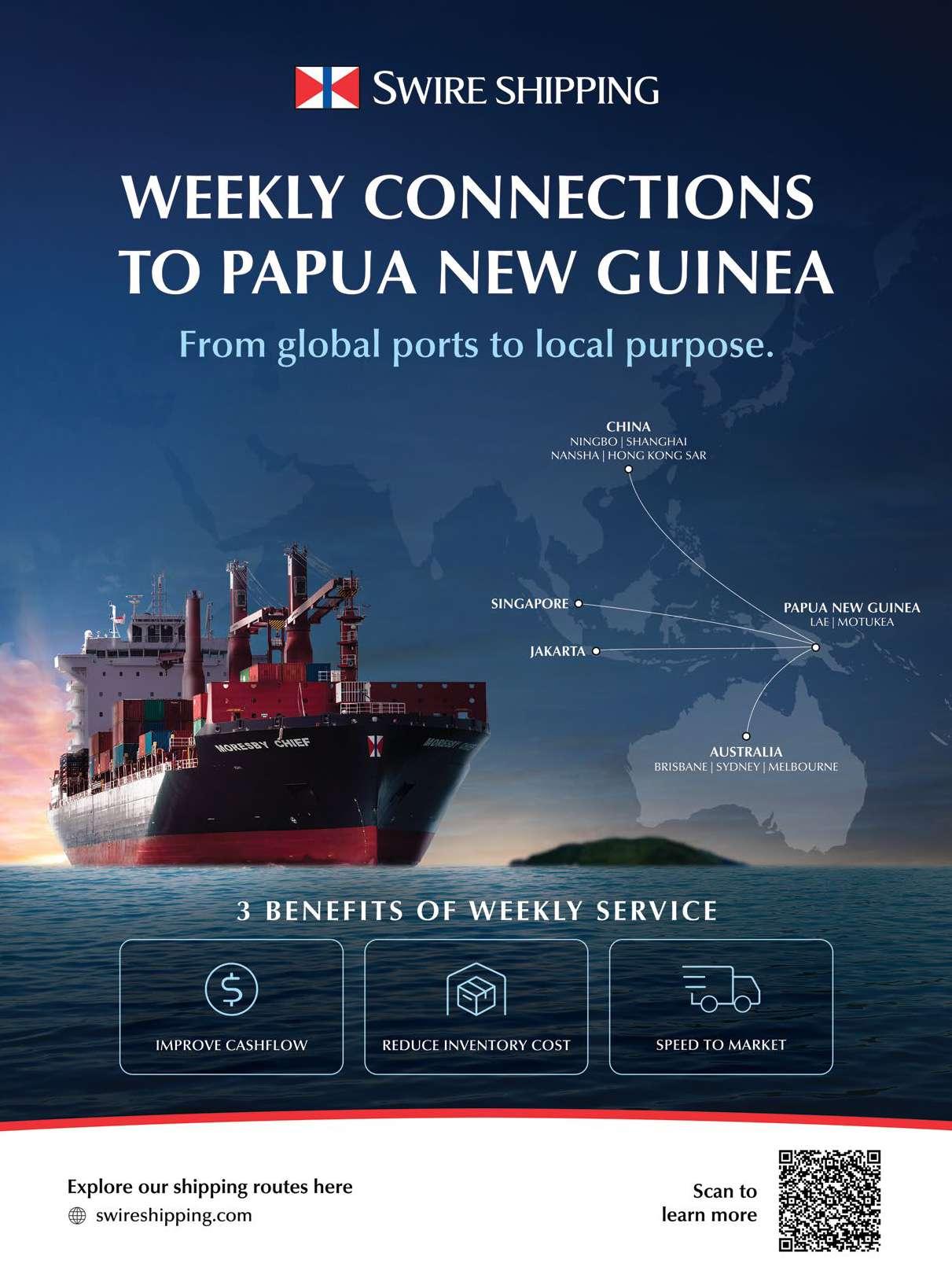
BY PAUL CHAI
Wine Guru
Q: Should you add mixers to wine?
A: Recently a controversial cocktail has been having a moment: the kalimotxo. Depending on how much of a wine snob you are, it is either an abomination or a revelation because it is, quite simply, red wine and Coca-Cola. This drink is not new, it was developed over a century ago in Spain and is part of a long tradition of adding a little something to wine: sometimes because that wine is a bit sub-standard but often just because it tastes good or makes the wine a little less boozy for a summer session.
A white wine spritzer in its most basic form is wine and soda water, but can be dressed up with anything from a shot of Aperol to a twist of lemon. The drink’s origin goes all the way back to the invention of bubbly water in the late 19th century.
served heated throughout the European cold months and has an equally long and proud history.
In fact, mixing spice and sugar with your wine can be traced as far back as the early Greeks and Romans, who added whatever they had at hand to their vino, which they drank in place of water due to the high levels of bacteria present in water at the time. This simple practice gave birth to the wine cocktails that we have today.
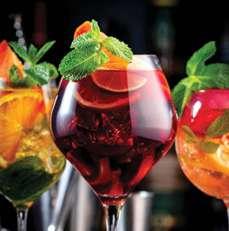
One of the most famous mixed-wine concoctions is Spanish sangria, where red wine (and sometimes white or rose) is combined with fruit juices to create a kind of wine punch. Its winter equivalent, mulled wine, adds a little extra spice and is
Sure, it is sacrilege to add something to an expensive, well-stored bottle of vintage Grange but for a simple table wine there is really nothing wrong with experimenting.
Next time you want a light and refreshing alternative to spirit-based cocktails, add fruit juice, spice or whatever you like to your glass of wine, and you will be keeping up a tradition that has been around for as long as we have been growing grapes.
Do you have a wine question? Email us at paradise@ businessadvantageinternational.com.


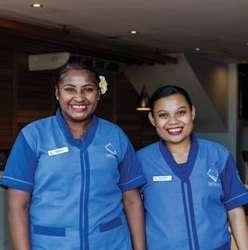


Salt Restaurant at Ela Beach Hotel named PNG’s Best Hotel Restaurant 2024.
The prestigious award was presented to Salt Restaurant by the World Culinary Awards. Achieving this level of recognition is a remarkable honour and reflection of the team’s passion for quality food and warm hospitality. Since opening its doors in February 2021, the team at Salt have continuously strived for excellence providing customers and patrons the best hospitality experience Melanesia has to offer.



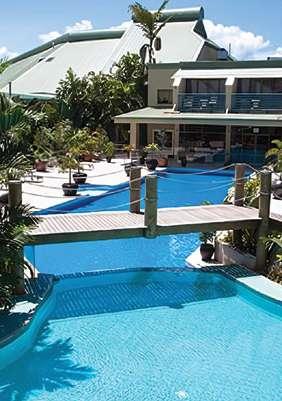


Steamships Hospitality's commitment to excellence in Safety, Security and Hygiene awarded with SafeHotels Certifications
Grand Papua Hotel and Gateway Hotel were awarded their prestigious titles in December 2024. Safehotels is about passion for hotels and the highest standards of safety, security and hygiene for all guests and patrons. Standards are independently set through a world-leading Certification program, including on-site assessments by experts with years of knowledge and understanding of hotels across the globe.
These first-ever certifications in Australasia and the Pacific Islands highlight our leadership in hospitality excellence. Affirming our dedication to providing a secure and welcoming environment for our
setting new industry benchmarks.
BY BRONWEN GORA
WELLNESS
Most people would probably list healthy diets and exercise as the main predictors of healthy ageing.
What is becoming increasingly apparent, however, is the role played by other people and our relationships with them.
“Our relationships and how happy we are in our relationships has a powerful influence on our health,” says Robert Waldinger, director of a study into health in adult life and a psychiatrist at Massachusetts General Hospital in the US.
“Taking care of your body is important, but tending to your relationships is a form of selfcare too. That, I think, is the revelation.”
Dr Waldinger’s research is part of the world’s longest study into adult life run by Harvard University over nearly 80 years, which found close relationships –more than money or fame – are what keep people happy.
of physical health than their cholesterol levels. “The people most satisfied in their relationships at age 50 were the healthiest at age 80,” Dr Waldinger says.
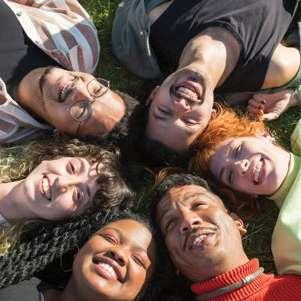
The cornucopia of data also revealed that people’s level of satisfaction with their relationships at age 50 is a better predictor
“Loneliness kills. It’s as powerful as smoking or alcoholism.”
Of course, other factors play major roles in longevity as well. These include physical activity, an absence of alcohol misuse and smoking, possessing the ability to cope well with life’s ups and downs, maintaining a healthy weight and being married. But social connection is paramount.
The findings surprised researchers. “When the study began, nobody cared about empathy or attachment,” explains psychiatrist George Vaillant. “But the key to healthy ageing is relationships, relationships, relationships.
“Good relationships don’t just protect our bodies; they protect our brains.”


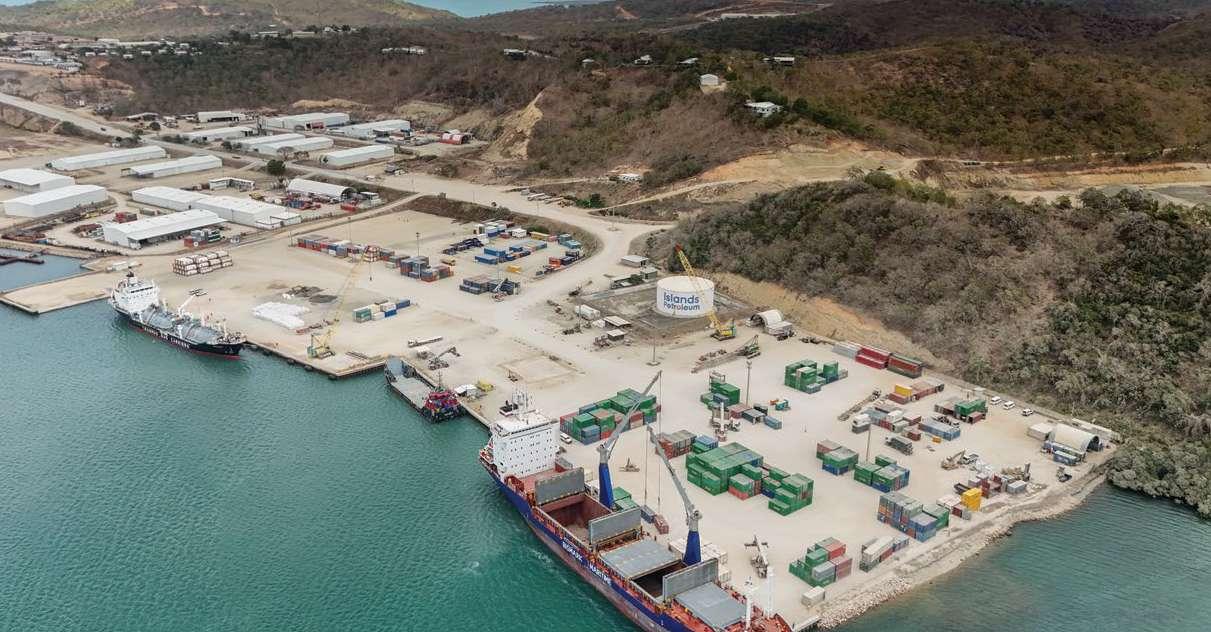


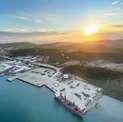

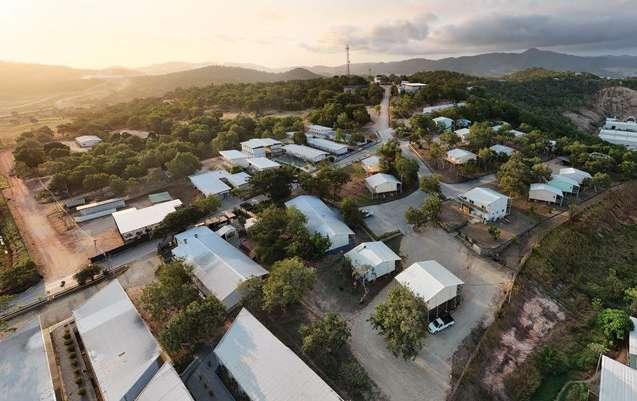
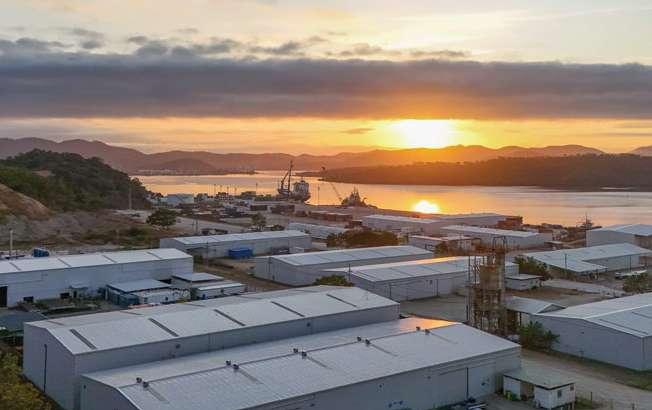
CHRISTMAS GIFTS
Travelling to an Air Niugini destination? Then check out our guide to some of the most unique and special gifts each has to offer.
PORT MORESBY
Bilum bag
One of the most traditional – as well as useful – handicrafts from Papua New Guinea is the bilum. These colourful bags are hand woven by women throughout PNG’s remote villages using the ‘bilum technique’ of rhythmically twisting and looping string, a weaving skill that has been passed down through generations. Bilums were traditionally used to transport produce from gardens to homes or markets, or as small hammocks for carrying babies. Nowadays fashionable stores as well as charitable organisations sell bilums in PNG and worldwide with much of the proceeds flowing back to the remote communities and women who made them, helping provide families and individuals with better access to education, healthcare, housing and more. For stockists in Port Moresby see bilumandbilas.com.

HONIARA, SOLOMON ISLANDS
Handcarved wooden bowl with shell inlay
Wooden bowls are common throughout Asia and the South Pacific but those made in the Solomon Islands are among the best. Artisans pour painstaking effort into intricately carved designs while most Solomon Island-made bowls like this seahorse-shaped piece will be expertly inlaid with nautilus shell. These handmade pieces hold great spiritual and traditional significance, representing beliefs, social structures, connections to ancestors or periods of history. They are easily found throughout the islands, a good place to start being Honiara Central Market.


SYDNEY / BRISBANE / CAIRNS, AUSTRALIA
Aussie Rules football
Bring an AFL football home to the sports lover in your life and you will be giving them a piece of Australian sporting lore. Aussies love their sport, but passion for Australian Rules football is next level, so much so that the game is often described as an unofficial religion. The reason why is two-fold: the excitement of the AFL competition brings communities together, providing people of all ages with a sense of identity and shared experience, while the game itself is an addictive blend of fast-paced athleticism and skill, continuous action and strategic complexity. Find AFL footballs at major sporting stores or sherrin.com.au. Around PGK685.
BY BRONWEN GORA
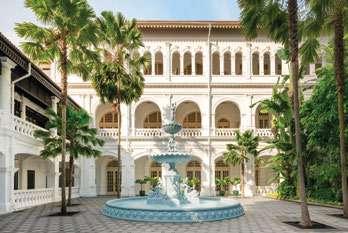
SINGAPORE
Raffles Hotel gift card
Visiting Raffles Hotel Singapore – one of the most iconic and historic hotels in SouthEast Asia – is a bucket list experience. So, what better way to delight the traveller in your life with a Raffles gift card? It can be used for a range of luxury experiences from accommodation, dining at renowned restaurants like the Tiffin Room or Long Bar, and treatments at the Raffles day spa. Opened in 1887, Raffles became one of the region’s most elegant and legendary hotels, feted by high society, celebrities like Somerset Maugham to Elizabeth Taylor and home to the world-famous Singapore Sling cocktail still served at the Long Bar. A 2019 renovation restored Raffles to its colonial glory. Find Raffles gift cards for purchase in multiple currencies to a value of your choice on the hotel’s website. giftcards.raffles.com

NADI, FIJI
Kava
There is nothing that says Fiji more than locally grown kava, the national beverage. Attending a kava drinking ceremony is high on the to-do lists of many visitors to Fiji. The communal event is the way in which Fijians traditionally welcome others, but the ritual is also as much a part of daily life as it is for important occasions like blessing new homes or even settling arguments. Made from a ground root, kava is mildly sedative and relaxing, and it is not uncommon to see Fijians gathered in the afternoons sipping it with family or friends. Kava can be found in powdered form in supermarkets, markets and specialty stores. Bear in mind though that kava has a somewhat muddy taste, so it is also now available in a range of tasty treats like kava cookies, chocolate and popsicles sold at dutyfree stores in Nadi.
HONG KONG, CHINA
XO sauce
Ignite someone’s taste buds with a gift of gourmet XO Sauce. So delicious is the flavourpacked Chinese condiment that it fast became a foodie favourite after being created in the 1980s at Hong Kong’s prestigious Peninsula Hotel. (The XO is a nod to cognac, implying high quality.) Complex and intensely tasty, there is no definitive recipe for its combination of key ingredients like dried shrimp, dried scallop, Jinhua ham, garlic, shallots, fish sauce and more. Best of all, XO Sauce is wonderfully versatile and lifts any meal, with many uses ranging from flavour base to meal enhancer –tossed through noodles, dolloped on rice and egg or mixed through anything from seafood to beef. It also works perfectly as a relish or dipping sauce. XO sauce is sold widely in small jars.



MANILA, PHILIPPINES
Peg doll set
These sweet little handcrafted wooden dolls inspired by Filipino culture often depict men and women in national costumes (Baro’t Saya for women, Barong Tagalog for men) or national heroes. But artisans will also customise them to resemble family members, or whomever you wish, making them perfect gifts. The dolls are typically made from locally sourced wooden pegs and hand-painted in detail, showcasing Filipino artistry. Peg dolls are often used as cake toppers for weddings or anniversaries or other decorations and of course make ideal children’s toys. Around PGK27–54 for a set of 12.

PORT VILA, VANUATU Slit gong
The deftly carved slit gong or – tam tam in local Bislama – is viewed by many as Vanuatu’s best-known art form outside of the island nation. This year the drum’s profile reached new heights after a music video by Hollywood star Will Smith and rapper Doechii featuring a slit gong in the background went viral with over 300 million views. Sculpted out of a single hollowed-out tree trunk, the visually striking vertical drums carved with an ancestral face and other patterns usually range from one to four metres high, making them the largest freestanding musical instruments on earth – but for visitors, there are many smaller 30 to 40 centimetres high available throughout markets and shops as souvenirs and gifts. Larger tam tams make terrific garden or outdoor features. For a truly authentic piece, venture out to Vanuatu’s Ambrym Island, the home of the slit gong.
BY BRONWEN GORA
Looking good
The face-cleansing, makeup-removing properties contained in the All Clean Balm by Heimish work so well in tropical heat and humidity that it now ranks among the Korean skincare market’s top sellers. With a reputation for being able to melt the heaviest makeup and even waterproof mascara, All Clean’s success lies in the balm which, when mixed with water, changes to an oily sudsy mix that deeply cleanses without irritating or dehydrating skin, clogging pores nor running down your face and arms. Hypoallergenic ingredients include shea butter, jasmine and vitamin E, while botanical and white flower extracts provide the pleasant natural fragrance. Another plus is that because All Clean Balm (120ml) is not liquid, there is no risk of it leaking or spilling inside a suitcase and wrecking your clothes, an all-too-common concern when travelling with fluid and oil-based skincare products in luggage. PGK67; amazon.com

Trail blazing
Don a pair of Salomon’s Quest 4 Gore-Tex hiking boots and comfortably conquer anything the great outdoors throws at you. These breathable and waterproof shoes are as tough as they come, constructed with a wide toe box, sturdy heel protection and solid traction, as ideal for negotiating slippery rainforest trails and rocky paths as for pounding the pavements while touring city streets. What’s more, they’ve been improved with updated construction to target sensitive feet and provide extra support. Available in men’s and women’s versions, these sturdy shoes also feature a gusseted tongue for extra comfort. PGK980; salomon.com


Bright eyes
Banish dark circles and puffiness around your eyes with Summer Fridays Jet Lag Eye Patches. These hydrating, non-slip hydrogel eye patches are filled with skin-friendly ingredients like cucumber extract, glycerin and hyaluronic acid, which soothe, moisturise and depuff the undereye area, while caffeine and peptides help firm and smooth. The patches’ lightweight serum works in just 10 minutes and suits all skin types. PGK99; sephora.com

Quick dry
Along with room service and plump pillows, high-quality towels are one of the joys of hotel stays. But, like hotels, not all towels are equal, which has helped the Riley Spa Bath Towel become so popular. Consumer reviews consistently rate this 100 per cent two-ply towel among the world’s best for travel thanks to it being so lightweight, as well as super soft, highly absorbent, fast drying and durable. It looks good too, elegantly crafted with bound edges and convenient hanging loops. PGK255; rileyhome.com
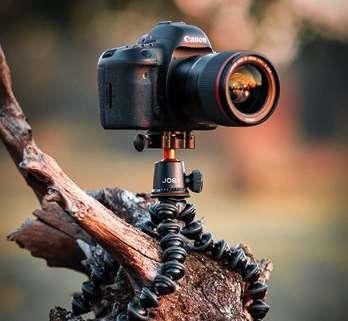
Sturdy stand
Mounting a camera for that hard-to-get shot or video is a lot easier when your tripod can do a lot more than simply stand on a flat surface. The wrappable legs on the JOBY GorillaPod Compact Tripod Kit with Ballhead can be wound around all sorts of objects and surfaces to secure camera gear weighing up to a kilogram, while a rubberised ring and foot grips provide enhanced stability in difficult terrain. Ideal for content creators, vloggers and youtubers, it has a 360-degree panning bed and 90-degree tilt for position control, and is compact and lightweight for easy transport in a pocket, handbag or backpack. PGK227; amazon.com
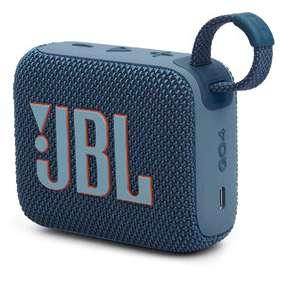
Music master
This speaker may not be big, but it is still bold. The JBLGo 4 Bluetooth speaker fits in a pocket or palm of the hand and delivers clear, loud sound with a rich bass. Being waterproof and dustproof means it’s tough enough for outdoor adventures. A single charge provides seven hours of playtime, which can be prolonged by up to two hours by tapping on Playtime Boost. The latest model features an integrated loop for easy carrying. PGK122; amazon.com
Golden touch
The Shelly earrings draw inspiration from the swirls of the golden sands of one of Sydney’s most stunning beaches. Crafted from nine-carat yellow gold, these earrings are the ideal accessory for everyday elegance, whether you’re heading to the office or dressing down with a casual white tee on the weekend. PGK1870; thecutjewellery.com.au

Carried away
Designers of the Kayton Bag by Carhartt WIP thought of virtually everything when crafting this essential piece of travel equipment. This shoulder bag is not only durable and built for convenience, it has a water-repellent finish so belongings will stay protected in a sudden tropical downpour. Also features a zipped main compartment and interior pocket plus a sturdy handle strap. PGK333; gluestore.com.au


Easy travel
The Globite Underseat Carry On suitcase has performed so well it’s become a favourite with travellers. Reviews are filled with praise for its streamlined features, from 360-degree spinning wheels with the smoothest of glides to the lightweight, durable polycarbonate shell complete with corner guards. The interior has handy zippered compartments, and the case slips easily under your plane seat or into the overhead compartment. PGK729; globite.com

Power up
One of the smallest yet powerful phone charging devices on the market, the credit-card sized TravelCard Plus charger is even slim enough to slip into a wallet. It is compatible with all iPhone models 5 to 16 and comes with a built-in USB-C charge and sync cord to charge USB-C phones and to recharge the device itself, plus a built-in Apple-certified lightning charging cord. PGK248; travelcardcharger.com
BY PAIGE TURNER
ART
Living Art: Papua New Guinea
By Susan Cochrane (Melbourne Books)
This large-format, hardcover book of 336 pages was released for the 50th anniversary of Papua New Guinea’s independence and showcases the work of more than 125 contemporary PNG artists. It is a feast for the eyes. It is lavishly illustrated, showing the eye-catching and inspirational works of artists such as Michael Haure, John Suine, Oscar Towa, Laben Sakale John, Timothy Akis, Elizabeth Kauage and Matthias Kauage. The art of Arison Kul is featured on the cover and Gazellah Bruder has provided digital illustrations specifically designed for the publication.
Culture, politics, history and identity are themes running through the book by Dr Susan Cochrane, an advocate of Pacific artists and writers.
Prime Minister James Marape has provided a preface, there’s a foreword by Steven Enomb Kilanda, who is the Executive Director of the National Cultural Commission, and an introduction by Professor Michael A Mel, Director of the Melanesian Institute for Arts and Communication at the University of Papua New Guinea.
Kilanda writes: “Our artists today are storytellers; their visual language reflects their intimate knowledge of Papua New Guineans’ way of life in village, urban and global settings.”
HISTORICAL FICTION
Isola
By Allegra Goodman (Simon & Schuster)
Available as an audiobook
AVIATION
The Aviator and the Showman
By Laurie Gwen Shapiro (Penguin)
Available as an audiobook
Anyone with an interest in aviation will know that Amelia Earhart disappeared somewhere over the Pacific after taking off from Lae on July 2, 1937, while attempting to become the first woman to fly around the world.
Less is known about the doomed pilot’s marriage to her ambitious publisher husband George Palmer Putnam, who may have contributed to her demise.



It’s widely accepted by aviation historians that Earhart ran out of fuel before she could find her next landing place at Howland Island, but Shapiro reveals that Putnam was a tireless publicist who coaxed his wife into overly risky flights.
Shapiro, an award-winning author and contributor to publications such as The New Yorker and The New York Times, contends that Putnam was obsessed with money and fame. She says the couple’s relationship was a mix of love, tension and mutual ambition. If you like this well-researched work of non-fiction, also try Shapiro’s 2018 bestseller The Stowaway: A Young Man’s Extraordinary Adventure to Antarctica (Simon & Schuster). It’s set in the same era as her Earhart book, telling the story of a plucky young man’s 1928 journey to one of the coldest places on earth.

This is the survival story of 16th-century noblewoman Marguerite de la Rocque, who is marooned on an island. It reads like a well-crafted piece of romance, but it’s an epic saga inspired by real-life events.
Marguerite is destined for a life of prosperity until she is orphaned. Her guardian, Jean Francois de la Rocque de Roberval, squanders her fortune, sells her property to pay his debts and insists she accompany him on a tall ship journey to New France (Canada).
Marguerite, feeling isolated and afraid, develops an attraction to Roberval’s servant. This enrages Roberval, who maroons them on a small island as punishment.
This is when the survival story and transformative journey start.
Commenting on the book, bestselling author Jodi Picoult says Marguerite defines the difference between having a life and truly living.
HISTORICAL FICTION
A Forgotten Land
By Marisa Jones (marisajonesbooks.com)
The is the second book set in Papua New Guinea during World War 2 by self-published author Marisa Jones.
Jones, who has been a contributor to Paradise, writes with first-hand knowledge of PNG and its nuances, having lived in the country for many years, but her books are also extensively researched as they are based around true events.
Her first book was a historical romance novel called A Dangerous Land, released in 2023. It tells the story of Amelia, a white woman, and Daniel, a mixed-race young man, who grapple with the threat of war and societal disapproval of interracial relationships.
The latest offering is based in Rabaul in 1942. It’s a harrowing story of a family’s will to survive the war and it centres on Emma, a fictional character who is loosely based on 18 real-life nurses who were imprisoned and suffered traumas when Japanese forces invaded. n

PNG’s business leaders gather in Brisbane
Papua New Guinea’s leading business figures attended the 2025 Business Advantage PNG Investment Conference in Brisbane in August.
Australian economist Chris Richardson gave the keynote speech at the Brisbane Convention & Exhibition Centre. The 13th annual conference also included panel discussions and an expo.
Among other speakers was the Minister for International Trade and Investment, Richard Maru; futurist and impact investor, Lisa Andrews; the Commissioner and CEO of PNG’s Independent Consumer and Competition Commission, Paulus Ain; the new CEO of PNG Power Limited, Paul Bayly; the President of the Business Council of PNG, Susil Nelson-Kongoi; and KPMG AI expert Francine Hoo.
Richardson provided his key strategies for nations to adopt in the face of increasing global volatility – with building and maintaining strong institutions at the top.

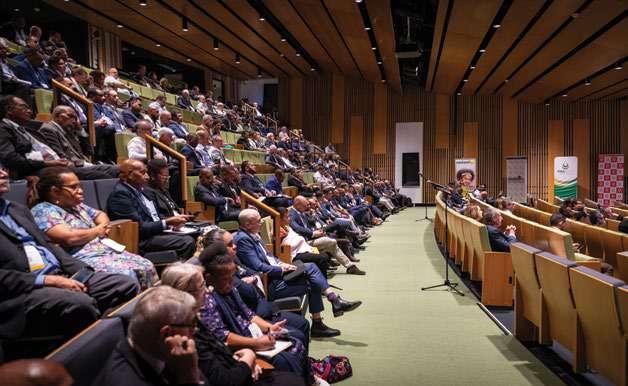

WITH NADAV SHEMER SHLEZINGER PICTURES:
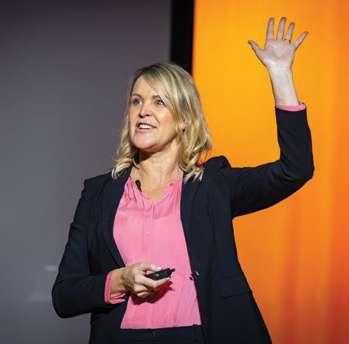

“Rules are often your best friend. And, as the world has changed to become more volatile and more dangerous, institutions are more valuable than they used to be. Why? Because they build and they maintain trust,” he said.
PNG’s High Commissioner to Australia, HE John Ma’o Kali, welcoming delegates to the conference.
Business leaders discussing PNG’s investment climate.
Delegates at the two-day conference also received updates on key projects across different sectors of the PNG economy, and a new Fiji business magazine by Business Advantage was launched.
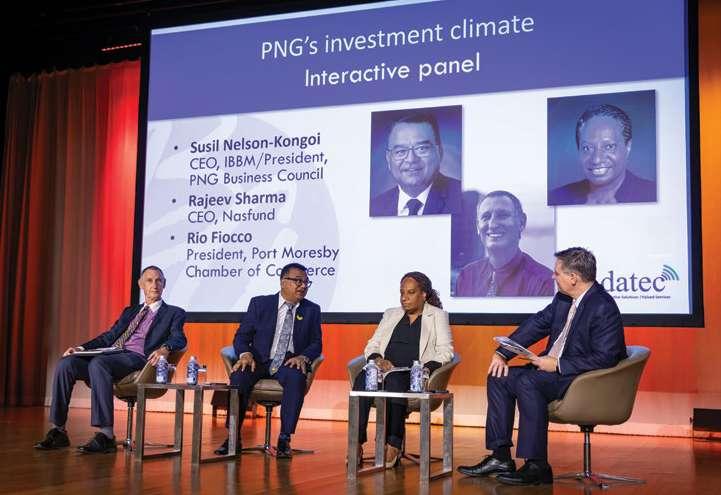
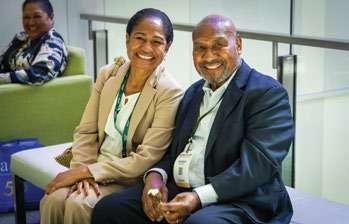
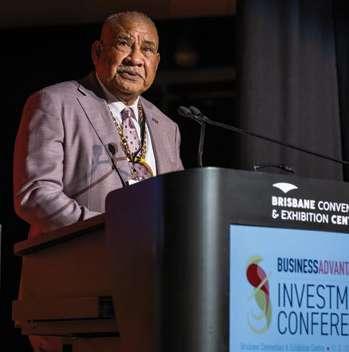
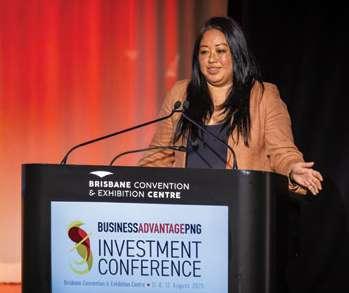
9 10 11 KPMG’s artificial intelligence (AI) expert, Francine Hoo.
The expo area was busy throughout the two-day event.
At the conference photo wall.
12 Delegates receive an update on business opportunities in PNG’s Melanesian neighbour, Fiji.
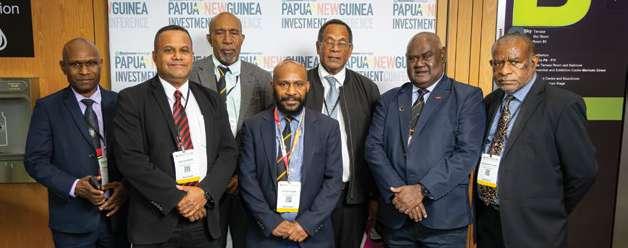







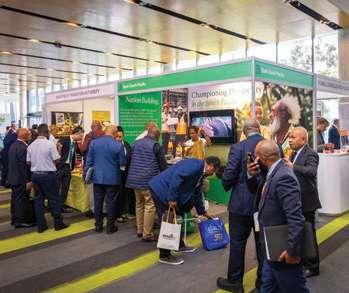





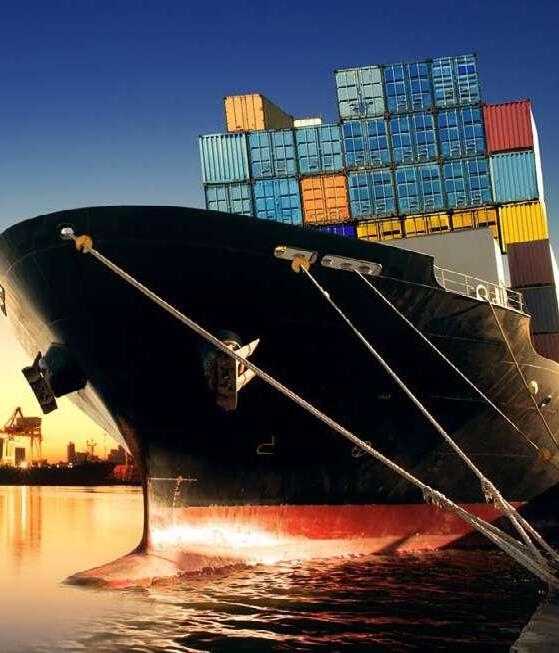





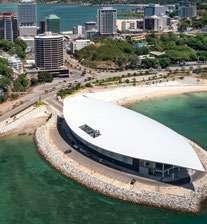
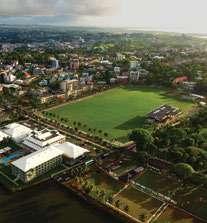
Women blazing a trail in the mining sector
Women are playing an increasingly important role in PNG’s mining sector, and a new committee launched in 2025 is aiming to increase their representation further. Mary Tao speaks with two of the leading female pioneers in the industry.
The Porgera gold mine stood idle for almost four years until operator Barrick Niugini Limited (BNL) reached a deal with the Papua New Guinea government to reopen it in 2023 under a new joint venture, New Porgera Limited (NPL).
When Karo Maha, a commercial lawyer with more than two decades of experience in the extractives sector, was appointed BNL’s country manager in October 2022 (and NPL’s country manager in January 2024), she immediately found


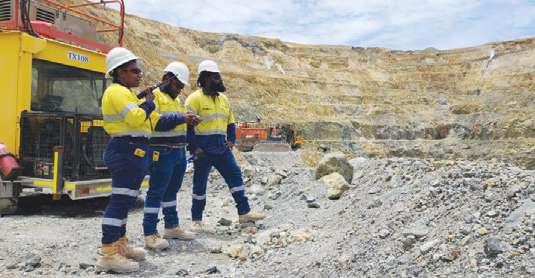
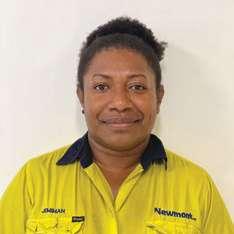
Empowering Papua New Guinea's Future



Barrick Niugini Limited’s Karo Maha (left) and Newmont’s Jemimah Kutkue (above and right).
herself at the centre of these negotiations.
“We have mutual interests. Barrick wanted the mine to restart and Papua New Guinea needed the mine to restart,” Maha says.
Maha, the first ever female country manager of a PNG mining company, took on the task of faceto-face negotiations with Porgera landowners, which came with its own difficulty due to the strong patriarchal beliefs in the area.
“It was very challenging for the Porgeran men to see me standing up in the front and for them to look past the fact that I was a woman,” Maha recalls.
“[For] the first couple of sessions, amongst other things, it was getting them to overlook this and focus on the reasons for the meeting.”
It was very challenging for the Porgeran men to get past the fact that I was a woman.
As the negotiations progressed, Maha says, “I also came to understand how Porgerans behave – how they think, how they negotiate – and I was able to find my voice.”
Another female trailblazer is Jemimah Kutkue, Advisor
– Geotechnical Projects at Newmont’s Lihir gold mine.
Kutkue previously worked in PNG’s civil and construction sector before joining Lihir as a geotechnical engineer five years ago. She found that she was able to apply her technical skills just as easily in the pit as she could on construction sites, enabling her promotion to a supervisory role.
“Geotech engineers look after the safety of mine operations by assessing ground conditions, monitoring rock and soil behaviour, and identifying geohazards such as slope failure or rock fall,” Kutkue says.
“We manage a monitoring system made up of instruments and equipment installed in the pit, and carry out inspections to ensure slope stability.”
Like many women in operations roles, Kutkue works mostly alongside men.
“It can be intimidating sometimes. You will see in this environment that there are a lot of male colleagues,” she says.
“My advice is to be confident, cultivate resilience, have a strong work ethic, and always seek opportunities to grow your skills and knowledge. When you know your field well, you earn respect and your contributions are acknowledged.”
Looking ahead, Kutkue hopes to see more mining, oil and gas companies visit high schools and universities across PNG to encourage girls and young women to pursue careers in fields that involve science, technology, engineering and mathematics.

Mobile wallets on the move in PNG
Charlotte Armstrong examines the key players in PNG’s mobile money market.
As Papua New Guinea’s telecommunications rollout speeds up, financial institutions and telcos are looking at utilising new technology to bring payments and other digital banking services to the unbanked and under-banked population in PNG.
Steven Matainaho, Secretary of the Department of Information and Communications Technology, recently noted that around 4.4 million Papua New Guineans are
registered as having a mobile phone.
The use of mobile wallets –digital banking services that can be performed through a cell phone – could bring in “up to 50 per cent” of the unbanked into the formal financial sector, Vodafone Chief Strategy Officer Ronald Prasad said at the Innovation PNG 2025 conference in Port Moresby. Mobile wallets allow users to send and receive funds and check their balance using their mobile phone. Different systems have other functionalities, including allowing government and
Auditors, Liquidators, Business & Tax Advisers

merchant payments as well as overseas transactions.
Institutions with banking licences are covered for digital banking, including mobile banking, according to the Bank of Papua New Guinea. Several banks have already premiered their mobile money offerings.
Kina Bank’s WhatsApp Banking allows users to text instructions to a Kina Bank WhatsApp account, while BSP’s Wantok Wallet uses USSD technology to allow instructions to be texted to the Wantok Wallet without the use of a smart phone.
Established for 20 years
■ External & Internal Audits of Companies, Associations and Trusts
■ Relief Accounting, System Reviews, Procedures Manuals, MYOB Training and General Accounting Support
■ Start Ups, New Companies, Joint Ventures, Foreign Company Approvals, Registered for Online Lodgments
■ Tax Planning, including Foreign Contracts, International Agreements & Exit Strategies
PROVIDING SPECIALIZED SERVICES TO:
Mining Subcontractors, Agriculture, Construction, Manufacturing Sectors & NGO’s
For a professional, competitive and timely service contact:
John Clarke
FCAUK, FCPAPNG (Principal)
30 years in PNG
Tel 472 7910 Head Office
Fax 472 7908 Lae
Mobile 70428092
Email jc@kapiandclarke.com.pg
CreditBank PNG has partnered with software company Entrust to provide digital and credit card payment solutions through its app.
Others, including TISA Bank, have a variety of options for digital banking, ranging from smartphone apps to USSD technology.
BSP’s Wantok Wallet is among the most accessible services, requiring neither a bank account, internet or smartphone to access the service.
Penelope Aisi, project lead of the Wantok Wallet, says that this vision was part of the product’s creation, and that it is “making digital banking simpler and more accessible for our customers”.
Telcos are also looking to enter the financial services market,
with Digicel’s CellMoni having around 1.6 million individual users, which is around 53 per cent of its customer base in PNG.
CellMoni allows users to “experience bank services using a Digicel number”, CEO Tarik Boudiaf says.
We are in a transition from tangible cash to virtual cash.
Plans are already underway for CellMoni to add merchant services, full capability for international transfers, and other key functionalities modelled off success in other markets.
“We are in a transition from tangible cash to virtual cash,” Boudiaf says.
Meanwhile, Vodafone’s M-PAiSA is looking to be approved for use in PNG with the view of aligning available services to match those in the Fiji market, where Prasad predicts FJ$8.56 billion (PGK16 billion) in mobile money transactions will take place this year (2025).
BSP’s Mark Robinson and Penelope Aisi launching the Wantok Wallet.

BRAIN GYM
QUIZ, PUZZLES, CROSSWORD
DoubleTake
Tackle either set of these clues – you can even mix and match them, because the solutions are the same for both sets.
Wordsearch
Find all the words listed hidden in the grid of letters. They can be found in straight lines up, down, forwards, backwards or even diagonally.
CRYPTIC CLUES
ACROSS
1. Comes across me fixing set (5)
4. Satisfies with hearts and diamonds (5)
7. Erica follows Ma back to the US (7)
8. Starts off drink, actually (4)
12. If he’s free there’s no punishment on the way (4)
14. Business rated poorly (5)
15. Sad to be found with cheese and chips (4)
17. Use outspoken wool producers (4)
21. Sows had twisted tails (7)
23. Appointments with escorts (5)
24. Heaps about mould (5)
DOWN
1. Intends changing names (5)
2. Likely arrival time in planetarium (1,1,1)
3. Shooed ducks out of hut (4)
4. Announce sale of spinnaker (4)
5. I, Zack said, am Abraham’s son (5)
6. Relocate for one day’s work (5)
9. Type of painting burned after midnight (3)
10. Dined in chateau? (3)
11. In light hours, Daisy is not in (3)
12. Catch glimpse of odd Swede (3)
13. Number kept in? Honestly! (3)
15. Band admits beginner is lacking in taste (5)
16. Disturbed by unexpected defeat (5)
18. Result of game is movie music (5)
19. Forbids entry to saloons (4)
20. Digits that feature in photo essay (4)
22. Search half the ocean (3)
STRAIGHT CLUES ACROSS
1. Encounters (5)
4. Tailored ensembles (5)
7. Continent, South ... (7)
8. Cleaning agent, caustic ... (4)
12. Kilted Celt (4)
14. Exchange (5)
15. Once in a ... moon (4)
17. Female sheep (4)
21. Silhouettes (7)
23. Palm fruits (5)
24. Outline (5)
DOWN
1. The ends justify the ... (5)
2. 7th Greek letter (3)
3. Cast (skin) (4)
4. Travel on yacht (4)
5. Scientist, ... Newton (5)
6. Simple dress (5)
9. Lubricant (3)
10. Recanted, ... one’s words (3)
11. Sunup to sundown (3)
12. Bishop’s diocese (3)
13. Unique, ... of a kind (3)
15. Nondescript (5)
16. Shaken (5)
18. Twenty (5)
19. In prison, behind ... (4)
20. Conforms, ... the line (4)
22. Aegean or Caspian (3)
The Paradise Quiz
HOW WELL DO YOU KNOW THE REGION?
1. What is the correct spelling of Port Moresby’s best-known beach: Ella Beach, Ela Beach, or Eli Beach?
2. What is the name of the sea northeast of PNG?
3. What would you find at McDonald’s Corner near Port Moresby: a fast-food restaurant, the start of the Kokoda Trail or a memorial for a famous farmer called McDonald?
4. What is the three-letter code for Madang Airport?
5. What do Papua New Guineans celebrate on July 23 each year?
6. What do 40.6 per cent of Papua New Guineans do: follow rugby league, practise yoga or smoke?
7. More than 150 countries, including PNG, are in the Belt and Road Initiative. What is it?
8. At which Air Niugini destination is it illegal to feed pigeons?
Sudoku
For solutions to the quiz and puzzles, see Page 122.
9. Australia’s National Rugby League is due to expand with a PNG team in 2028. Another expansion team is due to join the league in 2027. Where is the 2027 team from?
10. In which year did Sydney, Australia, host the Olympics?
11. Are Solomon Islanders mainly Melanesian or Polynesian?
12. Fiji is made up of more than 330 islands. How many are permanently occupied: 3, 77 or 110?
13. Who was the first prime minister of Singapore, serving from 1959 to 1990? (Hint: initials LKY.)
14. Who was the authoritarian leader toppled by the People Power Revolution in the Philippines in 1986?
15. Which PNG town are the tourists in the photo looking at?
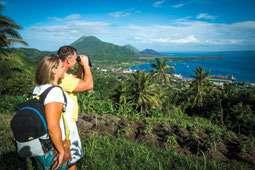

Solutions
The Paradise Quiz
1. Ela Beach 2. Bismarck Sea 3. The start of the Kokoda Trail 4. MAG 5. National Remembrance Day 6. Smoke, according to tobaccoatlas.org 7. A Chinese infrastructure project in which Chinese companies build roads and other infrastructure in foreign countries. 8. Singapore, punishable by a fine 9. Perth, Australia 10. 2000 11. Melanesian 12. 110 13. Lee Kuan Yew 14. Ferdinand Marcos 15. Rabaul





ARRIVALS LOUNGE
PAPUA NEW GUINEA VISITOR GUIDE
Out and about

CLIMATE
Except for the Highlands, Papua New Guinea has a warm tropical climate. The wet season in Port Moresby is from December to April.
COMMUNICATIONS
Internet: Web access in Port Moresby has improved immensely in recent years. Complimentary
Wi-Fi is available at hotels and at Jacksons International Airport.
Phone: International phone roaming is possible in PNG, but it can be costly. A cheaper option is to buy a local SIM card and prepaid credit (including data packs for smartphones). Major mobile networks are Digicel, Telikom PNG and Vodafone. Mobile data is available in cities and towns but may not be available in rural areas.
ELECTRICITY
The current in PNG is 240V AC 50Hz, using Australian-style plugs.
ARRIVING AND GETTING AROUND
Arrival card: PNG launched the PNG Digital Arrival Card (PNG DAC) on October 1. It has replaced the traditional paper-based passenger card for all travellers
entering the country. The PNG DAC can be completed online at pngdac.ica.gov.pg up to three days before travel.
Airport transfers: For arrival/ departure in Port Moresby, hotels provide a complimentary transfer.
Car hire: Major companies include Hertz Car Rental (+675 325 4999/+675 7235 2442) with a self-drive rate of PGK270–485
PICTURE: DAVID KIRKLAND
Port Moresby from the air … the capital city has a population of almost 365,000 people.
ARRIVALS LOUNGE
a day. With a driver it is PGK612–868. Avis Car Rental (+675 324 9400) day rate is PGK315–435 with a PGK4600 bond. With a driver it’s an additional PGK15 per hour. WB Transport Systems (+675 341 3541) day rate is PGK300–1500. With the poor state of roads, especially in Lae, 4WDs/SUVs are recommended.
Domestic flights: Travelling within PNG often means taking an internal flight (for instance, you cannot drive between Port Moresby and Lae). Air Niugini offers passengers the chance to book (and, for some flights, also to check-in) online, but make sure you print out a copy of your receipt to show at check-in. Aircraft and helicopter charters are available for travel to remote locations.
Security firms: They can provide airport transfers if you are not staying at a hotel or if you require transport at night for evening social events. Available 24 hours, quotes are given when you inquire. Recommended firms in Port Moresby are Corps Security (+675 7166 8305), G4S (+675 7999 1700) and Black Swan International (+675 7500 0200). In Lae, recommended security firms are Guard Dog Security (+675 7202 1069) and G4S (+675 472 3999).
Taxis: Recommended firms are City Loop (+675 7715 9338) and Comfort (+675 7615 5663); Expedient Limited (+675 7232 9990) provides shuttle services.
ODESH (+675 7981 8832/+675 7408 6270) is Port Moresby’s first taxi and chauffeur on-demand booking service. See odesh.net or download the app.
HEALTH
Serious medical conditions can be treated in Port Moresby at
the Pacific International Hospital, Paradise Private Hospital and Port Moresby General Hospital, which have emergency services. Some conditions may require treatment outside the country. Travellers should ensure they have adequate health cover. The cost of medical evacuation can be high. Visitors should also note that malaria is prevalent in PNG and there have been cases of measles and tuberculosis.
MEDICAL EMERGENCY
For St John Ambulance phone 111 or 7111 1234. St John provides a 24-hour ambulance service in Port Moresby.
MONEY
PNG’s currency is the kina (PGK). Banks and ATMs are located around Port Moresby, Lae and almost all urban centres.
SHOPPING
BNBM Home Centre: Located at Gordons, sells everything from building materials to homeware and tech items. See facebook. com/BNBMPNG.
Brian Bell Home Centre: Sells a wide range of white and brown goods as well as sportswear and manchester. There are outlets at Boroko and Gordons with a smaller shop at Vision City. See facebook. com/brianbellgroup.
Foodworld: Has two outlets – Waterfront and Gordons. Considered the best grocery shops by many. The Waterfront outlet has a home centre, salon, eye care, clothing and tech shops. There is a Popi’s cafe at both locations.
Rangeview Plaza: Opposite Vision City, the plaza has a big grocery shop, clothing stores and
a salon. The spacious dining area upstairs has multiple food vendors and a playground. There are stalls outside where local artisans sell their crafts, paintings and toana wear. See facebook.com/ RangeviewPlaza.
Stop & Shop: It has outlets all over the city, but recommended locations are at Harbour City and Waigani Central (also home to Jack’s of PNG, Prouds and Hardware Haus). Small businesses are set up in the car park selling meri blouses as well as local art and crafts. An outlet has opened at 8 Mile. See cpl.com.pg.
Unity Mall & Supermarket:
This complex at the Steamships compound in Waigani has small businesses selling PNG-designed outfits, crafts and accessories. You can also find a pharmacy and several hair stations. The eateries offer local cuisine, snacks and coffee. The supermarket sells fresh local vegetables sourced from all over the country. See unitygroup.com.pg.
Vision City: Centrally located in Waigani, the mall has everything from groceries to clothing stores, pharmacies, salons and even a carwash service. The only cinema (Paradise Cinema) in the country is on level 2. You can also find a night club (The Cosmopolitan). Take your pick from the many restaurants and food vendors at the Food Junction. See visioncitypng.com.
MARKETS
Banana Market: Located within the secure Adventure Park premises at 14 Mile, 30 minutes outside the city. Despite its name, you can find a wide range of fresh fruit and vegetables sourced from the gardens of surrounding communities. Open 7am–5.30pm.
Boroko Market: Next to Santos Stadium, this popular market has a great range of local produce. There is limited parking but there is a general understanding to park along the side street with caution. Open 7.30am–5pm.
Ela Beach Craft Market: At the IEA TAFE campus opposite the beach. Held on the last Saturday of each month. Support artisans from nearby Motuan villages and small businesses that sell paintings, bilums, as well as woven baskets, mats and tapa (tree bark) cloth sourced from rural parts of the country. Organised by the Ela Murray International School. Tel. +675 302 3800. Open 7.30am–midday.
Gordons Market: Next to the Gordons police station, it’s the biggest market in Port Moresby with two levels. Well organised, you can find everything from various greens, root crops and seasonal fruit. There is ample parking and security. Open 7am–6.30pm.
Holiday Inn Craft Market: Held on the third Saturday of each month in Cassowary Park. Paintings, wooden carvings and pandanus mats are just a few of the items on sale. Proceeds from the vendor fees (PGK20) and the craft market’s sausage sizzle go to charity. Open 8am–1pm. See facebook.com/ holidayinnandsuitesportmoresby.
Koki Fish Market: Built over the sea, this fish market is the biggest one-stop shop for seafood. Fish like tuna and red emperor caught by local villagers can be cleaned and cut for you. Open 6am–6pm.
Moresby Arts Theatre Craft Market: Located at Waigani (next to Parliament House) ➤
ARRIVALS LOUNGE
find local art, carvings, pottery and jewellery. Enjoy the barbecue, live music and movies for kids. Some craft days have cultural dances and performance art shows. Held on the first Saturday of each month. Entry PGK2. Open 8am–1pm.
PAU Sunday Market: Pacific Adventist University, 30 minutes outside the city, has a market every Sunday, starting at 5am. There’s produce from the school’s farm, including cucumber, watermelon and corn, as well as cooked food from the Pacific.
POM City Markets: If you’re after traditional crafts as well as a whole range of novelty products from small business owners, they regularly set up at the Vision City amphitheatre, National Museum & Art Gallery and Food Republic PNG carpark. They also host the Harbourside Night Markets at the Harbourside Precinct, which includes live music and food. See facebook.com/pomcitymarkets for upcoming dates. Tel. +675 7007 3046.
Some of these locations (as well as all food markets in general) are known for crime so it isn’t recommended that you go alone, or without your own security.

HOTELS
PORT MORESBY
Airways Hotel: Airways is within a large, secure compound next to Jacksons International Airport. An inspiring setting, luxurious rooms, excellent service and very good food options. See airways.com.pg. Tel. +675 324 5200.
Citi Boutique Hotel: The Citi Boutique Hotel is a three-star property in Boroko. It has 60 deluxe queen and twin rooms, a business centre, cable TV and free Wi-Fi. There’s also a day spa and beauty salon, restaurant, bar, karaoke room, and a rooftop terrace. The hotel provides free airport transfers. See facebook. com/citiboutiquehotel. Tel. +675 300 1300.
Citi Serviced Apartments and Motel: There are two Citi Serviced Apartments and Motel properties, one block located at East Boroko and the other at Manu. They are set in safe and secure grounds. The apartments are fully kitted out. They include cable TV, free Wi-Fi, washing machines, dryers, fridges, fans and air conditioning. Housekeeping is also provided. See facebook.com/citiboutiquehotel. Tel. +675 300 1300.
Crown Hotel: Upmarket rooms and suites in the heart of the CBD. Decent gym, business centre, undercover parking, thriving cafe and Mediterranean restaurant. See crownhotel.com.pg. Tel. +675 309 3329.
Ela Beach Hotel and Apartments: On the fringe of the
CBD, this constantly expanding hotel/apartment complex is part of the Coral Sea Hotels group. See coralseahotels.com.pg. Tel. +675 321 2100.
Gateway Hotel: Conveniently located just minutes from Jacksons International Airport, the hotel has a range of dining options, conference facilities, modern gym and two swimming pools. Free airport shuttles are available for guests. See coralseahotels.com. pg. Tel. +675 327 8100.
Grand Papua: This premium hotel is now part of the Raddison group and features 156 suite rooms (short and long stay), an executive floor, gym and conference facilities. The separate restaurant and bar areas are popular for business meetings. Centrally located. See coralseahotels.com.pg/grandpapua-hotel. Tel. +675 304 0000.
Hilton Port Moresby: The capital city’s newest luxury hotel opened in late 2018 and is in the government district 10 minutes from the airport. There are five restaurants, an executive lounge, six meeting rooms, a convention centre, swimming pool and fitness centre. All rooms in the 15-storey hotel include floor-to-ceiling windows. The accommodation includes standard rooms,

The Lamana Hotel in Waigani.
ARRIVALS LOUNGE
executive rooms and suites. See hiltonportmoresby.hilton.com. Tel. +675 7501 8000.
Holiday Inn & Suites: Located in Waigani, the large grounds include a walking track in a tropical garden setting, outdoor restaurant and bar area, business centre and gym. Includes three-star Holiday Inn Express hotel. See ihg.com. Tel. +675 303 2000.
Lamana Hotel: In Waigani, the hotel has 24-hour free airport transfers, free in-room Wi-Fi, a conference centre, restaurants, and the famous Gold Club. See lamanahotel.com.pg. Tel. +675 323 2333.
Loloata Island Resort: This island resort, 40 minutes from Port Moresby, opened in late 2019. There are 68 rooms (including some overwater suites and villas), a day spa and two restaurants. Day passes are available for visitors who aren’t staying overnight, and shuttles are provided from Port Moresby. The island is perfect for swimming, snorkelling, diving, walking or just lounging beside the pool. See loloataislandresort.com. Tel. +675 7108 8000.
Sanctuary Hotel Resort & Spa: The hotel is an oasis in the
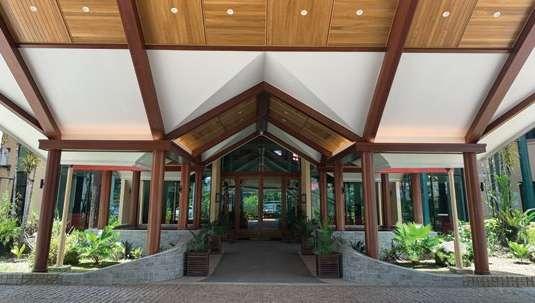
city, located 10 minutes from the airport in North Waigani. There is a lot of greenery in the hotel grounds and a large aviary, which includes the bird of paradise. The hotel, close to government offices, has a business centre, a day spa, swimming pool and a restaurant with a traditional PNG menu with a contemporary edge. It also has rooms and facilities with ramps for people with disabilities. Tel. +675 303 7400.
Shady Rest Hotel: Located at Three Mile, seven minutes from the airport, this affordable hotel has 74 rooms, including newly built executive rooms, conference facilities, a day spa and salon, a small gaming lounge, a tapas lounge, the Indian-inspired Cellar Restaurant and Mr Mike’s Pizza
Company. See shadyrest.com.pg. Tel. +675 323 0000.
Stanley Hotel and Suites:
One of Port Moresby’s newest hotels, this is a luxurious 429room property in Waigani, close to government offices and embassies. It has 95 long-stay apartments, gym, pool, cafe, restaurants and an executive lounge. Connected to Vision City Mega Mall. See thestanleypng. com. Tel. +675 302 8888.
LAE
Crossroads Hotel: A 45-room facility at Nine Mile. The hotel has a Japanese-themed teppanyaki restaurant with Asian/Western fusion menus, full bar service, a well-equipped gym, Wi-Fi and complimentary transfers to both
Lae City and the airport. Tel. +675 475 1124.
Hotel Morobe: A centrally located boutique with 38 elegantly decorated rooms. See hotelmorobe.com. Tel. +675 4790 100.
Huon Gulf Hotel & Apartments: Has comfortable rooms, conference rooms and a pool, located in the industrial part of town. The restaurant offers Italian cuisine and there are two bars. See coralseahotels.com.pg/huongulf-hotel-apartments. Tel. +675 7999 0100.
Lae City Hotel: Located in the main Top Town area, this hotel has 24-hour concierge, gym and an excellent cafe and restaurant with Western and Asian cuisine. See laecityhotel.com. Tel. +675 472 0138.
Lae International Hotel: The city’s premier hotel has recently renovated rooms, full bar service, conference and banquet halls, a gym and pool. See laeinterhotel.com. Tel. +675 472 2000.
Lae Travellers Inn: An affordable option, offering clean and comfortable rooms. There is a car rental service on the inn’s premises and their restaurant ➤
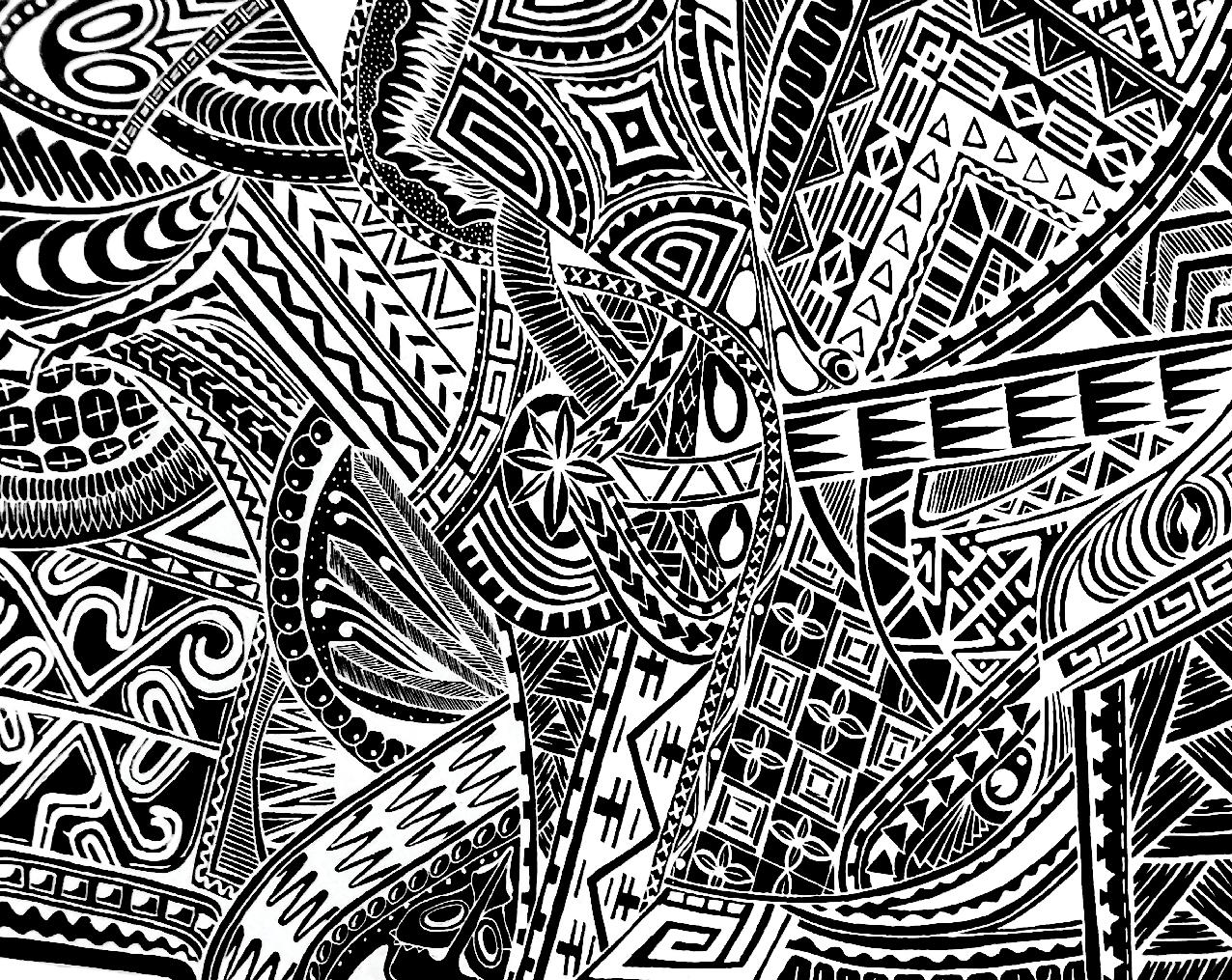

The renovated Lae International Hotel.
ARRIVALS LOUNGE
offers curry takeaway. See laetravellersinn.com. Tel. +675 479 0411.
EATING & DRINKING
PORT MORESBY
Airways Hotel: Port Moresby’s ritziest hotel has several places to eat. If you’re after fine dining, Bacchus is the place to go. For something more casual, go poolside to Deli KC or 7C’s past reception. The Vue Restaurant has a buffet each morning, lunch and evening. The Filipino-themed buffet is a winner. There is also an a la carte menu and stunning views. The tandoori dishes come highly recommended. If you’re after a drink, have cocktails and beers at the Balus Bar. For an exclusive experience, head to the
Havanaba Bar to enjoy a cigar with your pick of top-shelf wines and spirits. See airways.com.pg. Tel. +675 324 5200 and +675 7373 2600.
Akura: An elegant dining and lounge bar at Harbourside that is a popular spot for after-work drinks Try their beef vermicelli salad or pop in for Taco Tuesday. Tel. +675 7320 7777. See instagram.com/ akurapng.
Alibi Bar & Grill: At the Harbourside precinct, open for lunch and dinner daily. There’s a kid’s playground if you’re making it a family day. Fridays and Saturdays bring in a big night crowd and the bar stays open until late. Try their platters: the Surf & Turf, Meat Lovers and the Fisherman’s Basket with a view of
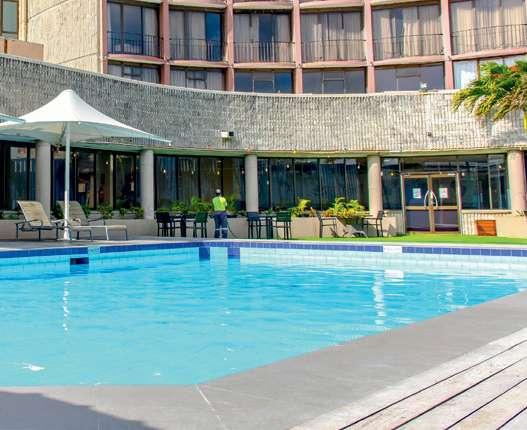







the harbour. See facebook.com/ alibipng. Tel. +675 7320 7777.
Ang’s Restaurant: No-frills Chinese hidden away in an industrial block opposite Brian Bell’s Gordons Plaza shopping centre. Roast duck is the signature dish. Tel. +675 323 0863.
Asia Aromas: Offering Chinese and Thai food by the water at Harbourside, this eatery has consistently good reviews on social media. Outdoor seating is available. A good spot for sunset drinks. Tel. +675 321 4780.
Aviat Port Moresby Club: The club is open for breakfast, lunch and dinner. Home-style meals include stir-fries, toasted sandwiches, salt-and-pepper prawns and a pizza menu.
This is a great spot to sit at lunchtime under the shady mango trees, or in the airconditioned bar. See facebook. com/Aviat-Club.
Crown Hotel: For fine dining, choose Rapala Restaurant, its menu a mix of Western and Middle Eastern dishes. It’s open 6pm to 10pm. All-day dining is available at The Cafe, opens at 6am. Every Saturday night, the hotel hosts an International Street Food Festival, featuring popular dishes from around the world. See crownhotel.com.pg. Tel. +675 309 3000.
Crowne Plaza Residences:
The Port Terrace Restaurant & Bar has views of Fairfax Harbour, and all-day dining. It’s open 6.30am to 10pm. Try a power juice for








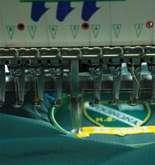

ARRIVALS LOUNGE
breakfast, chicken parmy for lunch or chilli lobster for dinner. The extensive menu also includes burgers and steaks, as well as share plates. Great spot to watch the sunset with a beverage, with wine, beer, spirits and cocktails on offer. See portrestaurant.com.pg. Tel. +675 308 3100.
Cuppa Cafe: Has a rustic setting with great breakfast options, pasta dishes, burgers and salads. The snack bucket – a large bowl of fried chicken, onion rings, prawns, battered fish, spring rolls and chips – is perfect for sharing. Try their coffee or a range of healthy smoothie combos. Tel. +675 302 8666.
Daikoku: The extensive Japanese menu has teppanyaki, donburi bowls and a large range of sushi. ‘All-You-Can-Eat’ grilled skewers available every Thursday night. You can find them at Stop & Shop Harbour City (first floor) and the Harbourside Precinct. See daikokupng.com. Tel. +675 7375 3130.
Duffy Cafe: Known for excellent coffee and homemade cafe-style food and bakery items, Duffy has three locations: at Harbourside, Gordons and Jacksons International Airport. You can order your breakfast ahead of time for those busy work mornings. You can also find their bread on sale at Waterfront Foodworld. See duffypng.com. Tel. +675 325 8528.
Dynasty at Vision City: This may be the biggest restaurant in Port Moresby. Its size, its chandeliers and its gold decor make it a favourite for balls, dinners and parties. The menu is huge, too, with pages of Asian dishes. The crispy lemon chicken is a favourite. See facebook.

com/100064086213057. Tel. +675 302 8538.
Edge by the Sea: The Edge cafe has alfresco dining with a wonderful marina outlook from the ground floor at the Edge Apartments in Harbour City. Eggs benedict, burrito bowls, pork burgers and grilled snapper are among the breakfast and lunch menu favourites. Try their Turkish lahmacun. There’s a mist water system in the alfresco area that can reduce the ambient air temperature by up to 10 degrees, perfect for those blisteringhot days. See facebook.com/ edgebythesea/. Tel. +675 7995 5263.
Ela Beach Hotel: Drop in to Salt Restaurant for casual all-day dining, including curry, burgers and wok dishes, or pizza at Enzo’s. The Beachside Bakery has a great range of sweet treats and coffee that you can enjoy in outdoor seating. See coralseahotels.com.pg. Tel +675 7998 6510.
Fusion Bistro: A fusion of flavours from China, Thailand and Vietnam. Located in ENB Haus, Harbour City. Takeaway available. Tel. +675 7196 6666.
Gateway Hotel: The hotel’s dining options include the Wild Orchard for breakfast and dinner buffet daily, Jackson’s Gaming–Restaurant–Bar, which has a rooftop bar with views of the airport, as well as claims to the best lamb rack in town, Sizzler’s Family Restaurant for value dining (PGK60 buffet), while Enzo’s Express does quick lunches, coffee and pizza. Deli Cafe serves excellent milkshakes and the hotel’s own range of bread and pastries. See coralseahotels.com. pg. Tel. +675 7999 0200.
Grand Papua Hotel: The elegant Grand Brasserie has an a la carte menu of modern European cuisine, as well as buffet options – Asian on Tuesday and seafood on Friday. The Grand Cafe, on Douglas Street, has barista-made Goroka coffee, fruit juices, freshly made salads and sandwiches. The Grand Bar – with stylish marble, high ceilings, timber floors and window shutters – has a light menu and is a popular place to wind down after work. See coralseahotels. com.pg/grand-papua-hotel. Tel. +675 7999 0000.
Hilton Port Moresby: The hotel has five eating areas including
Mumu, which is named after the traditional earthen oven of PNG, and serves traditionally inspired dishes. There’s also a top-floor lounge bar called Summit, cafe-style dining in Copper on the lobby level, all-day dining and a breakfast buffet at Feast, including a Southeast Asian buffet every Wednesday night, and quick bites, such as sandwiches and coffee, at Halo in the convention centre foyer. See hiltonportmoresby.hilton.com. Tel. +675 7501 8000.
Hilton Residences: The Host Deli, Bistro & Bar on level two has a relaxed modern vibe with ample seating options. The Super Bowl (roasted cauliflower, falafel, poached egg, chickpeas with hummus, labneh and haloumi) comes highly recommended. If you’re on the go, the delicatessen bar offers fresh fruit, pastries, sandwiches and desserts. Opens at 6.30am and stays open till late for drinks. See hiltonportmoresby. hilton.com. Tel. +675 7501 8000.
Holiday Inn & Suites: The Kopi Haus Restaurant has breakfast from 6am, lunch and dinner. It has a la carte as well as a buffet, with the cuisine including PNG flavours. Expect themed buffets (such as barbecue and flavours of Asia) from Wednesday to Friday. The poolside Gekko Bar opens at midday and includes a big screen for sports telecasts and tasty bites to go with a range of wines, cocktails and local and international beers. See ihg.com. Tel. +675 303 2000.
Hosi Ramen: As the name suggests, this Japanese restaurant at Vision City specialises in ramen (noodles served in broth with meat and vegetables). A party of up to ➤
Airways Hotel has several restaurants, ranging from casual to buffet to fine dining.
ARRIVALS LOUNGE
15 people can opt for a hotpot session. Tel.+675 302 8555.
Jeanz Cafe: A family-friendly cafe with ample seating that proudly serves PNG Arabica coffee. Located in Gordons Plaza, it has a great range of salads, pastries and sandwiches. See gordonsplaza.com.
Kofi “N” Kai: A cafe located in BNBM Home Centre with ample lounge seating. Try the ham and cheese croissant or indulge in dessert options like Oreo cheesecake, carrot cake or the almond and pecan tart. Tel. +675 775 74399.
Korean Garden: An affordable menu at Vision City that includes a do-it-yourself barbecue, as well as traditional favourites such as kimchi and gimbap. See facebook. com/koreangardenpng. Tel. +675 302 8534.
Lamana Hotel: Choose from options including Spices Restaurant (Indian), the Italian Restaurant, Cafe Palazzo and PNG’s biggest nightclub, The Gold Club. The 360 Bar has great night views, and exclusive birthday fireworks can be organised. See lamanahotel.com.pg. Tel +675 7373 0600.
Loloata Island Resort: The private island has two restaurants.


Bootless Bay is spacious with high ceilings and an open-plan style that provides a panoramic view of the sea. They serve a highly recommended breakfast and lunch buffet. The vibe at night makes it the perfect spot for a dinner date. The Beach Club upstairs is a great spot for special events like corporate dinners, birthdays and weddings. See loloataislandresort. com. Tel. +675 7108 8000.
Lucky Lucky: Informal but classy Thai cuisine at the Nambawan Super Plaza. Town and harbour views, alfresco dining. Go-to dishes include pad Thai noodles and the charcoal-grilled pepper beef sirloin. Tel. +675 7995 5264.
Mojo Social: This casual Mediterranean-inspired bar and restaurant is on the ground floor of PWC Haus at Harbour City. Tapasstyle dishes, risotto and pizza are among the offerings. Try the new Mexican dishes during a regular Taco Tuesday. See mojofood.co. Tel. +675 7995 5264.
Pentagon Entertainment: On the former Laguna Hotel premises. Guests can enjoy indoor and outdoor seating. There is also a family-friendly pool area. Try some of the signature dishes like biryani stuffed roasted chicken, crispy pork sisig, and salmon in an orange glaze. Tel. +675 325 1068.
PGO!: PNG’s first online delivery service. Their vendors include Burrito Central (Port Moresby’s first Mexican takeaway), Port Terrace, The Dirty Kitchen, Abus na Kumu (translates to ‘meat and greens’), Fusion, Kopibin, Mr Mike’s Pizza, The Cellar, Juice Bar and Marcus Kitchenette and Catering and many more. See phipax.com.
Port Terrace: Fast becoming a popular lunch and dinner spot, the restaurant and bar is in the Crowne Plaza Residences. There are grilled dishes, share plates like a seafood or sticky pork ribs platter, and homemade pasta dishes. There’s a new cocktail to try every month. See portrestaurant.com.pg. Tel. +675 308 3100.
Red Rock Bar: Located at Dogura, 6 Mile (along Magi Highway). Be prepared for an uphill drive to the bar but it’s worthwhile for the spectacular sunset. Try the Red Rock burger or sizzling lamb and pork with a table in the outdoor area. Tel. +675 8214 7357.
Royal Papua Yacht Club:
Relaxed, spacious and open to non-members. Comfort food, draught beer and an open-plan bar area showing sport on large screens. There is a themed

Kavieng, situated at the northern tip of the island, is a picturesque destination offering tropical diving and snorkelling, surfing, fishing and kayaking through pristine tropical waters littered with amazing islands to explore.
The Kavieng Hotel is centrally located in town, a short walk from the markets and the Kavieng Golf Club. Whether you’re here on business or a family beach holiday, Kavieng Hotel caters for every traveller.
The pool area at Loloata Island Resort.
ARRIVALS LOUNGE
cocktail night each Thursday. See rpyc.com.pg. Tel. +675 321 1700.
Seoul House: This restaurant specialises in Korean, Thai and Chinese cuisine, cooked on a hotplate in front of you. The dishes include a seafood platter of coral trout, mussels and shrimp, and Singapore-style chilli crab. Seoul House is tucked away in a garden oasis compound in Five Mile. The owners also have a cafe at the Jacksons International Airport, Hotspot. Try the black forest cake and croissant sandwich while waiting for your flight. Tel. +675 7823 3075.
Shady Rest Hotel: The Indian dishes at the hotel’s Cellar Restaurant draw high praise from reviewers on TripAdvisor. The restaurant also prides itself in its steaks. Mr Mike’s Pizza Company is a takeaway located at the hotel and has classic pizzas, such as Hawaiian and margarita, as well as gourmet pizzas such as the Mediterranean, which is packed with feta, olives, mushrooms and more. Bakeology Cafe & Bakery offers alfresco dining surrounded by lush greenery. Enjoy a range of sandwiches, salads, pastries, desserts and freshly baked bread. See shadyrest.com.pg. Tel +675 323 0000.


Stanley Hotel and Suites:
This Waigani hotel has several restaurant choices. On the 19th floor, the Silver Leaf offers intimate fine dining with stunning night views. The Executive Lounge (for guests staying on the 14th to 18th floors) offers breakfast, allday snacks and cocktail canapes. A walk up the stairs from the lounge takes you to the Mezz Bar, which offers premium spirits. There is also a smoking deck. The chic tapas-style Monsoon Lounge is on the ground floor. Green Haus restaurant has all-day dining, including buffet dinners with live cooking stations. Choose your own combo at the new juice station available at breakfast and
lunch. The serene Rainforest Cafe, close to the check-in area, has coffee, desserts and pastries. See thestanleypng.com.
Tandoor on the Harbour: Come here for a curry with great bay views. The butter chicken with garlic nan is classic. See facebook. com/tandoorontheharbour. Tel. +675 3201 910.
Tasty Bites: This cosy traditional Indian restaurant is tucked away in the town centre in Hunter Street near Crowne Plaza (ANG Haus). A great spot for quick and affordable meals. Try the vegetable noodles with chicken strips or the pizza menu. Deliveries available. Tel. +675 321 2222.
Tribes Coffee Club: This cafe has two locations: Oasis building in the Steamships compound, Waigani, and Lawes Road, Ela Beach. All-day dining available. The seafood platter with crab, shrimps and the catch of the day is a dinner favourite. Tel. +675 321 0455.
Tuna Bay Resort: Located in Taurama, just five minutes from Manu. Enjoy battered fish and chips, char-grilled rump steak and boneless chicken that comes with a side of garden salad and chips. There is indoor and outdoor dining, with bay views. Tel. +675 7920 8777.
LAE
Bulolo Golf and Country Club: Lae’s newest restaurant has an a la carte menu with indoor dining and an outdoor deck overlooking the course. The Bulolo T-bone steak is said to be among the best in the country and is sourced locally. Try ‘Papa Tony’s Pizza’, a stone-baked pizza created by the club’s chefs. See facebook.com/ bulolocountryclub. Tel. +675 7358 7161.
Bunga Raya: This local favourite, serving Malaysian-style Chinese, is located next to the Lae Golf Club. Be sure to try the stuffed lettuce cups, laksa and claypot tofu. ➤

Thai cuisine at Lucky Lucky in the Nambawan Super Plaza.
ARRIVALS LOUNGE
They’ve added boba milk tea and their own range of fruity sodas to the drink’s menu. See facebook. com/bungarayarestaurant. Tel. +675 472 7177.
Cafe 411: There’s a cosy atmosphere at this casual cafe next to Hotel Morobe on Coronation Drive. The Westernstyle menu includes finger foods and PNG coffee. Try the T-bone steak with mushroom sauce if you’re after something hearty. Tel. +675 479 0100.
Huon Club: This private members’ club offers airconditioned facilities, comfortable lounge chairs, an expansive deck overlooking the Lae Golf Club, a fully stocked bar and Foxtel to preview all the racing and sporting events. Open on Wednesday and
Friday, members can enjoy regular lucky key draws and a barbecue menu. Inquiries to Lae Golf Club. See laegolfclub.com.pg. Tel. +675 472 1363.
The City Cafe: Located in the Lae City Hotel on 3rd Street, the cafe serves Western and Asian cuisine. The signature dishes include ribs and nasi goreng. Tel. +675 472 0138.
Lae Garden Restaurant: The Asian menu includes staples such as crispy chicken, butter prawns and the Malaysian dish nasi lemak. The elegant restaurant, inside Hotel Morobe on Coronation Drive, offers breathtaking views of the city from its balcony. A great venue for big dinner parties. Tel. +675 479 0100.

Lae Golf Club: The club is excellent for a few sundowners as you overlook the stunning green with access to the excellent bar. Apart from golf, you can enjoy the basketball and tennis courts. See laegolfclub.com.pg. Tel. +675 472 1363.
Lae International Hotel: Home to three restaurants –Luluai’s Italian Pizza, Vanda and Kokomo – which serve an array of international cuisine, including Indian and seafood buffets. The Sportsman’s Bar (aka Jack’s Bar) is a good place for a nightcap. See laeinterhotel.com. Tel. +675 472 2000.
Lae Yacht Club: The perfect place for late-afternoon beers, or just as nice for a relaxing lunch. Serves pub-style food. Try the
Cajun grilled fish of the day. See laeyachtclub.com.pg. Tel. +675 472 4091.
Mountain View Restaurant: Located at the Crossroads Hotel at Nine Mile. Try the newly curated menu, which is a mix of Western and Pacific cuisine. Ramu steaks are a favourite. Great spot for cocktails and wine. See crossroads-hotel-lae. mydirectstay.com. Tel. +675 475 1124.
Ocean Restaurant: Located at Aviat Club, it’s a popular seafood spot. Offers authentic Asian cuisine and local dishes. See facebook. com/p/Ocean-RestaurantLae-100049129045632. Tel. +675 7370 3045. n
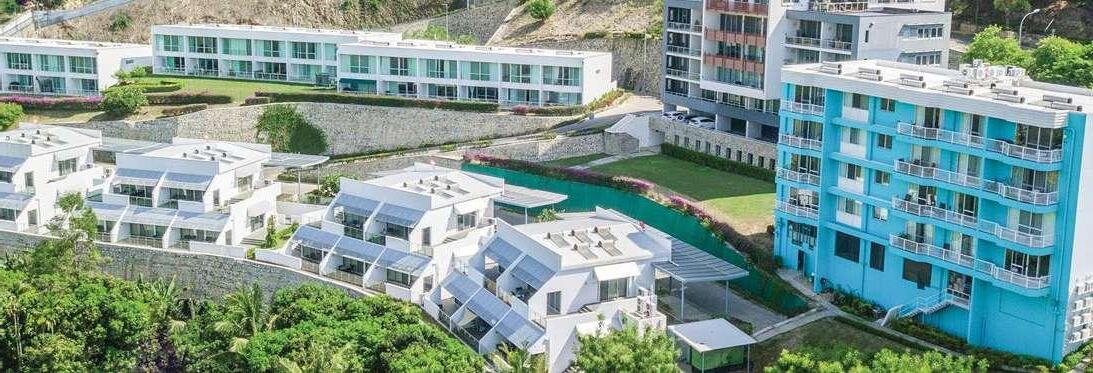


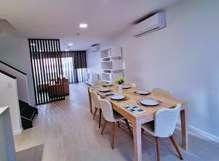
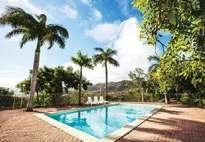



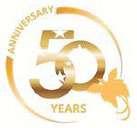
Papua New Guinea has more than 800 languages, but the three official languages are Tok Pisin, English and Motu. Here, we outline some Tok Pisin, which is the largest lingua franca of PNG.
Where do I find a taxi?
Bai mi painim taxi long we?
One coffee with milk, please. Wanpela kap kopi wantaim milk plis.
Where is the toilet?
Toilet istap we?
Numbers
How much is this?
Hamas long dispela?
Thank you very much. Tenkiu tru.
You understand English?
Yu save long tok Inglis?
Where is my bag?
Bag bilong mi istap we?
Where can I change my money?
Wanem hap bai mi ken senisim moni bilong mi?
One beer, please. Wanpela bia plis.
Why? Bilong wanem?
How many children do you have? Yu gat hamaspla pikinini?
Where are you from?
Yu bilong wanem hap?
I don’t know. Mi no save.
What do you want? Yu laikim wanem samting?
1 Wan 2 Tu 3 Tri 4 Foa 5 Faiv 6 Sikis 7
Restaurant Ples bilong kaikai
Goodbye Gutbai
Hello Halo
Water Wara
Baggage Kago
Airport Ples balus
Place Ples
Fish Pis


AIRLINE NEWS
THE LATEST FROM AIR NIUGINI
PNG showcased at Singapore travel shows
Air Niugini and the Papua New Guinea Tourism Promotion Authority (PNGTPA) have made a historic debut in Singapore, jointly showcasing PNG at two major travel events.
Under the theme ‘Experience the Splendour of PNG with Air Niugini’, they attended the National Association of Travel Agents Singapore (NATAS) Travel Fair and the Changi Jewel Destination Awareness Campaign.
The initiative stems from a partnership between Air Niugini and Changi Airport Group, with the aim of positioning PNG as a must-visit new destination for Asian travellers.
The three-day NATAS travel fair, one of Asia’s leading travel exhibitions, drew more than 106,000 visitors and provided a platform to highlight PNG’s
WITH ILLAN KAPRANGI, MANAGER CORPORATE COMMUNICATIONS


natural beauty, cultural richness and premium tourism offerings.
With leading PNG hoteliers and tour operators, visitors were introduced to bespoke holiday packages.
Air Niugini is forging new pathways to develop the PNG tourism experience.
Air Niugini’s Chief Commercial Officer, David Glover, said:
“Participation in these events strengthen PNG’s brand visibility in Asia, creating opportunities for Air Niugini to forge partnerships, increase bookings, and position itself as the preferred carrier

connecting Singapore and Asia with Papua New Guinea and the Pacific.
“At the same time, the PNGTPA has amplified the country’s profile as a destination that offers unique cultural encounters, pristine adventure, and organic treasures like world-renowned coffee and cocoa.”
Air Niugini Chairman, Karl Yalo, also attended the event. He said: “Air Niugini is forging new pathways to develop the PNG tourism experience. I am immensely proud of our achievement in Singapore. Primarily, we aim to increase demand for our services from the Asia market into PNG. We have
tremendous untapped potential – our new fleet offers the opportunity to bridge the gap.”
The Galomarubu Kitoro Cultural Group from Central Province, together with Asaro Mudmen and representation from Southern, Western and Chimbu provinces, delivered a breathtaking performance at Changi Airport’s Rain Vortex – the tallest indoor waterfall in the world.
Their ancestral war dances, kundu drum beats and traditional songs created a vibrant spectacle, captivating audiences and sharing the spirit of PNG with Singapore. n
Air Niugini hosts future PNG leaders
Air Niugini has hosted a Young Port Moresby Chamber of Commerce and Industry (YPOMCCI) networking event, bringing together more than 100 young professionals, students and entrepreneurs.
As the major sponsor of YPOMCCI for 2025, the airline reaffirmed its commitment to
supporting Papua New Guinea’s next generation of leaders.
The event offered a dynamic platform where future business leaders engaged with Air Niugini management and staff, shared ideas and strengthened professional connections.
The YPOMCCI plays a vital role in shaping the future of PNG’s business landscape. It is a hub
for innovation, collaboration and professional growth.
Air Niugini’s Officer in Charge and Acting Chief Operating Officer, Captain Samiu Taufa, told attendees that as emerging leaders they have an important role in shaping the nation’s future.
“As young people, you represent the future of Papua
New Guinea. Through platforms like this, you can drive meaningful change and contribute to building a stronger and more prosperous PNG. As responsible leaders, always uphold good governance and integrity as they are not just values, they’re the foundation that shapes how you earn trust, make decisions, and create lasting impacts.” n
The Galomarubu Kitoro dance group at Changi Airport; Asaro Mudmen attracted major interest; a PNG booth at the travel fair.
Air Niugini takes part in airshow
Air Niugini took part in the spectacular airshow in Port Moresby on September 16 that was part of the celebrations marking Papua New Guinea’s 50th independence anniversary.
The national airline joined the Papua New Guinea Defence Force (PNGDF) and international partners in presenting a memorable showcase of aviation skill and unity.
Air Niugini’s Boeing 767, P2-PXW, bearing the national colours, was operated by three PNG captains: Maurice Rondeau, Esmond Yasi and Samiu Taufa. The aircraft performed controlled manoeuvres, including a spectacular ‘go-around’ to the delight of thousands of people watching from Ela Beach.
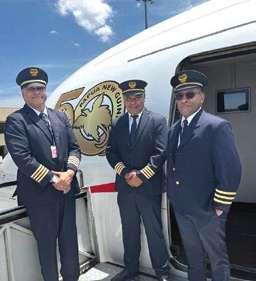
The airshow, coordinated by the PNGDF air transport wing, brought together the PNGDF alongside the Defence Forces of Australia, New Zealand, the US and France with ceremonial support from Air Niugini as a civilian airline.

Airline staff celebrate independence
Air Niugini staff and management (pictured) came together in September for a flagraising ceremony at the airline’s head office at 7 Mile. Many of the staff were in independence wear and traditional attire.
The airline’s Chief People’s Officer, Andu Rawali, spoke passionately about Air Niugini’s diversity, strength, and shared commitment to integrity and patriotism, emphasising that the airline is one team moving forward together. n
Captain Taufa, who is also Air Niugini’s Officer in Charge and Acting Chief Operating Officer, expressed his pride in the airline’s participation.
“This was more than just a flyover – it was a proud moment for our nation. To have Papua New Guinean pilots at the controls of our own national airline’s aircraft, flying over our capital city on such an important milestone, is deeply symbolic.
“We thank the PNG Defence Force for including Air Niugini in this historic airshow, and we dedicate this participation to the people of Papua New Guinea. The people saw their own sons in the cockpit, representing the skills, dreams, and pride of our country.” n
Strategy for the future
Air Niugini brought together its top sales executives, regional managers, supervisors, and key stakeholders at the Gateway Hotel in Port Moresby recently to strategise about future growth and innovation.
The conference featured discussions on market expansion, customer engagement and sales strategies.
Experts provided presentations in several areas, including yield management, ecommerce, loyalty programs and cargo. n

Shining a light on renewable energy
Air Niugini has partnered with Airbus and SolarBuddy to promote STEM (Science, Technology, Engineering and Mathematics) education and renewable energy solutions in Papua New Guinea.
In August, students from Paradise College in Port Moresby participated in a hands-on program where they assembled solar-powered lights (pictured), helping bring light to communities lacking electricity. Over 500 students engaged in this inspiring activity, gaining practical skills and environmental awareness.
The initiative also included aviation workshops and career talks with Air Niugini staff, including our first Papua New Guinean Airbus A220 Captain, Beverly Pakii.
Thanks to SolarBuddy’s distribution efforts, these solar lights will reach communities in Western Province, symbolising hope and brighter futures for children to study after dark. n
From left, Air Niugini captains Samiu Taufa, Maurice Rondeau and Esmond Yasi.
WELCOME ABOARD
ENJOY OUR BIRD OF PARADISE IN-FLIGHT SERVICE
PLEASE ASK US
If there is anything our cabin crew can assist you with during your flight, please do not hesitate to ask them.
HAND LUGGAGE
Please ensure that your carry on luggage is placed in the overhead locker or under the seat in front of you.
TAKEOFF AND LANDING
Ensure that your seat is in the upright position during takeoff and landing. Folding tables must be returned to their original position in the seat back or the armrest.
SAFETY FIRST
Your seat belt must be securely fastened during take off and landing or whenever the seat belt sign is on. When the seat belt sign is off you may move about the cabin as necessary. However while seated, keep your seat belt fastened securely in case of unexpected turbulence.
ELECTRONIC EQUIPMENT
Cellular telephones, TV receivers or radio controlled devices are not to be used at any time on board an aircraft. Electronic devices such as portable computers, compact discs or cassette players and video games can be used only when the seat belt sign is switched off.
CHILDREN AND BABIES
The cabin crew will also be pleased to assist in preparing your baby’s food and bottle. Baby food and diapers are also available. Please do not hesitate to ask our friendly cabin crew.
SMOKING
Smoking is not permitted on any Air Niugini flight.
ENTERTAINMENT
A selection of movies and music including classical, modern, country and local are available on international services.
PILLOWS AND BLANKETS
On International flights, pillows and blankets are available on request from our cabin crew.
CUISINE
Our in-flight* meals have been specially prepared for your enjoyment. If you require a vegetarian meal or you are on a special diet, child or baby food, please inform us when making your reservation.
IMMIGRATION AND CUSTOMS FORMS
During your flight, our cabin crew will distribute Immigration and Custom forms before each landing point. Ensure that you carefully read and complete these documents and have them ready for inspection with your passport at the Immigration and Customs arrival counters.
BEFORE YOU LEAVE
Please check your seat pocket and overhead lockers before you disembark to ensure you have not left any items of value. We look forward to seeing you when you next fly with us on our Bird of Paradise Service.

B737-800 P2PXB 10J/150Y – Boeing
Length: 39.5M
Wing Span: 35.79M
Range: 5000-5500KM
Cruising Speed: 810-850KPH
Power Plant: 2 x CFM56-7B27E

B767-300ER - Boeing
Length: 59.94m
Wing Span: 47.57m
Range: 8100km
Cruising Speed: 857kph
Power Plant: 2 x PW4000
Normal Altitude: 11000 - 12000m
Standard Seating Capacity: 188
Business Class: 28
Economy Class: 160
Number of Aircraft in Fleet: 2

F70 – Fokker
Length: 30.91m
Wing Span: 28.08m
Range: 3410km
Cruising Speed: 743kph
AIR NIUGINI FLEET
Normal Altitude: 11300m
Standard Seating Capacity: 162
Business Class: 10
Economy Class: 150
Number of Aircraft in Fleet: 01

B737-800 P2PXC 16J/128Y - Boeing
Lenght: 39.5M
Wing Span: 35.79M
Range: 5000-5500KM
Cruising Speed: 810-850KPH
Power Plant: 2 x CFM56-7B27E
Normal Altitude: 11300m
Standard Seating Capacity: 154
Business Class: 16
Economy Class: 128
Number of Aircraft in Fleet: 1

F100 – Fokker
Length: 35.53m
Wing Span: 22.08m
Range: 3000km
Cruising Speed: 780kph

B737-800 PXA - Boeing
Lenght: 39.5M
Wing Span: 35.79M
Range: 5000-5500KM
Cruising Speed: 810-850KPH
Power Plant: 2 x CFM56-7B27E
Normal Altitude: 11300m
Standard Seating Capacity: 154
Business Class: 16
Economy Class: 138

DHC8-400 - Bombardier
Lenght: 32.8M
Wing Span: 28.4M
Range: 3000KM
Cruising Speed: 670KPH
Power Plant: 2 x Rolls Royce Tay 650-15 turbo engines
Normal Altitude: 11000m
Standard Seating Capacity: 73
Business Class: 8
Economy Class: 65
Number of Aircraft in Fleet: 3

DHC8-202 – Bombardier
Length: 22.25m
Wing Span: 25.89m
Range: 1800km
Cruising Speed: 550kph
Power plant: 02 x Pratt & Whitney PW123D
Normal Altitude: 7600m
Standard Seating Capacity: 37
Number of Aircraft in Fleet: 2
Power Plant: 2 x Rolls Royce Tay 650-15 turbo engines
Normal Altitude: 11000m
Standard Seating Capacity:101
Business Class: 8
Economy Class: 93
Number of Aircraft in Fleet: 5

DHC8-Q315 – Bombardier
Length: 25.7m
Wing Span: 27.4m
Range: 1700km
Cruising Speed: 510kph
Power Plant: 02 x Pratt & Whitney PW123E
Normal Altitude: 6100m
Standard Seating Capacity: 50
Number of Aircraft in Fleet: 5
Power plant: 02 x Pratt & Whitney PW150A
Normal Altitude: 7600ft
Standard Seating Capacity: 76
Number of Aircraft in Fleet: 4

Falcon 900EX - Dassault
Lenght: 20.21M
Wing Span: 19.33M
Range: 4500KM
Cruising Speed: 650KPH
Power Plant: 3 x Honeywell TFE731
Maximum Altitude: 7600m
Standard Seating Capacity: 12
Number of Aircraft in Fleet: 1
Your health inflight

At Air Niugini we care about your comfort and safety. We have included the following information about your health in-flight that we hope you will find helpful and useful.
When you are flying you can be seated and be inactive for long periods of time. The environment can be low in humidity and pressurised up to an altitude of 2240 metres above sea level. Unlike other forms of transportation, air travel allows for rapid movement across many time zones, causing a disruption to the body’s “biological clock”. Although these unique factors do not pose a health or safety threat to most passengers, there are guidelines you can follow that will improve your comfort level, during and after a flight. We hope the following recommendations will help you have a more pleasant flight today and in the future.
Blood Circulation / Muscle Relaxation
When you’re sitting upright in a stationary position for a long period of time, several things can happen.
The central blood vessels in your legs can be compressed, making it more difficult for the blood to get back to your heart.
The long inactivity of your body muscles in this position can result in muscle tension, back aches or a feeling of excessive fatigue during, or even after, your flight. A stationary position inhibits the normal body mechanism for returning fluid to your heart, and gravity can cause the fluid to collect in your feet. This results in swollen feet after a long flight.
Studies have concluded that prolonged immobility may be a risk factor in the formation of clots in the legs (DVT - deep vein thrombosis). Particular medication and medical conditions may increase the risk of formation of clots if associated with prolonged immobility.
Medical research indicates that factors which may give you an increased risk of blood clots in the legs include: Former or current malignant disease
Blood disorders leading to increased clotting tendency
Personal or family history of DVT
Immobilisation for a day or more
Increasing age above 40 years
Pregnancy
Recent major surgery or injury, especially to lower limbs or abdomen
Oestrogen hormone therapy, including oral contraceptives
Dehydration
Heart failure
Trauma
Varicose veins
Obesity
Tobacco smoking
Recommendations
If you fall into any of these categories or you have any concern about your health and flying, Air Niugini recommends you seek medical advice before travelling. Follow our in-flight exercises programme.
Jetlag
The main cause of jetlag is travelling to different time zones without giving the body a chance to adjust to new night-day cycles. In general, the more time zones you cross during your flight, the more your biological clock is disturbed.
The common symptoms are sleeplessness, tiredness, loss of appetite or appetite at odd hours.
Recommendations
Get a good night’s rest before your flight. Arrive at your destination a day or two early, to give your body a chance to become more acclimatised to the new time zone.
Leave your watch on home time if you’re staying at a destination less than 48 hours. Also try to eat and sleep according to your home time.

Change your watch to the local time if your stay is longer than 48 hours, and try to eat and sleep in accordance with the local time.
On longer stays, try to prepare in advance, adjust your meal and rest times to be closer to those of your destination.
Try some light exercise - go for a brisk walk, or do some reading if you can’t sleep after arrival at your destination. It generally takes the body’s biological clock approximately one day to adjust per time zone crossed. Fly direct to minimise flight time. This allows you to relax more upon arrival.
Cabin Humidity / Dehydration
Humidity levels of less than 25 percent are common in the cabin. This is due to the extremely low humidity levels of outside air supplied to the cabin. The low humidity can cause drying of the nose, throat, eyes and it can irritate contact lens wearers.
Recommendations
Drink water or juices frequently during the flight
Drink coffee, tea and alcohol in moderation. These drinks acts as diuretics, increasing the body’s dehydration. Remove contact lenses and wear glasses if your eyes are irritated.
Use a skin moisturiser to refresh the skin.
Eating and Drinking
Proper eating and drinking will enhance your comfort both during and after your flight.
Recommendations
Avoid overeating just prior to and during the flight. It is difficult to digest too much food when the body is inactive.
Drink coffee, tea and alcohol in moderation. These drinks acts as diuretics, increasing the body’s dehydration.
Cabin Pressurisation
It is necessary to pressurise the outside air drawn into the cabin to a sufficient density for your comfort and health.
Cabins are pressurised to a maximum cabin altitude of 2440 metres. It is the same air pressure as if you were at an elevation of 2440 metres above sea level. The cabin pressure and normal rates of change in cabin pressure during climb and descent do not pose a problem for most passengers. However, if you suffer from upper respiratory or sinus infections, obstructive pulmonary diseases, anaemias or certain cardiovascular conditions, you could experience discomfort. Children and infants might experience some discomfort because of pressure change during climb and descent.
If you are suffering from nasal congestion or allergies, use nasal sprays, decongestants and antihistamines 30 minutes prior to descent to help open up your ear and sinus passages. If you have a cold or flu or hay fever your sinuses could be impaired. Swollen membranes in your nose could block your eustachian tubes-the tiny channels between your middle ear chamber. This can cause discomfort during changes in cabin pressure, particularly during descent.
Recommendations
If you have a pre-existing medical condition that warrants supplemental oxygen, you can order from us. Please give at least seven days notice before travelling.
To “clear” your ears try swallowing and/or yawning. These actions help open your eustachian tubes, equalizing pressure between your ear chamber and your throat. When flying with an infant, feed or give your baby a dummy during descent. Sucking and swallowing will help infants equalize the pressure in their ears.
Motion Sickness
This ailment is caused by a conflict between the body’s sense of vision and its sense of equilibrium. Air turbulence increases its likelihood because it can cause movement of the fluid in the vestibular apparatus of the inner ear. If you have good visual cues (keeping your eyes fixed on non-moving object), motion sickness is less likely to occur.
Recommendations
When weather is clear and you can see the ground, sea or horizon, you are less susceptible to motion sickness.
You can buy over the counter medications but we recommend that you consult your doctor about the appropriate medications.



































































































































































































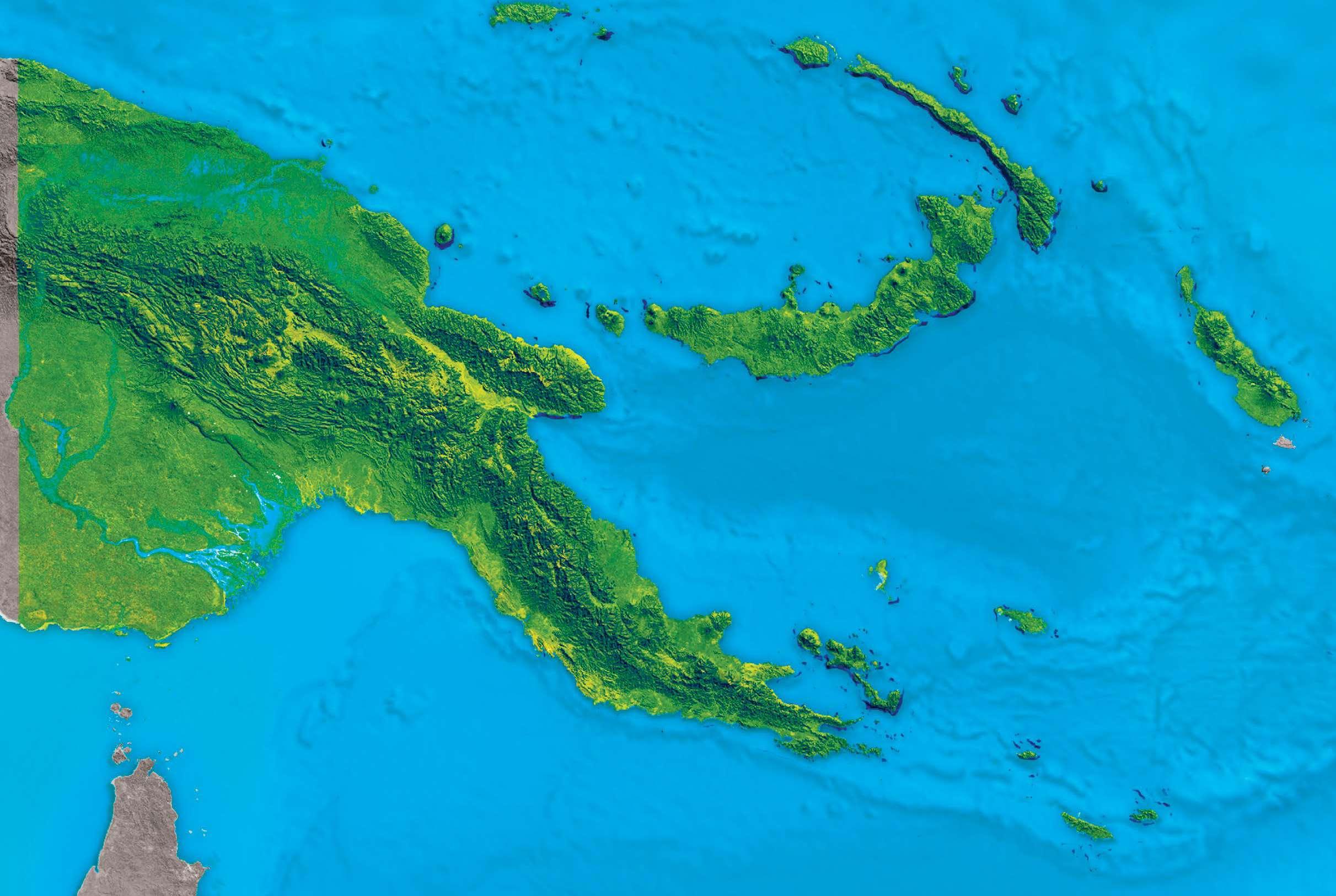























































































































































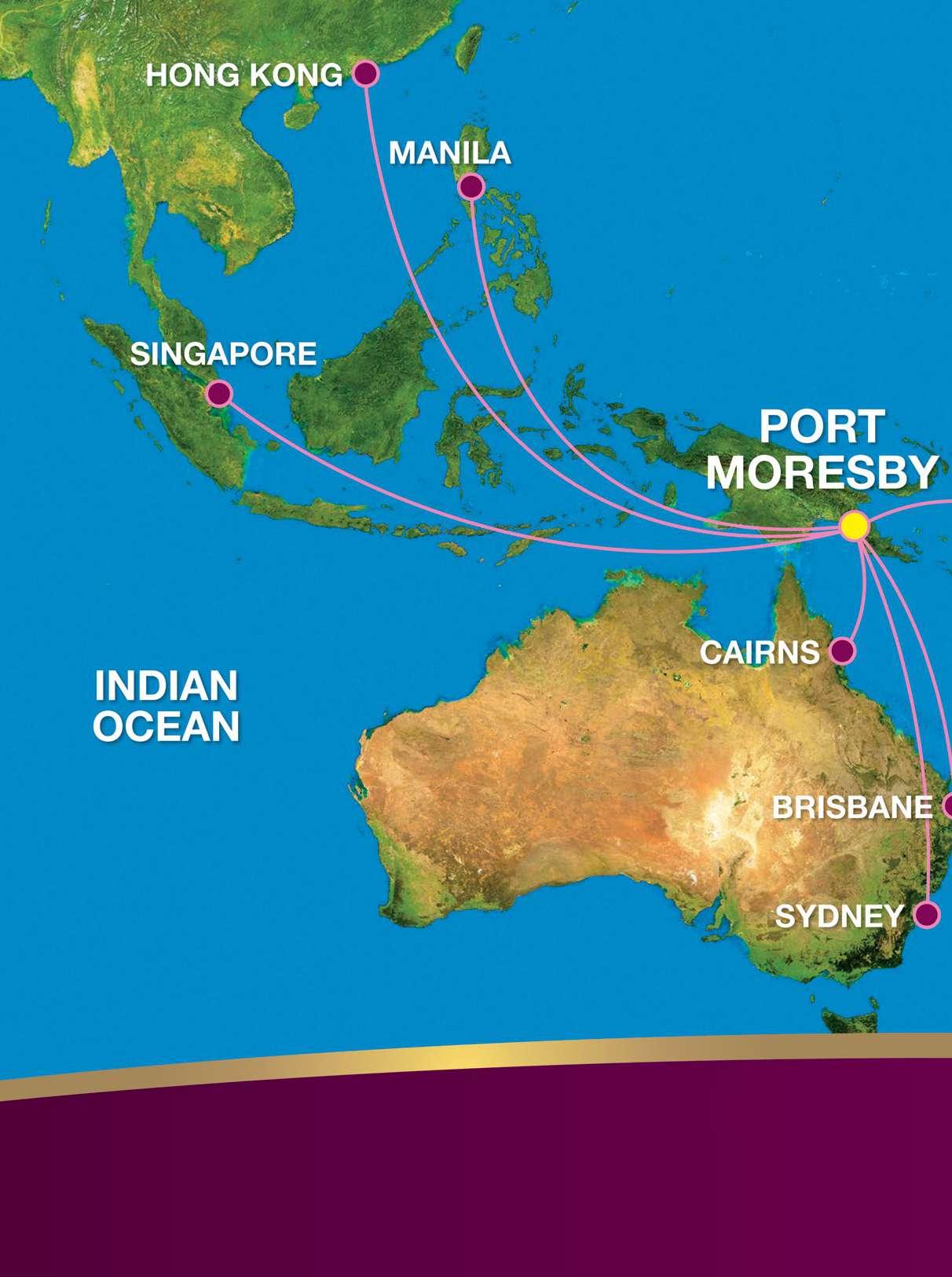
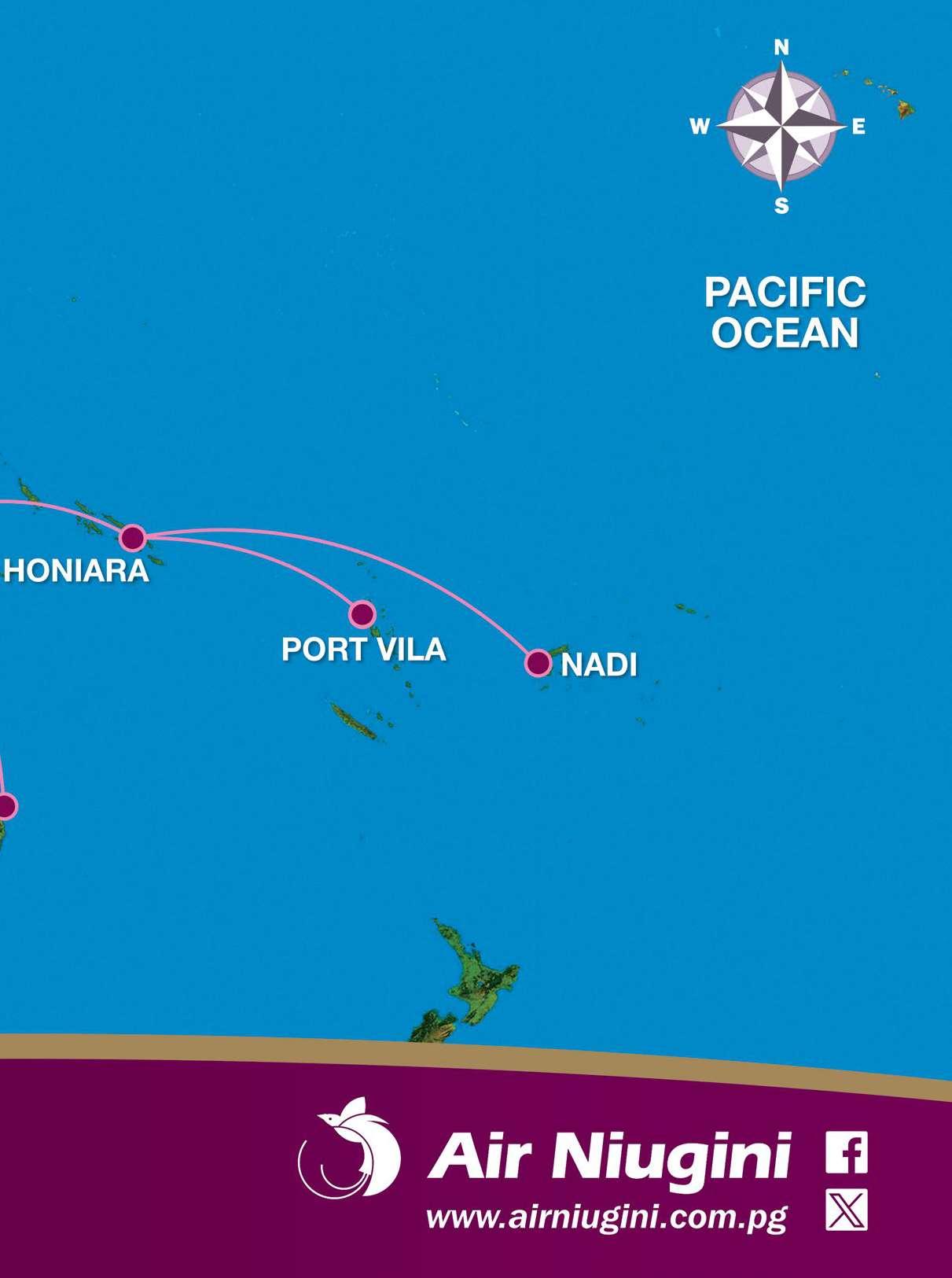
INTERNATIONAL ROUTE MAP
Your wellbeing
These exercises are designed to encourage a safe way to enjoy movement and stretch certain muscle groups that can become stiff as a result of long periods of sitting. They may be effective in increasing the body’s circulation and massaging the muscles. We recommend you do these exercises for three or
four minutes every hour and occasionally get out of your seat and walk down the aisles if conditions allow. Each exercise should be done with minimal disturbance to other passengers. None of the following should be performed if they cause pain or cannot be done with ease.


ANKLE CIRCLES
Lift feet off the floor: Draw a circle with toes, simultaneously moving one foot clockwise and the other foot counter clockwise. Reverse circles. Do each direction for 15 seconds. Repeat if desired.
KNEE LIFTS
Lift leg with knee bent while contracting your thigh muscle. Alternate legs. Repeat 20-30 times for each leg.
SHOULDER ROLL
Hunch shoulders forward, then upward, then backward, then downward using a gentle circular motion.
ARM CURL
Start with arms held high at 90° angleelbows down, hands out in front. Raise hands up to chest and back down alternating arms. Do these exercises in 30 second intervals.
KNEE TO CHEST
Bend forward slightly. Clasp hands around left knee and hug it to your chest. Hold stretch for 15 seconds. Keeping hands around knee, slowly let it down. Alternate legs. Repeat 10 times.
FORWARD FLEX
With both feet on the floor and stomach held in slowly, bend forward to walk your hands down the front of your legs towards your ankles. Hold stretch for 15 seconds and slowly sit back up.
Raise both arms straight up and over your head. With one hand grasp the wrist of the opposite hand and gently pull to one side. Hold stretch for 15 seconds. Repeat other side.
SHOULDER STRETCH
Reach right hand over left shoulder.
Place left hand behind right elbow and gently press elbow towards shoulder. Hold stretch for 15 seconds. Repeat other side.
NECK ROLL
With shoulders relaxed, drop ear to shoulder and gently roll neck forward and to the other side, holding each position about 5 seconds. Repeat 5 times.
Foot motion is in three stages.
1. Start with both heels on the floor and point feet upwards as high as you can.
floor.
3. Lift heels high, keeping balls of feet on floor. Continue these three stages with continuous motion in 30 second intervals.
FOOT PUMPS
OVERHEAD STRETCH
2. Put both feet flat on the
ADVERTISING DIRECTORY
Air Niugini
Pg119, 123 & 146
Atlas Steel Pg71
Australian - Papua New Guinea
Subnational Program Pg22, 23
Avenell
Engineering Systems Pg105
Badili Hardware Pg102
Bank of South Pacific Pg69
Barlow Industries Pg33
Bishops Pg122
Bismark Shipping Pg29
Business Advantage International Pg115
Consort Express Lines
4page special glossy
Constantinou Group Pg147
CreditBank PNG Pg2
Credit Corporation Properties Pg132
Cross Roads Transit Pg121
Crown Hotel Pg128
Datec Pg117
Duffy Cafe Pg126
Dulux Pg64
EastWest Transport Pg12
Ela Motors Pg51
ExxonMobil Pg148
Gazelle
International Hotel Pg87
Guard Dog Group Pg97
Hastings Deering Pg104
Heritage Park Hotel Pg68
Hotels Hospitality Pg103
ICTSi South Pacific Pg17

Island Mobile Hire Cars Pg81
International Education and Visa Services
Australia Pg90
International Training Institute Pg58
Jerilai Pujari
Holdings Limited Pg53
Kapi & Clarke Pg118
Kokopo Beach Bungalow Resort Pg145
Kongo Coffee Pg18
KPMG PNG Pg116
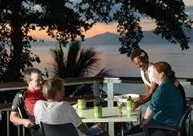
Kumul Petroleum
Holdings Ltd Pg55
Kwila Corp Ltd Pg15
Lae International Hotel Pg100
Mapai Transport Pg63
Marriot Pg62
Moni Plus Pg114
Mineral Resources Authority Pg91
Nasfund Pg4, 5
Niugini Assurance Group Pg50, 133
PAC Solutions Pg59
Pacific Energy Aviation Pg46
Pacific Palms
PropertyHarbourside Dev Ltd Pg13
Panamex Pg79
Paradise Foods Pg111
Pinhalense Pg14
Plawa Sun LtdKavieng Hotel Pg130
Plawa Sun LtdMalagan Resort Pg131
PNG Core Pg65
PNG Embroidery Pg128
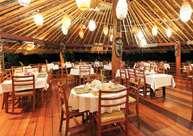

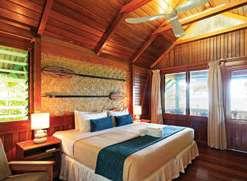
PNG Forest Products Pg39
PNG Sustainable Development Pg40, 41
Portside Pg19
Pronto Pg72
Remington Pg11
Royal Papua Yacht Club Pg60
Santos Pg31
Smarthills Pg127
Steamships Corporate Pg83
Swire Shipping Pg101
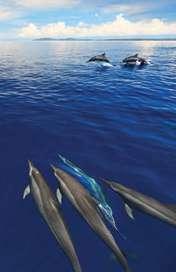
TCB Travel Pg45
Tropic Air Pg47
Trukai Industries Ltd
Pg67
Tufi Resort Pg61
Vanguard International Pg80
Vodafone PNG Pg57
Walindi Plantation Resort
Pg78
Westpac Bank Pg9
Wisdom PNG Pg86
WRC PNG Pg3

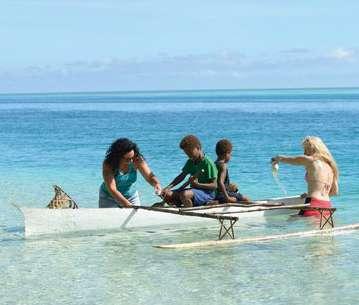



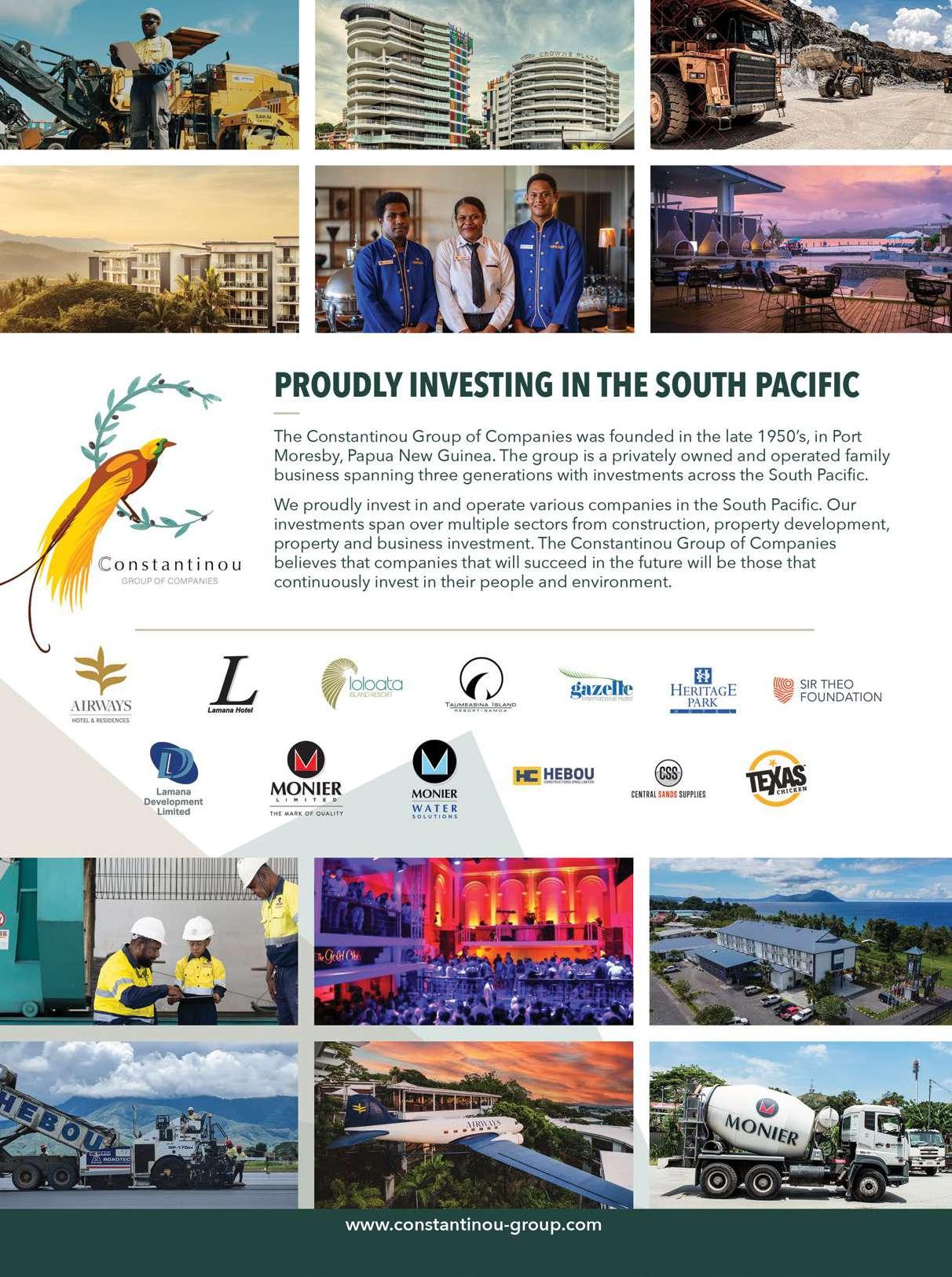
PNG LNG Revenues to the Government and people of PNG
PGK 16.27 Billion Tax Revenue Stream Amount since 2014


Distributions to Kumul Petroleum
Distributions to MRDC (Landowners)
Royalty Development Levy

Total Benefits to the State
PGK 11.06 Billion
2.23 Billion PGK 1.61 Billion PGK 1.49 Billion
*(start of production through July 2025) PGK 32.66 Billion
In its first 11 years of Production, the PNG LNG Project has contributed over 32 billion kina in total benefits to the State of Papua New Guinea.
This infographic shows the amount of revenues paid by the PNG LNG Project to the Government and people of PNG since LNG production started in 2014. All figures shown are for amounts paid or payable through July 2025.
The PNG LNG Project generates five primary revenue streams. These include equity distributions paid to Kumul Petroleum Holdings Limited (KPHL) and MRDC, which is based on the amount of equity in the PNG LNG Project held by each (KPHL – 19.4% and MRDC – 2.8%). Different types of tax including company tax are paid to the Internal Revenue Commission. In 2024, Tax payments alone to the State were over PGK 4 billion, the largest in the Project’s history. Development Levy and Royalties are paid to the Department of Petroleum and Energy in line with the Oil and Gas Act for the benefit of respective Project areas, provincial and local level governments plus landowner beneficiaries.
PNG LNG is operated by a subsidiary of ExxonMobil in co -venture with:



